Wander-Lush

World’s Best Cultural Tourism Destinations: 30 Cultural Trips to Take This Year
Discover the best cultural trips and immersive travel experiences our world has to offer. From Southern India to the High Arctic, here are the top 30 countries and regions for cultural tourism this year .
With many of us now on the lookout for deeper and more meaningful travel experiences , cultural tourism – travel that prioritises learning about and appreciating different ways of life – has never been more appealing.
Immersive cultural experiences give travellers an opportunity to see the world from a different perspective, form meaningful relationships, and develop new skills. They can also open the door to a slower, more sustainable type of travel that has benefits for local communities and a lighter impact on the planet.
Whether you’re a seasoned cultural traveller researching for your next trip or you’re interested in getting off-the-beaten-track but aren’t sure where to start, I hope this guide to culture and travel offers you some food for thought!
I also suggest reading these tips for socially responsible travel for advice about engaging with different cultures in a sensitive and mindful way.
Please note: This post contains affiliate links, meaning I may earn a commission if you make a purchase by clicking a link (at no extra cost to you). Learn more.
This post may contain sponsored links for which I received compensation.
What is cultural tourism?
Cultural travel is as broad and multifaceted as culture itself – it’s difficult to pin down, and highly subjective. For me, cultural tourism is a kind of travel that prioritises activities and experiences designed to immerse you in a way of life that differs from your own.
It might involve consuming tangible cultural products (museums, archaeological sites, food , tea ) or encountering intangible cultural elements (rituals, performances, processes). As well as art, literature, religious monuments and the like, it also encompasses ways of living, values and beliefs – both historical and contemporary.
It’s almost impossible to avoid local culture when you travel. No matter your motivation, it’s inevitable that you’ll end up experiencing some aspect of local culture, even if it’s something as simple as eating local cuisine or learning a few words of the language.
Apart from these incidental encounters, cultural tourism represents a more concerted effort to engage with local culture through specialised activities. In the same way an adventure traveller might seek out a particular hiking route, for example, a cultural traveller might plan their trip around a festival.
Cultural vacations might involve:
- Learning a new skill, for example through a cooking class or craft workshop
- Attending a local festival or event
- Participating in a ritual or ceremony
- Eating local food
- Staying with a family at a homestay
- Immersing yourself in the local community by teaching English as a foreign language
- Visiting a community-based tourism project
- Visiting World Heritage Sites and immersive museums
- Taking a locally guided tour
There’s lots more to cultural trips (as you’ll soon see), but these are some of the common elements we tend to associate with this genre of travel.
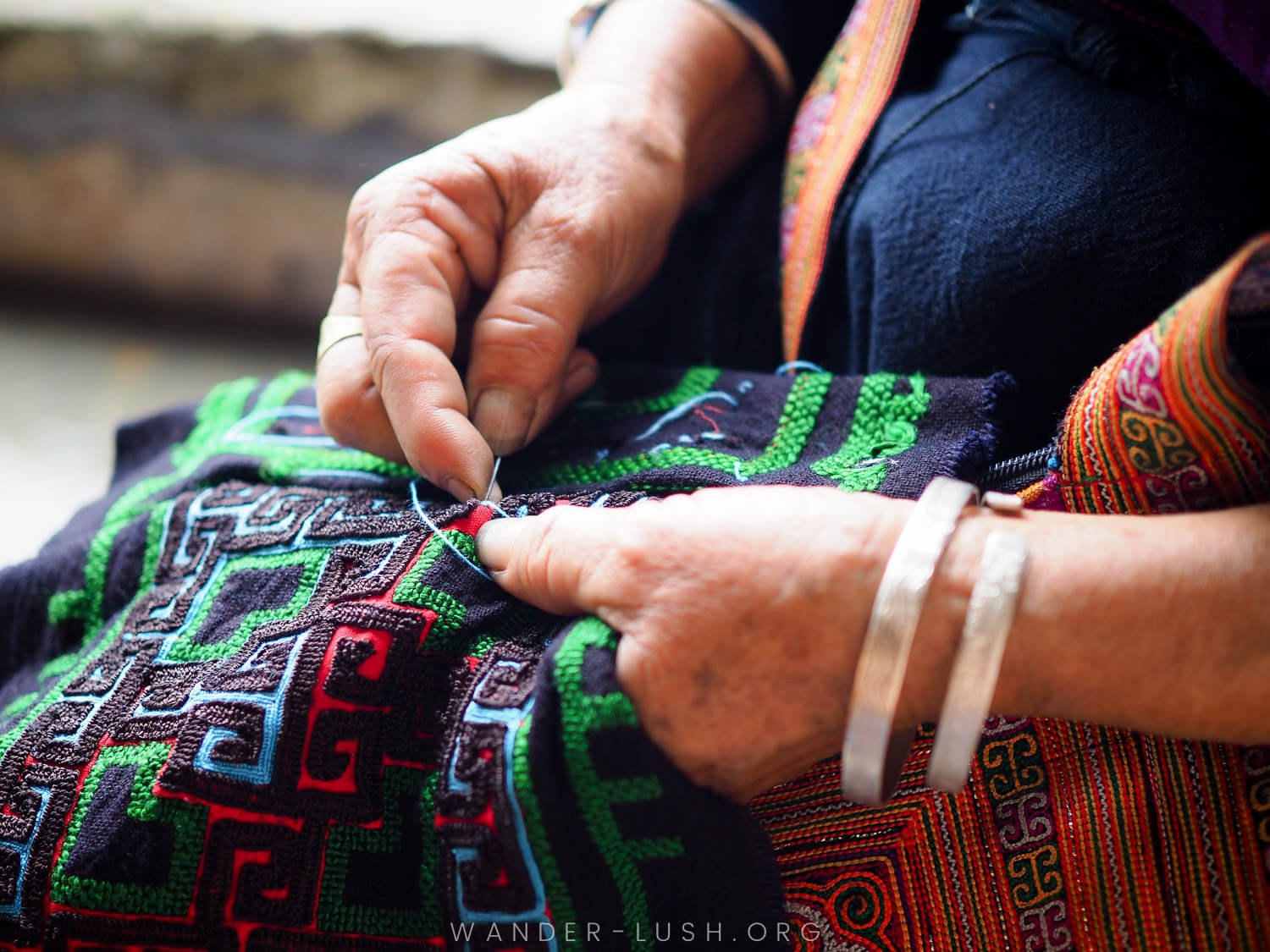
Pros and cons of cultural travel
Cultural travel is almost a guaranteed way to enrich your experience as a tourist. But it’s worth noting that this type of travel has both benefits and downsides for host communities.
Cultural tourism helps to encourage the preservation of culture and heritage by keeping endangered traditions alive. There might be little demand for heritage handicraft skills, for example, but outside interest (and an opportunity to earn an income) could be enough to safeguard a tradition that might otherwise have been lost.
By the same token, cultural tourism can incentivise better protections for physical heritage sites, ensuring that monuments and the like remain accessible for future generations. Cultural tourism can have far-reaching social impacts and environmental benefits when it gives rise to new social enterprises, local businesses and women-led ventures geared towards giving tourists an immersive experience.
On the other hand, there’s always a question mark around authenticity when it comes to cultural travel. If a ritual is performed for the benefit of outsiders, does it lose its meaning? Commodification of culture for tourism is a serious issue that impacts many communities and can be damaging to social and economic development more broadly.
Cultural tourism often involves travelling to more remote areas, which introduces a whole host of other pros and cons. A road constructed for the benefit of tourists is also new infrastructure for the community – but it might speed up globalisation and cultural erosion, while the very presence of tourists can worsen environmental pollution or cause rifts between different social groups.
These are complicated issues. Personally, I think cultural exchange is one of the most important aspects of travel and when managed properly and in a way that actively involves communities, the benefits can outweigh the drawbacks.
Top 30 countries & regions for cultural trips
There’s not a town, city, county or region in the world that doesn’t have something amazing to offer in terms of local culture. This makes it very hard to pick the ‘best’ places for cultural tourism.
However, each of these 30 hand-picked destinations stands out for its extravagant festivals and celebrations, rich cuisine and heritage handicrafts that give travellers a window on culture, heritage and the local way of life.
At the end of the list, you’ll find my top tips for having a more culturally immersive travel experience no matter where in the world you go.
Cultural destinations in the Americas
Antioquia Department, Colombia • Cuba • Ecuador • Big Island of Hawaii, USA • Orleans Parish, USA • Oaxaca, Mexico
Colombia’s Antioquia Department – for pueblos, bandeja paisa & Botero
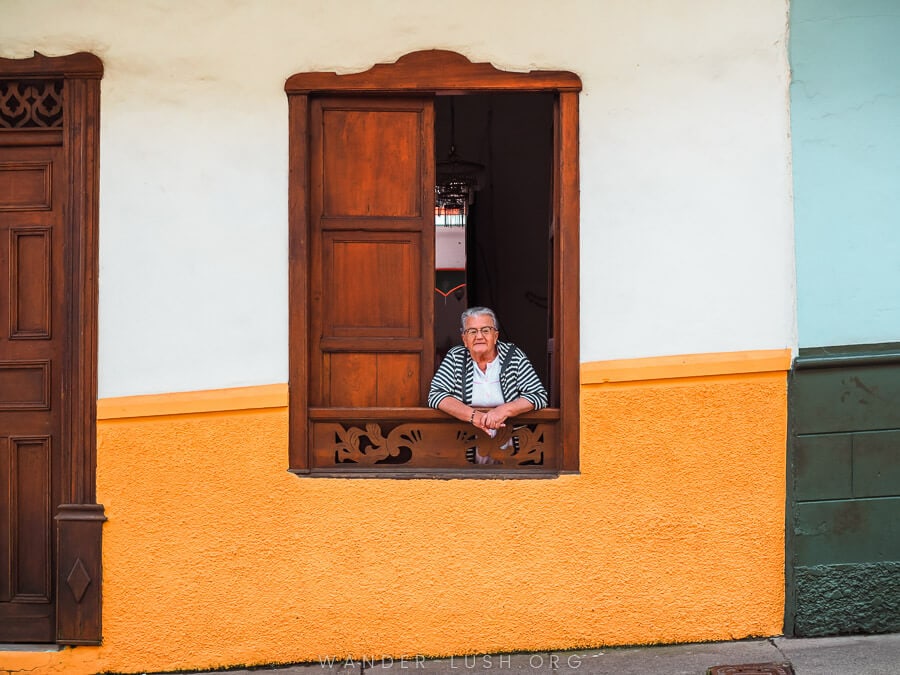
A melange of Indigenous traditions and colonial influences, there are few destinations in the world more culturally vibrant or intriguing than Colombia.
Antioquia Department in the north-west – with the city of Medellin as its capital – has become one of the most popular destinations in the country for tourists, beloved for its exquisite landscapes, colourful small towns and coffee farming heritage.
Along with several other departments, this part of Colombia is home to the Paisas , a self-defined cultural group whose name is derived from a Spanish word meaning ‘countryman’. They speak their own dialect, eat their own cuisine, and pass down their culture through a rich tradition of music and folklore.
Modern-day Antioquian culture is defined by the region’s artists, writers and poets. And then there’s the city of Medellin itself, which has undergone a huge transformation in recent years and is now considered one of the country’s main cultural hubs.
Top cultural experiences in Antioquia
Eat Paisa cuisine: One of the biggest joys of visiting Antioquia is experiencing the food scene. Paisa cuisine is heavily influenced by the topography and way of life in the Colombian Andes – carb-heavy dishes that feature beans, rice and maize are designed to fuel bodies for back-breaking work on the land. Bandeja Paisa is by far the most popular traditional dish and a must-eat in Medellin. The Antioquian version of a ploughman’s lunch, it consists of carne asada (grilled steak), chicharrón (crispy pork rind), rice and red beans served with a slice of avocado, fried plantains, a fried egg and a corn arepa on the side. It’s not for the faint hearted!
Visit a pueblo : Colombia is renowned for its small towns with colourful painted facades and pretty flower boxes. Antioquia is home to some of the loveliest pueblos in the country, including Jardin , Jericó and Santa fe de Antioquia, to name but a few. Developed during Spanish times, most follow the same basic town plan: A public square, a market, a church, and rows and rows of houses built in the region’s vernacular style. If you’re short on time, Pueblo Paisa in Medellin is a model village in the heart of the capital.
Shop at the San Alejo Handicraft Market: If you happen to be visiting Medellin on the first Saturday of the month, don’t miss this unique opportunity to see Colombia’s handicraft traditions on display. Vendors from across the region descend on the city to sell traditional products, including woven Wayuu bags, and artisanal foods. You can chat to the vendors and watch live demonstrations to see how these Indigenous handicrafts are produced.
Visit Comuna 13: A locally guided tour of Medellin’s Comuna 13 will allow you to delve into the city’s tumultuous recent past in a respectful and mindful way. This collection of once-notorious city neighbourhoods has become a symbol for the nation’s transformation and cultural revitalisation. Street art, music and other expressions of local creativity are all on display for visitors to enjoy.
Cuba – for Mambo, classic cars & casas particulares
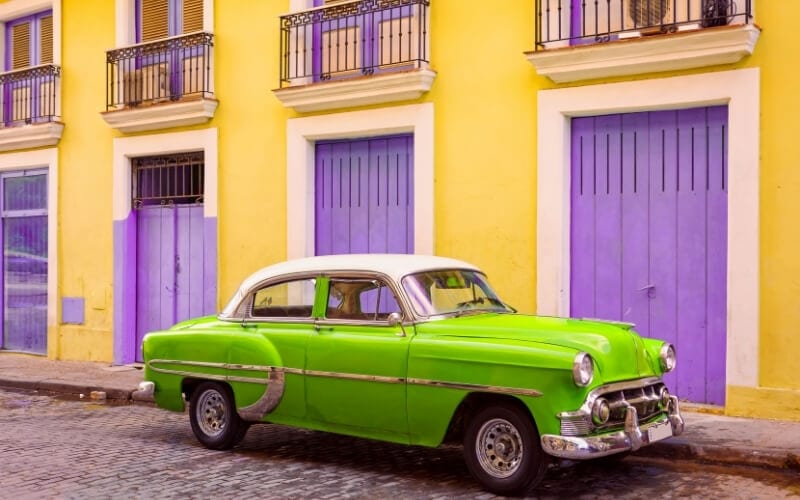
The native Taino Indians called their beautiful island Cubanacán. When the Spaniards arrived in 1511, they shortened it to ‘Cuba’ and claimed it for Spain, labelling it “the most beautiful land human eyes have ever beheld.”
Ethnically, the country is a vibrant mix of Europeans, Africans brought over as enslaved workers throughout the 1700s, and a large group of Chinese imported as indentured servants. Sadly, the original inhabitants have largely disappeared.
On December 31, 1959 the Cuban Revolution succeeded in converting the country into a communist nation. Since then – and due to the mutually adversarial relationship with the United States – the island nation has existed in semi-isolation, frozen in time.
The cars that roam the streets are the same classic American models from the 1950s, and the frequently crumbling buildings have enjoyed little renovation.
Despite Cuba’s trying history, the spirit of the people lives on and in its rich and celebrated culture. Before you go, learn the dos and don’t of visiting Cuba .
Top cultural experiences in Cuba
Dance the night away at a musical venue: Cuba is the birthplace of dozens of musical genres including Mambo, Cha-Cha-Cha and Afro-Cuban Jazz. These Afro-European genres have contributed and enriched music categories around the world. Be sure to experience one of Cuba’s world-famous carnivals and Jazz Festivals.
Overdose on art and architecture: With nine UNESCO World Heritage sites and an amazing collection of museums, Cuba is a culture vulture’s paradise. Most are found in the capital city of Havana, but you also find little gems in the second city, Santiago de Cuba, and the perfectly preserved colonial city of Trinidad. Cuba’s architecture ranges from Spanish colonial and French Baroque to 1920s Art Deco. Visit the Museum of Fine Arts in Havana and the Bacardi Museum in Santiago to start; but don’t miss the quirky Rum Museum or the delectable Museum of Chocolate either.
Stay at a Cuban homestay: These Airbnb-type experiences are called ‘ casas particulares ‘. This is your opportunity to live with a Cuban family and delve into the culture.
Go hiking: Cuba’s national parks, biosphere reserves and 1,500 miles (2,400km) of coastline provide an opportunity to experience the outdoor culture.
By Talek from Travels With Talek
Ecuador – for jungle homestays, festivals & colada morada

A country with just over 17 million people, Ecuador is an extremely culturally diverse nation and a cultural tourism destination that should not to be overlooked.
Retaining a strong influence from Spanish colonisation, with widely-celebrated Catholic festivals and traditions, there is also a diverse mix of Andean Indigenous groups and traditions that dominate the mountainous centre of the country. In the east, the influence of various Amazonian Indigenous groups and their traditions is strong.
The coast of Ecuador, meanwhile, is marked by African influence from the cultures of enslaved peoples brought during colonisation.
With such a diversity of cultures – each with their own festivals, traditional foods and more – there are plenty of immersive experiences to partake in across the country that make a trip to Ecuador a must for any cultural traveller.
Top cultural experiences in Ecuador
Visit a remote community in the Amazon rainforest: One of the most popular and fascinating cultural experiences for travellers to Ecuador is to visit an Indigenous community to learn about and experience the rich traditions. Even a jungle tour of the Amazon on a budget can be tailored to include a visit to an Indigenous community, where you’ll learn to make traditional dishes and beverages such as chicha . Tribes deeper in the Amazon that welcome visitors often offer more in-depth cultural experiences including homestays, ritual cleansings, or even ayahuasa retreats.
Celebrate Easter in Ecuador: In addition to the Indigenous traditions in Ecuador, there are many popular celebrations from the Catholic tradition that travellers can partake in. Easter celebrations during Holy Week include Quito’s parade, known as the Procesión Jesús del Gran Poder, which features thousands of purple-hooded devotes carrying crosses and statues. Make sure you enjoy a bowl of traditional Fanesca , a rich and creamy soup made with 12 grains representing the 12 Disciples.
Dress up for Día de los Difuntos : Another cultural celebration with Indigenous roots is the Día de los Difuntos or ‘Day of the Deceased’, marked on November 2nd. Ecuador celebrates by honouring the dead and visiting cemeteries. Celebrations also include preparing and eating guaguas de pan , bread in the shape of a baby filled with fruit jam, and drinking colada morada , a thick, sweet drink made with berries and fruit and thickened with blue corn flour before being served warm. These delicious treats are sold in bakeries across the country for at least a month prior to the festivities. The largest celebrations are held in Indigenous communities such as Otavalo in Northern Ecuador.
By Carley from Home to Havana
The Big Island of Hawaii – for palm weaving, stargazing & petroglyphs
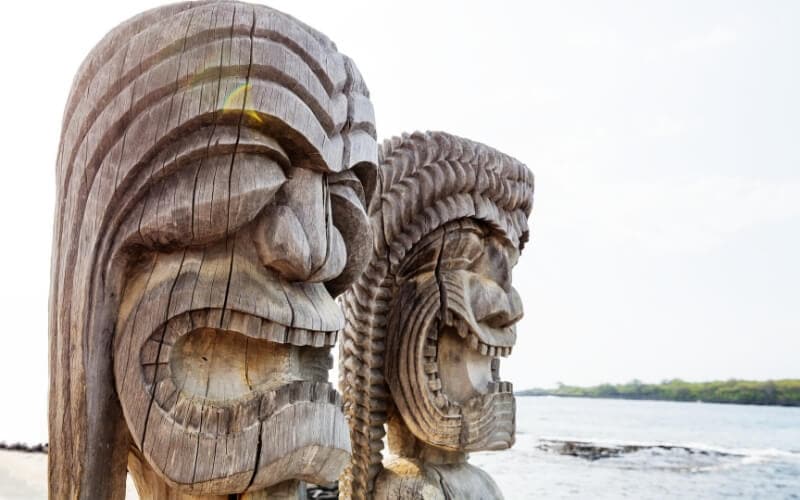
The natural abundance of the Big Island of Hawaii, the largest island in the Hawaiian archipelago, is nothing short of spectacular. With eight different climate zones, three active volcanoes, and the most mesmerising waterfalls and beaches in different shades, there’s a wealth of diversity to explore on the Big Island .
This unique natural setting is also home to several important cultural sites. After all, this is the Hawaiian island where the first Polynesian settlers arrived, where the first ruler of the Kingdom of Hawaii, King Kamehameha the Great, was born, and where the European explorers first arrived.
With such a rich heritage, it comes as no surprise that Hawaiian culture is still very much alive on the Big Island. Here are some experiences that allow you to explore the island’s heritage.
Top cultural experiences on the Big Island of Hawaii
Take a self-guided tour of the Pu’uhonua o Hōnaunau National Historical Park: Just south of Kailua-Kona, there’s a site where the royal family and their warriors once lived. It’s very well preserved and you can still see the thatched huts, an ancient temple, wooden carvings and fishponds. But this site was more than just a royal retreat: When Hawaiians broke the law or kapu , they were condemned to death. The only option to escape their fate was reaching this sanctuary, known as the Place of Refuge. You can visit this intriguing site on a self-guided tour.
Learn the traditional Hawaiian art of weaving palm fronds: In the Hawaiian craft known as lau niu , the leaves of the coconut palm were used to thatch roofs, create baskets and even hats. There’s a handful of workshops where you can learn this traditional craft from a professional weaver. Not only does it make for a unique experience, it also allows you to craft your own handmade Hawaiian souvenir.
Go stargazing at Maunakea: In Hawaiian culture, the dormant Maunakea volcano, with its unique alpine Lake Waiau, is considered sacred. They believed the summit to be the realm of the gods and the meeting place of earth and sky. To this day, cultural rituals are performed on the slopes of Maunakea. This intriguing volcano is home to the world’s largest astronomical observatory, the Onizuka Center for International Astronomy, which hosts a regular stargazing program.
Check out the Hawaiian petroglyphs: Hawaiian petroglyphs tell the stories of ancient times and give a unique inside into the different cultural beliefs on the islands. You can find carvings of canoes, turtles, babies and more at one of the petroglyph sites that dot the Big Island, such as the Puuloa Petroglyph site in Hawaii Volcanoes National Park or the Puako Petroglyph Archaeological Preserve near the Mauna Lani Resort.
Conquer the ocean in an outrigger canoe: Step aboard a double-hull outrigger canoe and explore the shore in the same way the Polynesian settlers did centuries ago. This type of canoe features lateral support floats or outriggers fastened to one or to both sides of the hull. Learn how to paddle and work as a team as you glide along the Kona reefs teeming with fish. If you’re lucky, you might even spot a pod of dolphins.
By Sarah from CosmopoliClan
Orleans Parish – for jazz, Madi Gras & creole cooking
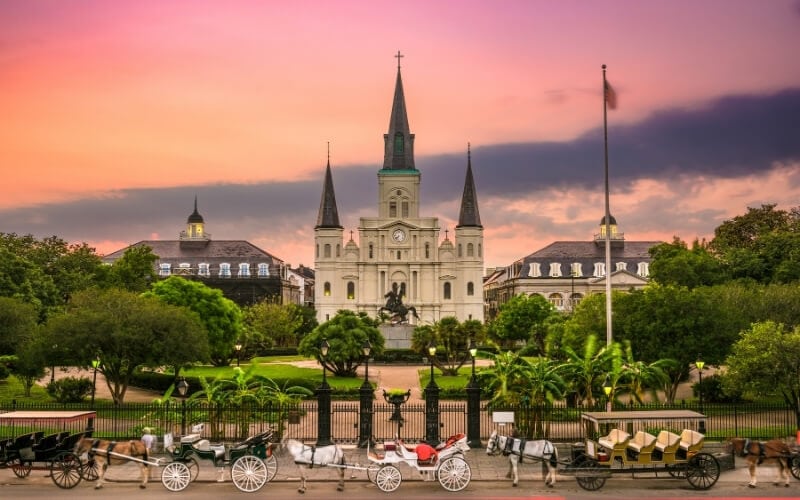
When it comes to cultural destinations, few cities have as much to offer as New Orleans and the surrounding parishes. Located in Southeastern USA, New Orleans is all about tradition and culture. The city’s unique heritage comes from a blend of French, Spanish, Cajun, and Creole cultures.
Combined, these groups have given birth to something truly iconic. The beautiful Mardi Gras celebrations are a remnant of the French colonial era, while the beautiful Spanish colonial architecture in Jackson Square is worthy of a walking tour .
You will also find unique Cajun cuisine served in the city’s most popular restaurants. Add in the many historical museums, southern plantation homes, and distinct architectural styles and Orleans Parish makes for the ultimate cultural destination in the US.
Top cultural experiences in New Orleans
Join a Mardi Gras parade: New Orleans is well-known for its lavish and grand Mardi Gras parades and balls. Visitors can enjoy the festivities for an entire month in the lead up to the big day. Outside of Mardi Gras, there are plenty of other festivals in New Orleans to check out as well.
Listen to jazz: New Orleans is the birthplace of jazz. The city’s Creole population gathered and celebrated in the city’s Congo Square on Sundays and thus jazz was born!
Tour a plantation home: Many southern plantation homes are located along the banks of the Mississippi. These can be seen on a road trip along the Great River Road. On a tour, you will learn about pre-Civil war life in the South and the history of slavery. Learn more about the ethics of visiting plantation homes here .
By Ketki from Dotted Globe
Oaxaca – for Indigenous cuisine, Zapotec rugs & mezcal
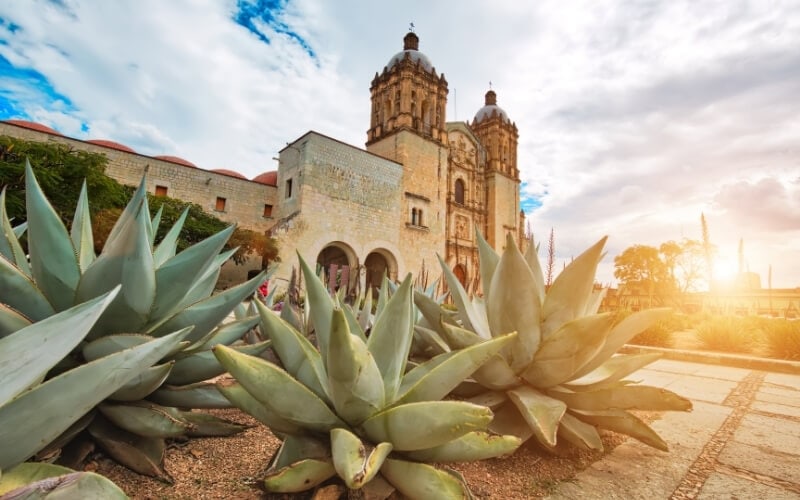
The state of Oaxaca is a cultural hub in Mexico. Void of resorts or even big-name hotel chains, Oaxaca is rich in flavourful cuisine, celebrations, and Indigenous revitalisation.
Located in southern Mexico, Oaxaca features a variety of different landscapes, from lush hills and forests, to dry arid deserts and blissful beaches. However, the community atmosphere of Oaxaca is what keeps people coming back, both international visitors and Mexican residents alike.
Oaxaca is known as the food capital of Mexico, with dozens of celebrity chefs. Notably, Indigenous culture is very visible in Oaxaca, with 16 recognised Indigenous groups in the state. Zapotec weaving is one of the most sought-after souvenirs in the area – and Mexico in general – and it comes from Oaxaca.
Top cultural experiences in Oaxaca
Celebrate Dia de los Muertos : Oaxaca City is a top destination for Dia de los Muertos (Day of the Dead), with its dazzling parades, intricate family altars and abundant festivities. Dia de los Muertos is a pre-Columbian tradition that honours deceased loved ones with food, drink, and merriment. So, if you happen to visit Oaxaca during a festival like Dia de los Muertos, bring comfortable shoes for fun activities throughout the day. Oaxaca City is an extremely walkable city, and you will want to explore every inch of its mural lined walls.
Eat Oaxacan cuisine: Since Oaxacan cuisine is also central to the region’s identity, sign up for a food tour with a local to learn the origins of some of the most popular dishes and what makes Oaxacan food and flavour so unique and different from other states in Mexico. Or, if you want to take a more hands-on approach, take a cooking class with a world-class chef at Casa de los Sabores and learn how to make mole and other Oaxacan staples.
Visit a Zapotec village: If you’d prefer to focus on Indigenous cuisine, take a day trip out to the Zapotec village of Teotitlán del Valle for a cooking class at El Sabor Zapoteco . After you finish, there are many things to do in Teotitlán del Valle , but you will probably want to get your fill of shopping at the many boutique shops for best quality Zapotec rugs.
Drink mezcal: If you’re a fan of hard drinks, Oaxaca is a great destination for mezcal tasting! Hop on any tour and view the vast agave fields as you taste mezcal throughout the day. Depending on the season, you may even get to try your hand at using the harvesting machete!
By Kay from The Awkward Traveller
Learn more: A local’s guide to the best of Mexican culture and an in-depth guide to Mayan culture in the Yucatan .
Cultural travel destinations in Europe
French Basque Country • Armenia • Sicily • Greece • Bosnia & Herzegovina • Russia • Northern Europe’s Arctic Regions • The Greater Caucasus • Andalusia, Spain
French Basque Country – for frontons , fêtes & espadrilles

The Basque country at the southwestern-most tip of France is one of those regions you might not guess is French – at least not at first.
The half-timbered houses are painted oxblood or green, and the Euskara (Basque) language, Europe’s oldest, is related to no other tongue. The Basques are also among the oldest ethnic groups of Europe.
Basque culture is unique and is spread among seven provinces, of which three are in France (the other four are in Spain). The Basques have their own festivals, music and dances, their own foods, games and folklore, as well as an acute sense of history and heritage.
Top cultural experiences in French Basque Country
Here are just a few cultural experiences to whet your appetite for all things Basque!
Gastronomy: The food is different from your regular French fare. For example, the Espelette pimento is spicier than seasonings you’ll find elsewhere in France, and food itself is taken to new heights here – the region has the highest number of Michelin stars per capita in the world. And let’s not forget the pintxo , the Basque equivalent of the Spanish tapas.
Fronton s: You’ll find one of these walls in every Basque village – it’s what Basques use to play their national sport, Basque pelota (known in some countries as jai alai). It’s played with a racquet-like bat which scoops up the ball. Then, a bit like squash, the players fling it back and forth against the wall, or fronton.
Family-owned businesses: Basque artisanal traditions run deep, whether it’s leatherwork, espadrilles, Basque linen or beret making. This is a region in which hand-made goods thrive and where mass-production takes a back seat. The local government makes sure family businesses are promoted and Basque know-how exported, however stiff the competition – there are special labels for family businesses, and even labels for those businesses that have been around for more than a century (and there are plenty). As a result, hand-made goods from this small region find their way around the world, symbolising not only Basque savvy but Basque determination to hang on to its heritage.
Bayonne Festival: With its one million annual participants, the Fêtes de Bayonne is France’s largest festival. It was ‘borrowed’ in 1932 from not-too-distant Pamplona in Spain, but has grown immeasurably since. Each July, visitors dress up in white clothes and red scarves (and a red beret, of course) and spend five days eating, drinking, singing Basque songs and watching Basque sports. The Festival includes bullfighting, which has a long tradition in the region, although this particular sport might be short-lived given the growing opposition to it.
By Leyla from Offbeat France
Bosnia & Herzegovina – for old bazaars, woodcarving & kahva
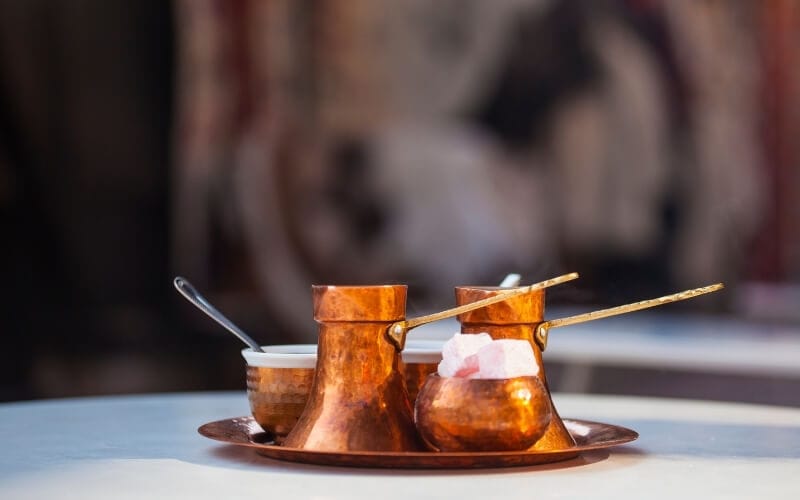
Bosnia and Herzegovina is one of the most culturally and ethnically diverse countries in the Balkans . If you have your sights set on this lesser-visited part of Europe for your next cultural trip, it’s the perfect setting to learn about the region’s different – often competing – influences and how they’ve shaped modern life.
Bosnia is the original cultural melting pot, and Sarajevo is where it all comes to a head. The city is divided into two parts – Ottoman and European – with the sprawling Old Bazaar on one side, and the Austro-Hungarian planned portion of the capital on the other. A plaque on the pavement marks the spot where East Meets West.
But the boundaries aren’t always that clear. Bosnia and Herzegovina’s character is a combination of Bosnian, Serb and Croat, layered with Jewish, Romanian, Albanian and Turkish traditions. The vignette of a mosque’s minaret and a church bell tower rising up side by side is a perfect motif for the country’s diversity.
Top cultural experiences in Bosnia & Herzegovina
Explore Sarajevo’s Old Bazaar: One of the most beautiful Ottoman bazaars in the region (and there are a lot), just wandering the rows of picturesque wooden shops connected by cobbled streets – the sound of coppersmiths beating intricate designs onto plates ringing in your ears – is a completely immersive experience. At the kafane coffeehouses, where kahva and rakia are served with much pageantry, you get a feel for famous Bosnian hospitality.
Take a food tour of Sarajevo: Bosnians are fiercely proud of their national cuisine. Dishes such as burek (filled savoury pastry) and cevapi are a common ground and bring the country together. A food tour of Sarajevo takes you behind the scenes on some of the city’s liveliest markets and busiest restaurants while giving you an insight into the history behind some of the country’s most iconic dishes.
Visit a woodcarving master in Konjic: Sarajevo in particular has an incredibly rich art and literature scene, as evidenced in the many festivals that take place in the city throughout the year. Bosnia’s heritage handicrafts shine a light on the culture of craftsmanship that has bestowed the country with so many beautiful landmarks over the years. Woodcarving has been practiced for generations in the city of Konjic and today, visitors can tour the masters’ workshops for an up-close encounter.
See the Stećci Medieval Tombstone Graveyards: Stećci medieval tombstones were laid during the time of the Bosnian Kingdom. Recognised as a UNESCO World Heritage Site, they’re found throughout the territory including in forests close to the border with Serbia . Carved from limestone, the Stećci contain motifs and inscriptions and provide a rare window onto this epoch of the country’s history that’s still shrouded in much mystery.
Greece – for markets, mythology & Orthodox Easter
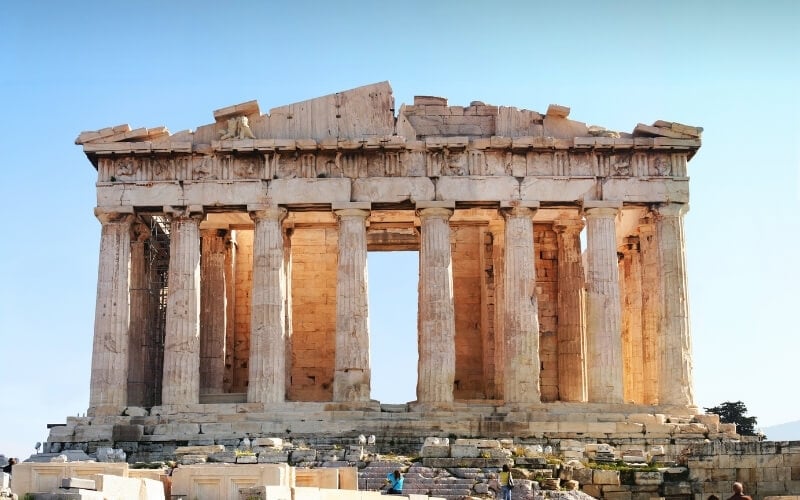
Greece is a country rich in culture, from the legacy of ancient history and mythology to traditional cuisine and celebratory festivals that still bring people together to this day. Greek nationals tend to be very proud of their history and culture , which can be seen in the well-executed museums, galleries and archaeological sites throughout the country.
Believed to be the ‘birthplace of Western civilisation’, Greece is known for its scholars, medics, architects, philosophers and politicians that shaped the way the world works today. This makes the country an excellent choice for cultural tourism as there are simply so many things to see and do that will both satiate your wanderlust while also teaching you new things.
Whether you’re interested in archaeological excavations, gastronomic tours, local festivals or ancient architecture, Greece certainly has you covered.
Top cultural experiences in Greece
Take a Mythology Tour of Ancient Athens: Athens has a whole host of archaeological sites to explore , from the Ancient Agora and Hadrian’s Library to the world-famous Acropolis and Parthenon perched on a hillside overlooking the city. One of the best ways to discover these sites is via a Mythology Tour that takes you around the best historic monuments and ruins while also giving you interesting information about the city and country’s history and mythology. This tour , suitable for all ages, gives you skip-the-line access to some of Athens’ most important landmarks along with an experienced guide to give you detailed history about how Greece became the centre of the world.
Visit the Athens Central Market: If your idea of cultural tourism involves food, you might be interested in a trip to the Athens Central Market and a local cookery class. A gastronomic experience allows you to soak up the sights and smells of the city’s biggest market, picking up local produce and souvenirs while also trying some tasty titbits along the way . You’ll then take your purchases back to the kitchen where you’ll cook up a storm using local recipes and techniques. Try classics like Dolmades (stuffed vine leaves), Tzatziki and Spanakopita (spinach and feta pies) to give you a real taste of traditional Greek cuisine.
Attend the Epidaurus Festival: The Ancient Theatre of Epidaurus, a grand amphitheatre located on the bank of the Acropolis Complex, runs an annual summer festival of art. The festival combines modern and traditional music, theatre and dance with the picturesque Ancient Greek setting, making it a real highlight for any traveller. Over the years, the Epidaurus festival has played host to names like Frank Sinatra, Maria Callas and Luciano Pavarotti.
Celebrate Orthodox Easter in Greece: Easter is one of the biggest traditional festivals on the Orthodox calendar, so no matter where you are in Greece during this time, you’re sure to come across some pretty exciting celebrations! One destination that always enjoys epic Easter festivities is the island of Corfu. Local Easter traditions begin on Palm Sunday (a week before Easter) and there are different festivities each day leading up to the main event.
Palm Sunday sees a large procession of the Holy Shrine; Monday, Tuesday and Wednesday see locals preparing their Easter meals and sweet specialities, going to evening ceremonies and lighting up the town with lanterns; Maundy Thursday is egg-painting day; Good Friday features the mournful marches of the philharmonic orchestra and the procession of epitaphs; Good Saturday features an artificial earthquake(!), bell ringing, the throwing of clay pots and tossing coins into a barrel; and the whole week culminates on Easter Sunday with a celebration of the Resurrection of Christ – fireworks, marches, music and traditional family meals galore!
By Chrysoula from Athens and Beyond
Learn more: 7 awesome cultural activities in Athens .
Russia – for ballet, banyas & borscht
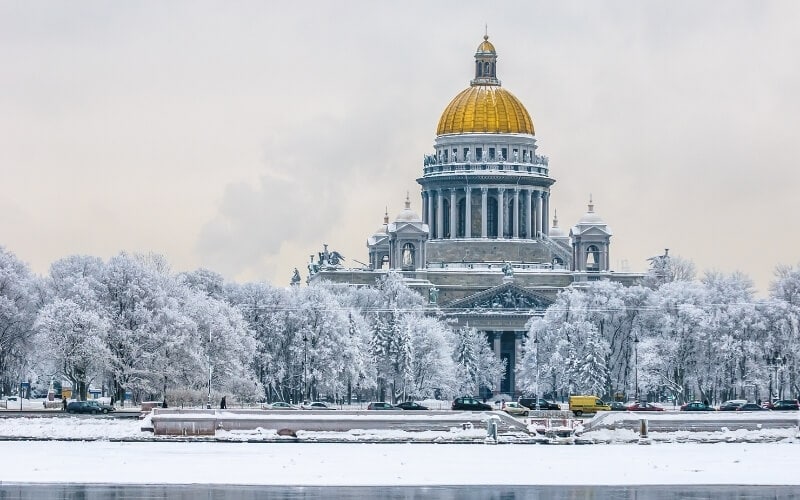
While many may think of Russia as cold and grey, this could not be further from the truth. From the famous colourful onion domes of St. Basil’s Cathedral to the gilded fountains of the Peterhof Palace, Russia’s beauty is undeniable.
Russia is also a country rich in culture and filled with literature, ballet, painting and classical music.
Top cultural experiences in Russia
To really delve into Russian culture, there are a few experiences you should have whilst here.
Experience a Russian banya : One of the best cultural experiences you can have in Russia is to visit a banya . A banya is similar to a sauna. The biggest difference, though, is that a banya has high levels of humidity, while a sauna usually has dry air. They’ve been a part of Russian life for over a thousand years! You wear funny felt hats to protect your hair and ears from the heat. This also helps to regulate your body temperature, so you are able to sit in the banya for a longer period of time.
Another interesting aspect of the Russian banya is ‘flogging’ using birch twigs ( venik ). This is supposed to benefit your health and improve your immune system, and honestly, if you have someone who knows what they are doing, it does feel really good!
After you’ve gone in and out of the banya a couple times, you then cool yourself off by taking a quick, cold shower, jumping into a cold pool or tub (banyas do have these), jumping into a snowbank (seriously). Or… You can just jump in a frozen lake!
See a ballet at the Bolshoi: Seeing a ballet at the Bolshoi Theatre is one of the best things to do in Moscow and all of Russia in general. Even though ballet did not originate in Russia, Russian ballet is world-renowned, and the locals are incredibly proud of the tradition. If you can, try to see a performance of The Nutcracker or Swan Lake on the historic stage. Tickets sell out very quickly, so don’t delay in purchasing them once they go on sale!
Experience NYE: New Year’s Eve is the biggest holiday in Russia. This is because Christmas was forbidden during the Soviet years. Many traditions were moved from Christmas to the New Year, including keeping presents under the Christmas tree and visits from the Russian equivalent of Santa. Celebrations and fireworks take place across the country on December 31 – the biggest and most famous displays are in Moscow’s Red Square and Gorky Park.
Sample Russian cuisine: No trip to Russia would be complete without experiencing the local cuisine. The best Russian food and drinks to sample on your visit are: Pelmeni (a Russian dumpling filled with meat and usually topped with sour cream); borscht (a traditional Russian soup whose main ingredient is beetroot); beef stroganoff (a Russian dish made with sautéed beef in a sauce with smetana ); syrniki (essentially a cottage cheese pancake topped with jam or sour cream – SO good!); kvass (a fermented beverage made from rye bread); and caviar and vodka (alas, you can’t come to Russia and not try caviar and vodka!)
By Lindsey from Have Clothes, Will Travel
Northern Europe’s Arctic Regions – for reindeer & Sami traditions

In Europe’s high northern reaches, you will find one of the continent’s oldest and most distinct cultures, the Sami. Spread across the Arctic regions of Norway, Sweden, Finland, and Russia, the Sami are Indigenous people who have traditionally led a nomadic lifestyle, known for herding their reindeer between their summer and winter feeding grounds.
The origins of the Sami are largely unknown, and it is believed that they once inhabited grounds much further south. But years of persecution drove them north and forced them to decrease livestock numbers in order to maintain their way of life.
Against all odds, they have managed to hold onto large parts of their culture, including languages, traditions and ceremonies. As the modern world has encroached further north, there have been clashes over natural resources and land, which has put the plight of the Sami at the forefront of people’s minds in recent years and led to movements to protect the people and the culture.
Top cultural experiences in the Arctic regions
Head to Tromso for an immersive Sami experience: Today, there are plenty of ways you can learn about and experience Sami culture. During the winter months, there are many Sami experiences in Tromsø, Norway and beyond where you can educate yourself about the Sami way of life, hear stories that have been passed down through the generations, and eat traditional foods.
Shop at a Sami market: Keep an eye out for Sami markets where you can purchase handmade traditional items.
Participate in a Sami festival: Norway is known to have the largest festivals and in various Arctic cities, you will find Sami festivals on National Sami Day (February 6th). In the summer, there are also Sami music festivals, such as the one found near Murmansk in Russia.
A visit to Northern Europe’s Arctic region is one of the most meaningful cultural trips in Europe as it helps bring attention to a group of people who have spent many years marginalised in their respective modern-day societies.
By Megan from Megan Starr
Andalusia – for Moorish architecture, tapas & Flamenco

Andalusia is an autonomous region in Southern Spain, geographically bounded by Spain’s southern coast. It’s culturally vibrant and very distinctive when compared to other parts of Spain such as Catalunya.
This part of the country was ruled by the Moors for centuries, and Moorish influence is evident in the cuisine, architecture and culture. Seville, Cordoba and Granada are all among the best Spain city breaks and each serve as a good base for exploring more of the region.
Top cultural experiences in Andalusia
Marvel at the Moorish architecture: The Andalusian architecture will capture your attention as soon as you land there, and this is probably the easiest way to start digging into the region’s past and cultural evolution. Cities like Seville and Granada have major UNESCO sites that will blow your mind – the style is in no way similar to buildings in France or even northern Spain for that matter. Islamic calligraphy and intricate details are most evident at the Real Alcazar Palace in Seville, the Alhambra in Granada , and the Mezquita in Cordoba.
Go tapas hopping: People in Andalusia are known for being a more little laid back, and generally enjoy food, family and companionship. Popular ‘tapas hopping’ is best experienced in Andalusia. Tapas bars in the south cultivate a cosy atmosphere with rounds of $1 dollar beers, spinach and chickpeas, cheese, and churros. Moorish/Muslim influence can be seen in the preparation of some foods, especially marzipan, and in the use of herbs and spices such as cumin and cilantro.
Watch a Flamenco performance: After food, flamenco is what defines Andalusia. Flamenco is a dance that is synonymous with Southern Spain and is one of the most energetic and passionate forms of dance/storytelling. Flamenco shows in Seville and other cities in Andalusia are a great way to understand and enjoy this side of Southern Spanish culture.
By Mayuri from To Some Place New
Cultural tourism destinations in the Asia Pacific
Central Australia • Timor-Leste • Sarawak, Malaysia • Cambodia • Japan • Bhutan • Kerala, India • Rajasthan, India • Uzbekistan • The Tibetan Plateau • Taiwan
Central Australia – for ancient landscapes, ochre & bush tucker

The Arrernte and Anangu people have lived in Central Australia for over 20,000 years. From Uluru and Kata Tjuta (the Olgas) to the MacDonnell Ranges and Alice Springs, they have made their home in one of Australia’s driest and hottest regions.
The landscape, its plants and animals permeate every aspect of their culture. The natural environment is the basis for the Creation (or Dreamtime) stories at the core of their beliefs, ceremonies and traditions.
Their relationship with the land also has a practical aspect as a source of food, shelter and medicine. The Arrernte and Anangu’s land management techniques, native foods and art have all found their ways into broader Australian life.
Today, members of the communities have roles as guides, ranges and managers of major tourism businesses. For travellers, there are many opportunities to appreciate the on-going connection the Arrernte and Anangu people have with the Central Australian landscape.
Top cultural experiences in Central Australia
Visit Uluru (Ayres Rock): You can’t go to Central Australia and not visit Uluru. It is an iconic Australian landmark and when you visit this enormous rock, you’ll find many ways to immerse yourself in Indigenous culture. At Yulara Resort you can join a free session to learn about Indigenous food, crafts and didgeridoo playing.
On your way to Uluru, stop at the Cultural Centre. There are ranger talks about the area’s wildlife, how the Anagu have lived in the area for thousands of years, and how that knowledge is used to manage the park today. There are also galleries featuring local art and craft. For something a bit different, try a Segway tour of the rock . As you cruise around the 10 km base, you get a wonderful explanation of the Creation Stories tied to many of the rock’s features, caves and waterholes.
Ochre Pits: Ochre is a natural clay that comes in a range of colours and has been used for ceremonial and medicinal purposes for thousands of years. The Ochre Pits are at a site in the West MacDonnell Ranges where ochre has been collected by Arrernte men for generations. The Ochre Pits are an easy and accessible stop as you tour the gorges of the West MacDonnell Ranges. The colourful ochre cliff face is spectacular and it is quite an experience to be in the presence of a site that has been used for so long and continues to play a role in Arrernte life.
Alice Springs Desert Park: With the lives and lore of the Arrernte tied so closely to the environment, this combination of a wildlife park and botanic garden gives you a great insight into their relationship with the land. Besides the fantastic desert animal exhibits, there is a full program of keeper and cultural talks over the day. Learn about surviving in the desert, bush food and the meaning many of the animals have in the daily life of the Arrernte. The park is in Alice Springs with the West MacDonnell Ranges providing a spectacular backdrop.
By Natalie & Steve from Curious Campers
Timor-Leste – for sacred houses, tais weaving & Cristo Rei

Asia’s youngest nation, tiny Timor-Leste fought hard for its independence, first from Portugal and later from Indonesia. Holding strong to customs and beliefs is part of the resistance and against all odds, the Timorese have managed to pass down many traditions through music, dance and storytelling.
Fiestas held year-round throughout the country showcases these oral traditions, while in recent years, contemporary collectives have began building on the nation’s heritage of performance arts to process the events of the past and express their visions for the future.
There aren’t many physical reminders of Timor’s time as a Portuguese colony left – most architecture was subsequently destroyed – but the invisible influence is still there, along with the influence of the Catholic Church.
In the more remote regions, ethnic groups such as the Fataluku speak their own language and observe a fascinating array of cultural practices you won’t find anywhere else on Earth.
Top cultural experiences in Timor-Leste
Tais weaving: Timor’s ornate national textiles are storytelling objects, filled with symbols inspired by folktales and animist traditions. At the Tais market in Dili you can shop for handwoven tais scarves and tablecloths, while visiting a weaving centre such as Koperativa Lo’ud gives you a chance to see the natural dyeing and weaving process in person.
See the uma lulik in Lospalos: Part of the Fataluku tradition, these sacred houses perched high on stilts symbolise the link between the dead and the living. They are sacred objects that cut an impressive profile as you pass them on the coast around far-eastern Timor.
Make the pilgrimage to Cristo Rei: Standing 27 metres tall on a hill overlooking the capital, Dili, Cristo Rei is the ultimate symbol of Timor-Leste’s piety. More than 99% of Timorese are Christian, and the church has played a huge role in shaping the island’s character post-independence. Walking the 590-step path lined with Stations of the Cross is a right of passage. At the top, views of Dili, Atauro Island and the sparkling coastline.
Sarawak, Malaysia – for ikat textiles, longhouses & forest trekking

The largest of Malaysia’s 13 states , Sarawak envelops much of Borneo. Local culture and way of life is intimately intertwined with the island’s flora and fauna and offers visitors experiences quite distinct from anything you find in Peninsular Malaysia.
Life, history, culture and spirituality is all heavily influenced by the area’s Indigenous peoples, most notably the Iban. Malaysia’s mix of Malay, Indian, Muslim, Chinese and British culture can also be felt in Kuching , the autonomous state’s biggest city and a hub for culture and the arts.
Top cultural experiences in Sarawak
Visit a museum in Kuching: The Tun Jugah Textile Museum, the Sarawak Cultural Village and the Sarawak State Museum – all in or near Kuching – offer immersive exhibits that explore Iban culture. The former is dedicated almost completely to the art of ikat weaving, a time-honoured craft tradition that’s kept alive by artisans and students who learn to dye and weave at the museum workshop.
Stay in an Iban longhouse: Travelling up river into the forest to spend the night at an Iban longhouse is an unforgettable experience. As well as sleeping in traditional quarters, you’ll get to taste home-cooked food and experience various oral traditions, including Renong singing and Ensera storytelling.
Eat Sarawak cuisine: Malaysia is a foodie’s paradise and Sarawak is no exception. In addition to the usual mix of cuisines served up at hawker markets, the state boasts many regional breakfast specialties including Sarawak laksa, kolo mee (Sarawakian noodles) and ayam pansuh (chicken cooked in bamboo).
Cambodia – for Theravada Buddhism, apsara & golden silk

It’s easy to think of Cambodian culture as a relic of the past – a crumbling stupa or a cobwebbed museum display. But nothing could be further from the truth.
Khmer culture is a living, breathing thing, and it permeates everything – from underrated Cambodian cuisine to the country’s handicraft industry and the young collectives in Battambang and Kampot who are reviving the arts scene.
Many traditions and art forms almost lost during the 1970s have been brought back from the brink by artists and entrepreneurs determined to keep Cambodian culture alive.
Whether you’re interested in the legacy of the most powerful Golden Age state, the Khmer Empire, or discovering reminders of the Kingdom’s time as part of French Indochina in the beautiful colonial architecture and peppercorn plantations, it’s never been easier for visitors to get a feel for Cambodian culture.
Top cultural experiences in Cambodia
Take a Buddhism tour of Siem Reap: Spirituality plays a huge role in contemporary Cambodian life and there’s no better lens for exploring the country through. After you’ve taken in the Temples of Angkor that blend Hinduism and Buddhism, learn the ins and outs of Theravada Buddhism with an immersive Buddhism tour of Siem Reap . It’s a life-changing experience that teaches you how ancient beliefs coexist with modern society.
Watch an Apsara performance: It wasn’t so long ago that Cambodia’s national dance, Apsara, was considered an endangered art form. Artist and genocide surviver Arn Chorn-Pond has almost single-handedly revived Apsara traditions through his organisation Cambodian Living Arts. Nothing captures the Cambodian spirit like the understated but immensely beautiful performance. Nightly shows are held in Phnom Penh along with hands-on Apsara workshops that teach visitors the basic moves.
Go forest trekking in Mondulkiri: Mondulkiri and Ratanakiri in Cambodia’s far north-east are two of the country’s most remote provinces , known for their thick forests and biodiversity, including wild elephants. Ethnic minority groups including the Tampuan and the Bunong have developed sustainable tourism offerings, hosting guests at homestays and organising guided forest treks. During the tours, you get a glimpse of how people have coexisted with the forest for generations, and learn about the struggles they face today.
Seek out Khmer handicrafts: From Siem Reap’s Golden silk to Takeo cotton and clay pottery in Kampong Chhnang, every Cambodian province has its specialty crafts, many of which are still made by hand according to traditional techniques. In addition to making the perfect Cambodia souvenir , many co-ops offer tours and workshops so you can see the processes up close.
Japan – for ryokans , geisha culture & tea ceremonies

For those seeking an immersive cultural travel experience, Japan offers visitors a unique look at some of the oldest and most beautiful traditions in the world.
From the historic temples and shrines found throughout the country to the many spiritual and cultural celebrations, there are plenty of opportunities for visitors to Japan to learn about the various philosophies and spiritual traditions that underpin Japanese culture.
Top cultural experiences in Japan
Observe a temple ritual: Consider participating in some of the various rituals at Japan’s temples and shrines. This is especially beneficial if you’re visiting Japan with kids , as it helps to gain a better understanding and appreciation for Japanese customs. Many people in Japan have deep-seated beliefs in symbolism. At the temples and shrines, you can observe and participate in practices that will bring you good fortune, luck, prosperity or health.
Spend the night in a ryokan : To truly embrace Japanese culture, book a stay at a ryokan rather than a hotel. These traditional Japanese inns typically feature rooms with tatami-matted floors and communal onsens or bathhouses. Guests tend to walk around the ryokan in a yukata or lounging kimono and slippers. It is also common for guests to walk around barefoot, as it is considered unclean to wear shoes inside.
Drink matcha : A tea ceremony is another immersive experience that is unique to Japan. Although popular throughout Japan, tea ceremonies are especially prominent in Kyoto, the home of geisha culture. Geishas are treated somewhat like celebrities in Japan, and booking a geisha performance and tea ceremony can be expensive and fairly difficult to arrange. However, you can book a tea ceremony with a maiko , or geisha apprentice, for a more modest price. This one-of-a-kind ritual ceremony is sure to be one of the most memorable travel experiences you’ll have in Japan!
By Melissa from Parenthood and Passports
Bhutan – for handicrafts, thangka & fertility symbols

Most people think of the Tiger’s Nest when they think of Bhutan. But this small, mountainous nation has a wealth of cultural history to offer in addition to its ornate monasteries.
Bhutan is a nation of crafters. In every town and city you will find streetwise vendors selling all manner of clothing, kitchenware, homeware and decorations that have been made using techniques that have been taught and passed down for hundreds of years.
Likewise, if you turn your attention to the buildings, you’ll see that many of them are adorned with colourful decals and patterns, especially designs that depict the eight auspicious signs which, among other things, represent wealth, good fortune, purity and harmony.
Bhutan is the only country in the world to measure their country’s wellbeing based on Gross National Happiness as opposed to Gross Domestic Production, which makes it (un)officially the happiest country on Earth.
Best cultural experiences in Bhutan
Attend a Tshechu ceremony: The annual Tshechu ceremonies show off Bhutan’s handicraft history perfectly. Throughout the year, locals gather across the country in regional Tshechus to celebrate Bhutan’s culture by singing traditional songs and performing dances in elaborate, brightly coloured costumes. At the Tsechu celebrations, an enormous religious banner or thangka depicting the country’s founder, Guru Rinpoche, is unveiled. The thangka is the size of a three storey building, hundreds of years old, and has not faded through the centuries due to the tradition of making sure that the light of the sun never touches it, so it’s still incredibly colourful and detailed.
Visit the Choki Traditional Art School: In order to see the historical handicrafts of Bhutan in production for yourself, make sure to visit the Choki Traditional Art School. Located just to the north of the capital city of Thimpu, here you can witness the students being taught how to weave, paint and sculpt masks, clothes, models, tapestries and dioramas from Bhutan’s history. Students’ ages range from elementary through to late teens, with all levels of skill on display. The students’ creations can then be bought from the school craft shop, with the proceeds helping fund the continuation of the institute’s classes.
Spot the phallus in Punakham: Punakham is the former capital of Bhutan, and was the seat of government until 1955. Located in the north of the country, the town is notable to western tourists for one particular reason. In the 15th century, a controversial master named Lama Drukpa Kunley (also known as the ‘Divine Madman’) popularised the phallus as a means to ward off slander and provide protection for those who lived in houses that displayed it prominently. Yes, it may be taboo for most of the world, but not here – these graphic symbols of fertility and good luck are artistically painted on walls everywhere!
By Jeremy from Cultura Obscura
Kerala, India – for houseboats, tea estates & contemporary art

Dubbed ‘God’s Own Country’, Kerala is a noodle-shaped state in the Southwest of India on the Malabar Coast. It’s known for its beautiful nature – especially a series of canals known as the backwaters and the hilly terrain of the Western Ghats Mountains.
Kerala people are officially the most literate in India and have the longest life expectancy. It is often said the Keralites have the best quality of life in this part of India, and that things are a lot more advanced. This is conveyed in the increasingly popular field of ecotourism and other initiatives.
The region is a beautiful mix of influences and religions. The spice trade has flourished in the area, which brought about European colonisation. You can feel Portuguese influence to this day, especially in the town of Kochi.
Top cultural experiences in Kerala
Cruise Kerala’s backwaters on a houseboat: With the decline of goods being transported on water, Kerala’s trade boats were repurposed into houseboats, and now provide a unique immersive experience on the famous backwaters. The most popular route is between Alleppey and Kumarakom or Kolam. Spending at least one night on the backwaters is necessary for the ultimate houseboat experience.
Soak up the tea heritage in Munnar: Munnar in the Western Ghats is famous for its tea production. You can visit several tea estates in the area and enjoy a tasting. In the village of Munnar, you can also experience the peaceful coexistence of three religions. There’s a Hindu temple, a Catholic church and a mosque all within a few meters from each other.
Attend the Muziris Biennale in Kochi: A bi-annual international exhibition of contemporary art takes place in Kochi. This is the largest festival of its kind in Asia. When the biennale is on, the whole city lives it. The main space for the festival is a large complex of empty buildings near the port. Here, art installations covering all possible mediums bring the space to life. It’s a wonderful sight and quite a modern undertaking in Kerala.
Watch the artists at work at Kerala Kalamandalam: This is one of India’s most traditional universities of art and culture. Students learn Indian performing arts, especially those typical for Kerala. When visiting, you can observe students practicing unique dances with distinct facial expressions such as the Kathakali or Ottan Thullal, learning martial arts, and playing on unique musical instruments. The school is located in Cheruthuruthy.
By Veronika from Travel Geekery
Learn more: 9 amazing cultural encounters in Kerala .
Rajasthan, India – for folk dance, thaali & camel fairs

Rajasthan, the ‘Land of Kings’, is one of the most historically and culturally significant states of India. Over the centuries, Rajasthan has witnessed many rulers and many epic battles. Each built their own magnanimous fort and helped develop the region’s rich culture of art, dance and literature.
Over the past few decades, the Ghoomar dance from Jodhpur region and Kalbeliya dance of the deserts of Jaisalmer and Bikaner have become famous all over the world. Along with dance, folk music and songs relating the heroic tales of epic battles, these form an essential part of Rajasthan culture.
Against a backdrop of the vast Thar Desert, this has all shaped the culture of Rajasthan as we see it today.
Top cultural experiences in Rajasthan
Rajasthan offers travellers a plethora of unique cultural experiences .
Be a bystander at the Pushkar Camel Fair: The Pushkar Camel Fair, held every year in November, is one of the largest animal trading fairs in the world. This colourful carnival is a great opportunity for travellers to experience the charm-in-chaos of traditional melas (Indian fairs) along with a huge tribal gathering. In 2018, nearly half-a-million people visited this multi-day festival. Pushkar is only 150km from Rajasthan’s capital, Jaipur, and is easily accessible by road.
Visit Choki Dhani: A resort village merely 20km from Jaipur, Choki Dhani is the go-to place to experience a collection of Rajasthan cultural experiences. Spread across 10 acres, this uniquely designed resort-village reflects the grandeur of the Rajasthani tradition. Visitors can experience Rajasthani traditional folk dance, watch a puppet show, see skits and sketches depicting important battles, and relish a traditional Rajasthani thaali (set meal), eaten while seated on the floor.
Watch a Dharohar dance performance: The Dharohar dance show at Bagore Ki Haveli in Udaipur is a mesmerising experience in itself. This hour-long show is a combination of many traditional, tribal and folk dances local to the region along with a puppet show. One of the highlights of the show is when an 80-year-old folk dancer performs with more than 10 earthen pots stacked on her head.
By Mainak from Places in Pixel
Uzbekistan – for ceramics, Silk Road heritage & plov

Uzbekistan is an upcoming cultural destinations in Central Asia. With a new visa policy, it is now easier than ever to visit the country – and there are many good reasons to do so.
Uzbekistan was once an important part of the famous Silk Road and has a rich cultural heritage that is still visible in the beautiful Islamic architecture and historic sites throughout the country.
Uzbekistan’s major cities including Samarkand, Khiva and Bukhara were multicultural melting pots where people from all over the world exchanged goods, ideas and philosophies. The Turks, Greeks, Persians, Russians and Mongols all ruled parts of what is now Uzbekistan. Each of them left behind their own influence.
With so much history around, it’s sometimes easy to forget modern Uzbek culture, but this is just as interesting. The Uzbek people are very friendly and will give you a warm welcome to their world of delicious Uzbek food, traditional dance and music, and beautiful handicrafts.
Top cultural experiences in Uzbekistan
Taste Uzbek cuisine: One of the highlights of Uzbek culture is without doubt its food. The best way to learn more about Uzbek food is by taking an Uzbek cooking class. Tashkent is a great place to do so and also has some great restaurants where you can try the country’s national dishes. The Plov Center serves plates of the national dish to thousands of people every day – the huge steaming pots and pans outside are impressive enough to warrant a visit.
Explore ikat and ceramic traditions: Another great cultural experience in Uzbekistan is to explore the country’s beautiful handicrafts. The Fergana valley is home to several centres of handicraft production where they still use traditional techniques. Margilon is famous for its ikat silk textiles and there are several silk factories that offer free tours to see how it’s done. The Usmanov Ceramic Workshop in Rishton also welcomes visitors for a short visit to see its pottery production and design process.
Watch a dance performance: Traditional dance and music is an important part of Uzbek culture. Uzbek dance is an ancient art that has been perfected over hundreds of years. In Bukhara, there are almost daily performances in the Nadir Divan Begi madrasah showing the traditional dances from the different regions in the country.
By Ellis from Backpack Adventures
Learn more: Things to do in Uzbekistan for cultural travellers .
The Tibetan Plateau – for horse trekking & nomadic culture
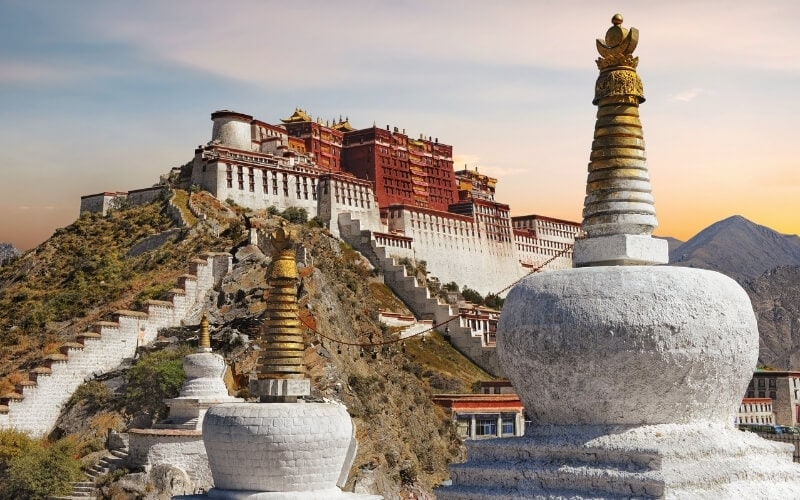
Sprawled across the eastern edge of the Tibetan Plateau, in the remote northern tip of China’s Sichuan province, Ruoergai town and county do not appear on Google maps. To Google, this locality is known by its Tibetan name, Zoige.
After 12 hours of following your car GPS from Chengdu to Zoige, climbing onto the Tibetan Plateau , Chinese road signs welcome you to Ruoergai, 3,500 meters above sea level.
Top cultural experiences on the Tibetan Plateau
Witness nomadic culture: Remote and isolated, Zoige/Ruoergai is the best place in the world to witness the disappearing Tibetan nomadic culture. All you have to do is drive around this vast, open grassland to catch a glimpse. You’ll see white nomads’ tents with smoky chimneys scattered on the sides of the road, surrounded by herds of domestic yak and protected by the menacing Tibetan mastiffs. The nomads are mistrustful of outsiders, which is not surprising given political tensions in the region.
Go horse trekking: Yet there is a way to experience the nomadic culture first-hand here – by taking a horse-trekking adventure with the local Tibetan Horse Trekking Agency in the nearby town of Langmusi. Tours range from a day hike to the hills – the domain of the nomads – to a multi-day horseback adventure with overnight stays in nomad tents. Guides are local Tibetans, so while you may not be having extensive discussions in English, you’ll be welcome in nomadic households.
Visit the monasteries and mosques in Langmusi: Encircled by forest-covered mountains, the small sleepy town of Langmusi is inhabited by three ethnic groups: Amdo Tibetans, Han Chinese and Hui Muslims. So, even just a visit to the town is a unique cultural experience. There are two large Tibetan monasteries on the hills above the town and a Hui mosque at its centre.
The nearest airport to Langmusi is Gannan Xiahe Airport, 130 km away. From Xiahe, you can take a bus to Langmusi, or arrange a car with a driver via Tibetan Horse Trekking.
By Margarita from The Wildlife Diaries
Taiwan – for night markets, Confucianism & forbidden relics

An island nestled off the coast of Mainland China, Taiwan is fast becoming one of the best cultural tourism destinations in Asia.
Its long history and combination of cultural influences – including Indigenous culture, Mainland China, Korea and even Japan – make Taiwan as intriguing as it is complex. Bustling with life, amazing food and beautiful scenery, this island has it all.
Top cultural experiences in Taipei
Eat your way through the Night Markets in Taipei: The capital city of Taiwan, Taipei, offers a world of things for people to see and do . One of the most popular culturally immersive activities for visitors is to head down to the local night market, the biggest one being the Shiling Night Market. Along with delicious local foods, you can also find clothes, accessories, games, cosmetics and more. Night Markets are significant because they play a huge role in Taiwanese culture . Locals and tourists alike flock to these areas each and every day to shop and socialise.
Observe the rituals at a Taiwanese temple: Taiwan is a very religious country with most people following either Buddhism or Confucianism. Many temples are built around these religions in a very extravagant manner. Visitors can take part in the prayer ceremony, burn some incense, or just sit back and observe. If you’re interested in visiting these temples, one of the best places to start is the Songshan Ciyou Temple, which is conveniently located right next to the Raohe Night Market.
Visit the National Palace Museum: This museum houses thousands of cultural relics, art and artefacts, including many items that were carried out of the Forbidden City in China and moved to Taiwan to protect them from destruction during the Chinese Civil War. It’s one of the largest collections of its kind in the world. Here, you can learn how the Chinese language was formed, see what kinds of ancient tools and weapons were used throughout history, and witness what life was like many hundreds of years ago.
By Wayne from Daily Tourist
Learn more: The best cultural experiences in Taiwan .
Cultural trips in Africa & the Middle East
Ethiopia • Oman • Mauritius • Morocco
Ethiopia – for coal-fired coffee, churches & injera

Ethiopia is a country like no other. Here in North East Africa, the steaming tribal lowlands of the Rift Valley collide with the cool thin air of the Northern highlands. The fertile lands towards the West produces some of the world’s best coffee, while the wind from the East carries whispers from Arabia. It’s truly a spectacular place to visit.
Ethiopia is even more unique in terms of its cultural treasures. As the only country in Africa never to be colonised, Ethiopia is a truly African country with African culture. If you want to see lions chase and eat zebras, go somewhere else. If you want to see and experience African culture at its purest, then book your ticket to Ethiopia already!
Top cultural experiences in Ethiopia
Visit the city of Lalibela: Situated in the northern highlands, Lalibela is the most important pilgrimage site in the country for the predominantly Orthodox Christian population of Ethiopia. It is here that you’ll find eleven incredible churches completely hewn from the rock. If you see only one place in Ethiopia, make it Lalibela.
Attend Sunday Mass: The UNESCO recognised Lalibela churches still function as churches, and attending a Sunday morning service before sunrise with hundreds of pilgrims is an experience that you won’t forget. Afterwards you can join the crowds eating injera while basking in the morning sun. Be prepared for the fact that everyone will want to come and talk to you.
Hike to a remote mountain community: Hiking into the mountains surrounding Lalibela will take you to small farming communities where time has seemingly stood still. It’s also possible to visit one of these communities for a day and learn how to cook traditional Ethiopian dishes such as injera , tibs or shiro . You’ll also find a few cave churches and monasteries in these mountains. The priests will be eager to show off their ancient treasures for a small tip.
Participate in a traditional coffee ceremony: Ethiopia is considered the birthplace of coffee, and man are you in for treat! The best way to drink a cup of buna (Ethiopian coffee) is to attend a coffee ceremony. It starts off with the hostess washing green coffee beans and then roasting them in a pan over an open fire. The coals are infused with natural incense made from tree resin. You’ll see bags of these tree resin for sale in markets all over Ethiopia. Finally the coffee beans are ground and brewed in a special coffee pot called a jebena . It’s expected that guests will have at least three cups of buna, but why stop there?
By De Wet & Jin from Museum of Wander
Oman – for dhow boats, frankincense & Bedouin culture

Unlike some of its more glitzy neighbours who’ve traded their souqs for skyscrapers, Oman has approached cultural preservation from a different angle. It’s often called out as the most culturally ‘authentic’ country in the region .
This part of the Middle East has long been a melting pot of Arabian and East African cultures, with a strong South Asian influence. Semi-nomadic Bedouin tribes that paint the desert with their costumes and brightly coloured carpets are less accessible, but a range of tourist-friendly desert experiences allow you to brush with this part of Omani culture.
Contemporary Omani traditions are deeply tied to Ibadism and revolve around an annual calendar of Islamic festivities.
Top cultural experiences in Oman
Get lost in a souq: Perfumed by rose petals and frankincense, Oman’s souqs are a treat for the senses. Roam displays of henna and spices while getting a feel for commerce and culture. Muttrah Souq in the capital, Muscat, and the delightful Nizwa Souq are both must-visits.
Visit a dhow workshop in Sur: Not only are Oman’s wooden boats an impressive feat of engineering, they’re steeped in legend and tradition. In Sur, the home of Sinbad the Sailor, you can watch expert craftsmen fitting the vessels together without glue or nails.
Spend the night at a desert camp. The Sharqiya Sands, Oman’s slice of The Empty Quarter, is the territory of nomads. Bedouin-inspired desert camps recreate the experience of staying with a Bedouin tribe – albeit with a luxury edge! Spending the night in a desert camp involves listening to folk music, eating Omani food, while the very lodgings – the tent lined with carpets you’re sleeping in – is part of the Bedouin tradition.
Mauritius – for street food, Sega & sugarcane
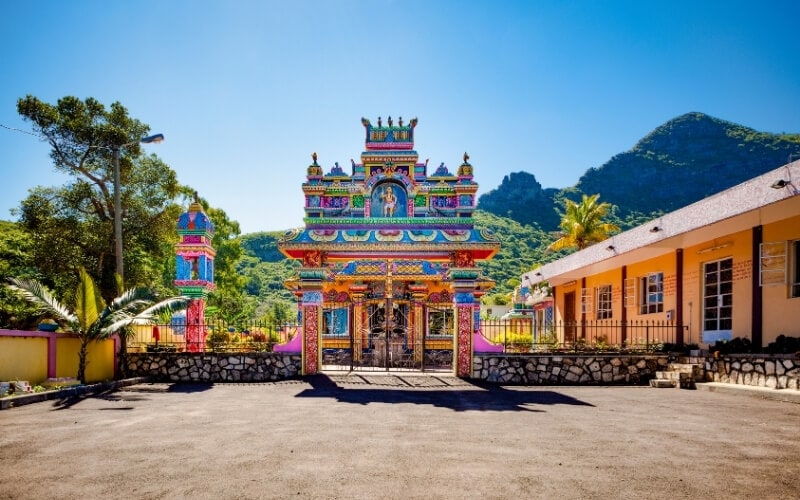
The island nation of Mauritius is normally associated with splendid white-sand beaches and luxury resorts – thus its inclusion on this list of cultural trips might come as a bit of a surprise.
Yes, this is an island paradise incarnate, but it also happens to be one of the most ethnically and religiously diverse countries in the region, with African, Indian, Chinese and South Asian cultures – along with layers of Dutch, French and British influence – all accounted for.
Many elements of Mauritian culture can be traced back to the island’s plantation roots and the legacy of slavery. Mauritians honour this period of history while proudly showing off their culture in everything from the cuisine to the music.
Top cultural experiences in Mauritius
Take a street food tour of Port Louis: Mauritian food, much like Mauritian society itself, combines Chinese, Indian, Creole, East African and European flavours. Must-try dishes include vindaye , an adaptation of West Indian vindaloo, Chatini (chutney) is a popular condiment and traces its roots back to British-Indian origins, briani (biryani) and creations gifted from the island’s Chinese community, such as bol renversé (a layered dish of rice, chicken, shrimp and vegetables). The best way to get a grasp of these edible delights is by joining a guided street food tour of the capital, Port Louis .
Watch a Sega performance: Recognised by UNESCO for its value to Intangible Cultural Heritage, Mauritian Sega is a performance art characterised by music, song, dance and costume. It started out as an expression of pain and loss practiced by slave communities but has morphed over time into a colourful, optimistic expression of local culture. Elaborate Sega costumes moving to the tune of Creole lyrics is a . Many hotels offer Sega performances.
Visit an old sugarcane farm: Mauritius’ history of slavery and plantation farming has left an indelible mark on the island. Visiting preserved plantation homes and crumbling sugar mills is a step back in time to the colonial period, while regenerated cane fields such as those on Frederica Reserve now serve as a sanctuary for the island’s wildlife.
Learn more: 8 ways to experience Mauritian culture .
Morocco – for riads , tajines & mint tea

By all accounts, Morocco is a beguiling destination . The most popular country to visit in North Africa, it stands out for its diversity of landscapes and cultural experiences.
Morocco is an important gateway to the rest of Africa, and has been since Roman times. Its position at the northernmost tip of the continent – with a coast shared between the Atlantic and the Mediterranean – means it’s been at the centre of conquests and various cultural overlap throughout the ages.
Today, Morocco lives with the legacies of various civilisations, including Roman, Phoenician, Jewish, Berber, Arabic, Spanish and French. Morocco has a very hospitable culture, steeped in a refined art of living. When you visit the imperial cities of Marrakech and Fes, or the coastal towns of Essaouira and El Jadida, you will notice a multitude of little details typical of Moroccan life.
This art of living and careful hospitality is very important in Morocco and, as a visitor, you can experience it in many different ways.
Top cultural experiences in Morocco
Try your hand at Moroccan cuisine: Moroccan cuisine is world-famous for its use of spices and mix of sweet and savoury flavours. Every restaurant offers a selection of delicious tajines , a stew of meat and vegetables. Couscous is on the menu every Friday and if you like sweets, you will be in heaven. Sweet biscuits mixing flower, almond and spice flavours make a delicious afternoon treat. If you’re interested in learning new skills, cooking classes are often available in traditional riads in Marrakech. Moroccan cuisine takes time and care, but the results are delicious and quite easy to recreate at home.
Shop for authentic handicrafts at a souq : Another great way to experience the heart of Morocco is to spend time in the souks. Shopping in Morocco is a fun experience and haggling for a good price is the norm. You have to engage with merchants, ask questions, make small talk and, most importantly, have fun with it! Never lose your smile and sense of humour, and it will great fun! The most spectacular shopping experience is in Marrakech due to the volume and intensity of the medina. It’s easy to get lost but that’s part of the experience too!
Sip mint tea, a Moroccan tradition: When you travel throughout Morocco, you will notice that mint tea is served everywhere. This is a pivotal element of Moroccan hospitality. Green tea is mixed with fresh mint leaves and served in little decorated glasses. There is a little bit of theatre in serving mint tea, with the brass or silver teapot held high above the glass… Traditionally, mint tea is served with a lot of sugar, but these days it is common for sugar to be served on the side, so you can dose it yourself. And you can even buy a set of decorated tea glasses in the souk as a souvenir!
By Delphine from Lester Lost
How to have a more culturally immersive travel experience anywhere in the world
It doesn’t matter if it’s a remote community or a popular city – there are things you can do to have a more enriching cultural travel experience no matter where you’re going.
Here are 10 practical tips to help you on your way.
1. Do your research before you go: Familiarise yourself with local customs and learn a bit of the history so you know what types of experiences to look out for. This guide is a great start!
2. Seek out festivals and special events: Many tourism boards feature a calendar on their website, or you can try using Facebook to find local events. Check out my four-part series about the world’s best festivals, starting here .
3. Eat local. Food is one of the easiest routes to culture. Here are my tips for eating local when you travel.
4. Stay at a homestay. Spending time with a local family will give you an invaluable insight into daily life. Here are my tips for using homestays in Vietnam.
5. Participate in a class or workshop . Trying a cooking class, handicraft workshop or any other hands-on experience is one of the easiest ways to immerse yourself in local culture. I recommend using Get Your Guide , Airbnb Experiences, Cookly or Backstreet Academy to find opportunities.
6. Learn a bit of the language. Even knowing a few basic words will show you’re interested and can go a long way to forming relationships.
7. Shop local. Support artisans and heritage skills. Here are my tips for finding authentic and meaningful souvenirs .
8. Slow down. The best cultural experiences are often spare-of-the-moment and can’t be planned in advance. Keep some flexibility in your travel itinerary for spontaneous detours.
9. Go your own way. You don’t always have to follow the pack. Venturing away from the crowds will often give you access to unique and meaningful experiences.
10. Don’t be afraid to ask questions. If in doubt, ask a local. Remember that cultural tourism is all about exchange – don’t just take, make sure you give something back in return.
Are you a cultural tourist? Which of these destinations is your favourite? What other places would you add to the list? I’d love to hear your suggestions in the comments below!
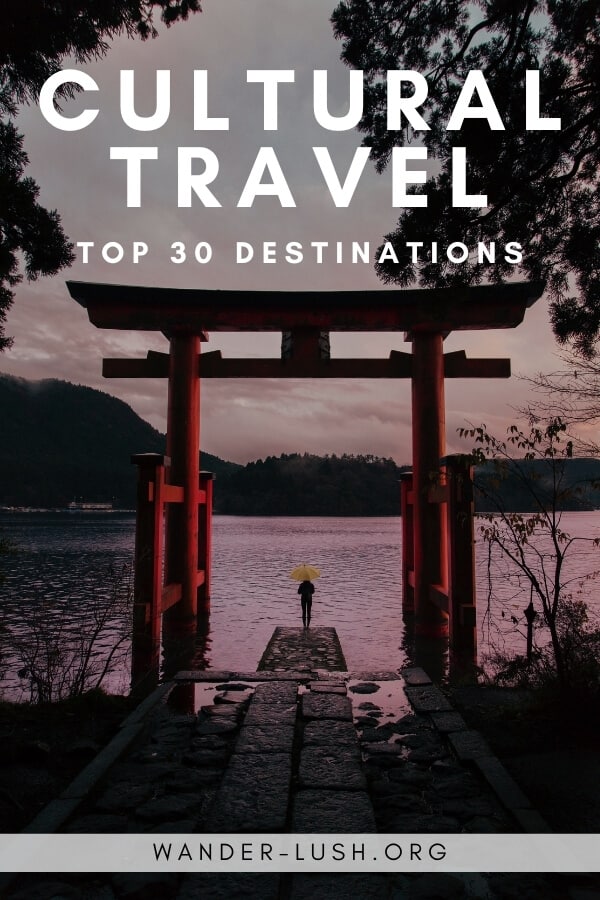
World’s best cultural trips: Save it & share it on Pinterest
More cultural travel inspiration.
- 30+ amazing cultural experiences around the world
- Best cultural festivals around the world
- Best destinations for tea culture
- Best destinations for wine culture
- Unique food cultures around the globe
- My collection of cultural travel guides for 30+ cities and regions
- World’s best unique & underrated travel destinations
This is a very wonderful article about cultural destinations! Thank you so much for sharing!
One can easily visit India and experience the different kinds of cultures in a particular place. Tourism in India has been much more managed and safe with passage of time. Rajasthan tourism has been the most reliable and safe in India. One can enjoy all the traditional dishes and enjoy living in the palaces as a hotel room in different cities. But, whenever you are visiting to Rajasthan, India travel guide is a must because one can easily lose track of pathways in the puzzle like roads of the cities in Rajasthan. One can easily plan for a Kerala tour packages because of the minimal expenses in the state.
Leave a Reply Cancel reply
Your email address will not be published. Required fields are marked *
- Subscribe to future posts
Cultural Tourism: A Comprehensive Guide to Exploring Global Heritage
Cultural tourism is a rapidly growing segment within the global travel industry, catering to individuals seeking to immerse themselves in local populations’ customs, traditions, and lifestyles. It combines the elements of leisure with an authentic experience of a destination’s unique historical, architectural, artistic, and culinary aspects. As a result, this form of tourism allows travellers to gain a deeper appreciation and understanding of different societies and their cultural characteristics.
In recent years, the demand for cultural tourism has been on the rise as more people are interested in exploring foreign customs and cultural experiences beyond the typical tourist attractions. This trend fosters cross-cultural connections and mutual understanding and creates positive economic and social impacts on local communities. By preserving and showcasing their traditions, local people have the opportunity to generate income and employment while maintaining a sense of pride in their cultural heritage.
With the increasing focus on sustainability and responsible tourism practices, cultural tourism sets itself apart by emphasizing the importance of engaging with local communities, adhering to ethical standards and minimizing negative impacts on the environment. As such, it presents a viable option for tourists who wish to expand their horizons while also contributing positively to the places they visit.
Table of Contents
Understanding cultural tourism.

Cultural tourism is a significant and growing aspect of the global tourism industry. The United Nations World Tourism Organization (UNWTO ) defines cultural tourism as the movement of people to cultural attractions away from their normal residence, with the intention of gathering new information and experiences that satisfy their cultural needs. It encompasses various activities undertaken by tourists to explore and experience different cultures, customs, and traditions.
One of the key aspects of cultural tourism is the opportunity it provides visitors to learn and engage with local communities, their history, and their way of life. This tourism is more than just visiting heritage sites or attending cultural events; it involves understanding and experiencing how people from different cultures live, express themselves through art, and maintain their traditions.
Cultural tourism fosters mutual understanding and respect between people from different cultural backgrounds. It encourages dialogue and exchange, breaking down social and cultural barriers and contributing to more tolerant societies. This form of tourism is an essential aspect of sustainable tourism development, as it seeks to preserve precious heritage for future generations while supporting economic growth for local communities.
As the tourism industry continues to grow, the demand for unique and authentic experiences increases. Cultural tourism serves to meet this demand by offering visitors the opportunity to immerse themselves in various cultural settings, fostering a deeper understanding of the world and its diverse cultures.
Importance of Cultural Tourism
Cultural tourism plays a significant role in society as it helps preserve and promote the values, beliefs, traditions, and heritage that define a particular culture. It allows individuals and communities to exhibit unique perspectives on arts, rituals, folklore, music, literature, language, oral traditions, and other cultural elements. Cultural tourism serves as a bridge between societies, aiding in fostering mutual respect, tolerance, and understanding among various cultures.
Economic benefits are also apparent through cultural tourism. Visitors contribute to the local economy, supporting local businesses and sustaining host communities’ cultural products and experiences. By engaging in cultural tourism, visitors gain an authentic understanding of indigenous and local cultures, empowering them to appreciate the rich diversity and uniqueness of the world.
Furthermore, cultural tourism helps preserve cultural heritage, vital for maintaining a sense of identity and continuity for future generations. This preservation and promotion of different cultures provide a sense of pride and belonging for people who are part of those traditions. In turn, this enhances cultural exchange, allowing individuals to learn about other ways of life while appreciating their values and beliefs.
Cultural tourism also supports the sustainability of performing arts and other creative industries. Through various interactions with artists and performers, visitors can develop an appreciation for a wide range of artistic expressions, contributing to the overall vitality of the art world.
Through the development of cultural tourism, a society can showcase its cultural heritage while contributing to its economic prosperity. By embracing the importance of cultural tourism, we can foster a greater understanding, appreciation, and celebration of the rich tapestry of customs, beliefs, and traditions that make up the world’s diverse cultures.
Types of Cultural Tourism

Cultural tourism allows travellers to immerse themselves in the history, heritage, and traditions of different places around the world. This form of tourism can be categorized into several types, each offering a unique way for visitors to experience and appreciate local cultures.
One type of cultural tourism is Historical and Heritage Tourism . This focuses on exploring sites related to a region’s past, such as ancient archaeological sites, monuments, and museums. It can instil a sense of wonder and appreciation for past civilizations’ achievements and teach travellers about the history of the places they visit.
Moving to the artistic side, Arts Tourism highlights the creative aspects of a culture. Tourists visit galleries, theatres, and concerts to experience local art, music, dance, and drama. It allows them to understand different communities’ aesthetic and expressive tendencies, opening their minds to new perspectives and forms of creativity.
Religious and Spiritual Tourism is another common form, where tourists visit religious sites, such as temples, churches, and mosques, or engage in spiritual practices like meditation and yoga. This type of cultural tourism can provide insights into various societies’ belief systems and rituals, fostering understanding and tolerance among people of different faiths.
However, culture isn’t just about history, arts, and religion but also daily life. Ethno and Indigenous Tourism involves tourists visiting and interacting with indigenous communities to learn about their customs, way of life, and unique perspectives on the world. This type of cultural tourism encourages empathy and cross-cultural understanding while emphasising respect for indigenous people’s rights and dignity.
Lastly, Culinary and Agritourism put emphasis on local food and drink traditions, as well as the agricultural practices that underpin them. This type of tourism can include attending food festivals, partaking in cooking classes or workshops, and visiting farms, vineyards, or breweries. Culinary experiences help tourists understand the richness of a region’s flavours and the relationship between local communities and their land and resources.
In summary, cultural tourism comes in various forms, appealing to different interests and tastes. It offers travellers a chance to explore and interact with diverse cultures, fostering connections and understanding among people around the world.
Forms of Cultural Tourism
Cultural tourism offers a wide range of experiences for travellers who seek to immerse themselves in different cultures, traditions, and ways of life. Various forms of cultural tourism cater to different interests and preferences.
Museums and galleries play a significant role in cultural tourism as they showcase a certain location’s history, art, and culture. Examples include art galleries displaying local and international masterpieces and museums featuring exhibits about the history and development of a specific region or theme.
Monuments and historic sites attract cultural tourists interested in exploring the past. Famous landmarks, archaeological sites, and heritage buildings tell the stories of civilizations and cultures that once thrived. UNESCO World Heritage Sites are often at the top of travellers’ lists, representing the world’s most significant cultural and natural heritage.
Architecture as a form of cultural tourism exposes tourists to varying architectural styles and meanings. Walking tours, cityscapes, and visits to iconic buildings provide a deeper understanding of a city’s architectural design’s cultural, social, and political influences.
Festivals and special events are another important aspect of cultural tourism, highlighting a particular community’s local customs and practices. These may include carnivals, parades, performances, traditional dances, and food festivals that provide a unique insight into the cultural identity of a place.
Gastronomy and cuisine play an integral role in the cultural tourism experience, as they allow tourists to savour the flavours and ingredients unique to a location. Local markets, food tours, cooking classes, and traditional restaurants all offer opportunities to appreciate the culinary heritage of a destination.
Shopping for crafts and textiles is a popular form of cultural tourism, as it allows travellers to bring home tangible memories of their journeys. Local artisans may showcase their talents through handmade textiles, pottery, jewellery, and other crafts, reflecting their community’s cultural heritage and artistic expression.
Cultural tourism encompasses diverse experiences, enabling travellers to engage with their chosen destination’s rich history, art, architecture, events, cuisine, and crafts. By exploring these varied aspects, visitors can deepen their understanding and appreciation of the world’s unique cultural landscapes.
Tangible and Intangible Cultural Attractions

Cultural tourism often focuses on two major aspects: tangible and intangible cultural attractions. These attractions shape a destination’s identity, providing depth and context for visitors and facilitating cultural exchange. This section will explore various facets of tangible and intangible attractions, comprehensively understanding their significance and diversity.
Tangible cultural attractions encompass elements of history, arts, and architecture that visitors can physically experience. Notable examples include monuments, visual art, and crafts that showcase local communities’ unique skills and traditions. Such attractions often reflect centuries of evolution and showcase the ingenuity of a region’s inhabitants. By visiting these sites and engaging with these art forms, travellers gain firsthand insights into the cultural heritage of their destination.
On the other hand, intangible cultural attractions comprise the non-material aspects of a culture that contribute to its unique characteristics and traditions. Music, social practices, festive events, and customs are some of the intangible elements that enrich the cultural landscape of a tourist destination. Interaction with local people plays a crucial role in understanding the region’s intangible cultural attractions, as they act as custodians of these traditions and their oral histories.
A dynamic interplay exists between tangible and intangible cultural attractions, creating a vibrant, multi-dimensional experience for tourists. For instance, the physical structure in architectural landmarks represents the tangible aspect, while the stories, legends, and rituals connected to the site contribute to its intangible allure. This symbiotic relationship reflects the essential interdependence between culture’s material and immaterial aspects.
In conclusion, tangible and intangible cultural attractions are indispensable pillars of cultural tourism. They provide an enriching experience for visitors and play a vital role in preserving and promoting a destination’s unique cultural heritage. Both aspects should be regarded with equal importance and cultivated to ensure a comprehensive and engaging experience for travellers seeking to explore a destination’s cultural offerings.
Advantages of Cultural Tourism
Cultural tourism provides a unique opportunity for individuals to immerse themselves in a particular society’s history, traditions, and customs. In doing so, they can develop a deeper understanding and appreciation of the diverse cultures that make up the world.
One significant advantage of cultural tourism is its potential to boost local economies. Tourist expenditures in local businesses such as hotels , restaurants, and shops can contribute to the growth and development of a region. Additionally, cultural tourism can create jobs, especially for local artisans, performers, and guides who offer authentic cultural experiences to visitors.
Another benefit of cultural tourism is the preservation and revitalization of cultural heritage. By attracting tourists interested in learning about and experiencing different traditions, communities are encouraged to preserve and maintain their cultural assets, such as historic sites, museums, and festivals. This helps ensure that future generations can continue to enjoy and learn from these valuable resources.
Cultural tourism also fosters cross-cultural understanding and appreciation. As people engage with diverse cultures, they may develop a broader perspective and a greater respect for cultural differences. This can lead to increased tolerance and harmony among different societies.
However, it is important to be aware of the potential disadvantages of cultural tourism. For instance, there may be issues related to overcrowding, environmental impact, or the commodification of cultural traditions. This makes it crucial to manage cultural tourism responsibly, ensuring it benefits both the tourists and the host communities.
Disadvantages of Cultural Tourism
Cultural tourism has gained popularity in recent years, drawing visitors from around the globe to experience and appreciate diverse cultures. However, this type of tourism also brings several disadvantages that must be considered.
One significant drawback of cultural tourism is the potential for commodification of cultures. As communities open their doors to tourists, they risk losing the authenticity and uniqueness of their cultural identity. Traditional practices and artefacts may be tailored to appeal to the tourist market, diluting their cultural significance.
Moreover, cultural tourism can put pressure on resources and spaces used by local communities. The influx of tourists may lead to overcrowding and increased competition for essential amenities. This could negatively impact the quality of life for local residents and strain the available infrastructure.
Another issue is the potential for environmental degradation resulting from cultural tourism. Some tourist activities may involve access to sensitive natural areas, leading to erosion, pollution, or disturbance of wildlife habitats. The construction of tourist facilities and infrastructure can also threaten the environment.
Lastly, cultural tourism can contribute to the unequal distribution of economic benefits. While some members of the community may profit from tourism-related businesses, others may not be able to participate in or benefit from these enterprises. This could exaggerate income disparities and create economic imbalances within communities.
In conclusion, despite cultural tourism’s numerous benefits to travellers and host communities, it is crucial to acknowledge and address its potential negative aspects. To ensure the long-term success of cultural tourism, policies and practices must be implemented that prioritize the protection of cultural and environmental resources and promote equitable distribution of economic benefits.
Cultural Tourism Destinations

Cultural tourism is a popular type of travel that allows visitors to immerse themselves in various destinations’ history, heritage, and traditions. Throughout the world, numerous places provide rich cultural experiences for travellers. Here, we explore a few notable cultural tourism destinations.
China is a vast and diverse country with a history dating back thousands of years. One can explore the architectural wonders of the Great Wall, the Terracotta Army in Xi’an, or the magnificent Forbidden City in Beijing. Visiting local markets and trying traditional cuisine also adds to the cultural experience in China.
India is another top destination for cultural tourism, offering many historical sites and vibrant traditions. The Taj Mahal in Agra, a UNESCO World Heritage Site, is a must-see with its iconic marble mausoleum. Another popular destination is Rajasthan , where the colourful cities and the royal palaces, such as the spectacular City Palace of Jaipur, offer a glimpse into the past.
France , specifically Paris , provides visitors with rich art, architecture, and cuisine. Iconic sites such as the Louvre, Notre Dame Cathedral, and the Eiffel Tower showcase the country’s artistic and architectural achievements throughout history.
Similarly, Spain is renowned for its rich cultural heritage with attractions such as the Alhambra in Granada, the Park Güell in Barcelona, designed by Gaudí, and the Prado Museum in Madrid.
Turkey , especially Istanbul , offers an intricate blend of European and Asian influences, with historic sites such as the Hagia Sophia, the Blue Mosque, and the Topkapı Palace. Moreover, the open-air bazaars and Turkish baths deliver an authentic cultural experience.
Italy , the birthplace of the Renaissance, is brimming with artistic and architectural masterpieces. Cities like Rome, Florence, and Venice are steeped in history, allowing visitors to marvel at landmarks like the Colosseum, St. Peter’s Basilica, or the Uffizi Gallery.
The beautiful island of Bali in Indonesia is known for its lush landscapes, Hindu temples, and vibrant arts scene, making it an excellent location for immersing oneself in the culture of the region.
Uzbekistan has gained attention recently as tourism grows along the Silk Road route. Visitors can admire the stunning architecture and mosaics of cities such as Samarkand, Bukhara, and Khiva, which capture the rich heritage of the ancient trading route.
In conclusion, cultural tourism invites travellers to explore fascinating destinations across the globe. While each location offers unique experiences, they provide a deeper understanding of human history, traditions, and heritage.
Stakeholders of Cultural Tourism

Cultural tourism is a multi-faceted industry that brings value to travellers in search of authentic experiences and to a myriad of stakeholders. From local communities to government bodies and from small businesses to environmental conservation efforts, cultural tourism can shape economies and lifestyles in both positive and negative ways. This guide delves into the key stakeholders in the cultural tourism sector, exploring their roles, impacts, and interconnected interests.
Tourists: The Heart of the Industry
Arguably, tourists are the backbone of cultural tourism. Whether they are history enthusiasts seeking out ancient ruins or gastronomes on the hunt for authentic local cuisine, tourists drive demand and shape the landscape of the tourism industry. They often seek enriching experiences that can offer a deep understanding of local cultures.
Local Communities: The Soul of the Destination
Local communities provide the lived experience that many cultural tourists seek. These people preserve the traditions, language, and heritage sites that form the basis of cultural tourism. Unfortunately, they can also bear the brunt of poorly managed tourism through cultural commodification and environmental degradation.
Government Bodies: The Framework Providers
Local and national governments play an instrumental role in regulating and promoting cultural tourism. They invest in infrastructure, enforce zoning laws, and facilitate public services like safety and sanitation that are vital to the tourism industry.
Tourism Boards and Agencies: The Promoters
Tourism boards, often funded by governments, are responsible for marketing a destination’s cultural assets to the world. These bodies work closely with other stakeholders to develop tourism packages, advertise local attractions, and even set guidelines for responsible tourism.
Tour Operators and Travel Agents: The Experience Curators
Specializing in delivering personalized experiences, these businesses are intermediaries between tourists and destinations. They can make or break the quality of the cultural tourism experience through their choices of local partnerships, itineraries, and guides.
Cultural Institutions: The Keepers of Heritage
Museums, art galleries, and historical sites are essential touchpoints for cultural tourists. They collaborate closely with various stakeholders to ensure that cultural assets are preserved and made accessible to the public.
Artisans and Performers: The Artistic Impressions
Artisans and performers add texture to the cultural fabric of a destination. These stakeholders benefit from increased visibility and economic opportunities , providing tourists a gateway to the authentic local culture.
Small Business Owners: The Local Economy Boosters
From restaurants and cafes to souvenir shops, small businesses see a surge in revenue when cultural tourism is thriving. They form a vital part of the local economy, providing services that enrich the tourist experience.
Academics and Researchers: The Thought Leaders
Cultural tourism is a field ripe for academic inquiry, touching upon anthropology, economics, and sociology disciplines. Research in this area can help shape policies that benefit tourists and local communities.
NGOs: The Advocates of Sustainability
Organizations that focus on cultural or environmental conservation often align with the interests of responsible cultural tourism. They act as watchdogs and advocates, ensuring that tourism practices are sustainable and ethical.
Real Estate Developers: The Infrastructure Builders
Though not directly related to the culture, real estate is essential in accommodating the influx of tourists, especially in booming destinations. They must balance business interests with responsible development.
Media: The Influencers
Media outlets, including travel bloggers and journalists, have a significant role in shaping public perception of a destination. Their storytelling can amplify the benefits or expose the pitfalls of cultural tourism.
The Environment: The Unspoken Stakeholder
Although not a traditional “stakeholder,” the environment stands to be significantly affected by tourism activities. Sustainable practices must be adopted to preserve the natural and cultural landscapes that attract visitors in the first place.
Understanding the intricate web of stakeholders in cultural tourism is the first step in creating an industry that benefits all. As cultural tourism evolves, stakeholders must actively dialogue to ensure sustainable and enriching experiences for everyone involved.
Cultural Tourism Experience
Cultural tourism experiences provide a unique opportunity for travellers to immerse themselves in the local culture, customs, and traditions of the places they visit. These immersive travel experiences enable tourists to understand the heritage and identity of the communities they encounter.
One popular way to experience cultural tourism is through homestays. These accommodations offer the chance to live with a local family, providing a firsthand glimpse into their daily lives and customs. The cultural exchange within a homestay environment can be transformative, offering insights that would otherwise remain veiled during a typical sightseeing vacation.
Another important aspect of cultural tourism is engaging with the local communities, participating in their events and festivals, and learning about their history and heritage through interactions with the people there. These experiences enable travellers to connect meaningfully with locals, fostering mutual appreciation and understanding of different cultures.
Cultural experiences often focus on different dimensions, such as:
- Arts and crafts: Exploring local artisans’ craftsmanship and heritage by visiting workshops, galleries, and markets.
- Cuisine: Sampling regional culinary specialities can offer a taste of local culture, traditions, and history.
- Religious sites: Visiting places of worship offers insight into the spiritual beliefs and practices of the area.
- Performing arts: Engaging with local music, dance, and theatre performances can reveal unique cultural perspectives and expressions.
Cultural tourism emphasizes responsible travel and encourages visitors to respect and appreciate the local customs, traditions, and the natural environment while exploring new destinations. Tourists can create unforgettable memories by connecting with people from different backgrounds and gaining a deeper understanding of their practices and values, fostering greater global empathy and cultural appreciation.
32 Cultural Tourism Destinations for Unique Cultural Trips
Disclaimer: This article includes affiliate links to the products we earnestly love and recommend, meaning at no extra cost to you, we might make a teeny-weeny commission if you click on the link and decide to buy something. The money will be used to sustain this little cozy blog we call our virtual home.
As a cultural traveler, I always look for unique cultural experiences wherever I travel. Do you also believe in cultural travel or immersive travel? That being so, this round-up of the very best cultural tourism destinations in the world is sure to help you plan a soulful cultural trip.
Cultural Tourism: Introduction
I’m a sucker for meaningful travel experiences. Beach vacations don’t excite me as much as cultural trips.
What exactly is a cultural trip?
To put it simply, a cultural trip is a trip with a purpose or a goal.
It’s about experiencing, understanding, appreciating, embracing, and preserving different cultures and traditions worldwide.
It’s about getting off the beaten path & stepping out of your comfort zone.
It’s about meeting natives and forming meaningful connections.
It’s about eating local delicacies and staying in homestays.
It’s about being a part of cultural events, local festivals, and rituals .
It’s about gaining knowledge or learning a new skill.
It’s about volunteering and helping local communities thrive.
It’s about challenging preconceptions and bringing in fresh perspectives.
It’s about traveling slowly, sensibly, sustainably, and responsibly, not leaving footprints, and treading a little lighter on the planet.
It’s about not just thinking about yourself but caring about the world @ large.
Culturally immersive travel is all the more important in present times to deal with the dynamic challenges of globalization and multiculturalism.
Cultural tourism is vital in preserving culture and heritage to build a beautiful world and we, as travelers, have a social responsibility to make a positive impact on the local economy, environment, and communities whenever and wherever we travel and inspire others to do that too.
To get on with it, I collaborated with seasoned cultural travelers to bring together this guide to the best cultural destinations in the world that include exciting cultural countries that put forward experiential cultural travel experiences.
Cultural Tourism Destinations for the Best Cultural Experiences in the World
Needless to say, you can have a culturally immersive travel experience anywhere and everywhere in the world.
Each destination has a culture different than yours waiting to be explored and thus, it’s tough to choose a few, however, I’ve cherry-picked the countries that catch the eye for their strong culture and heritage and intrigue a cultural tourist.
Top Cultural Tourist Destinations in Asia
Nele van Hout from The Navigatio
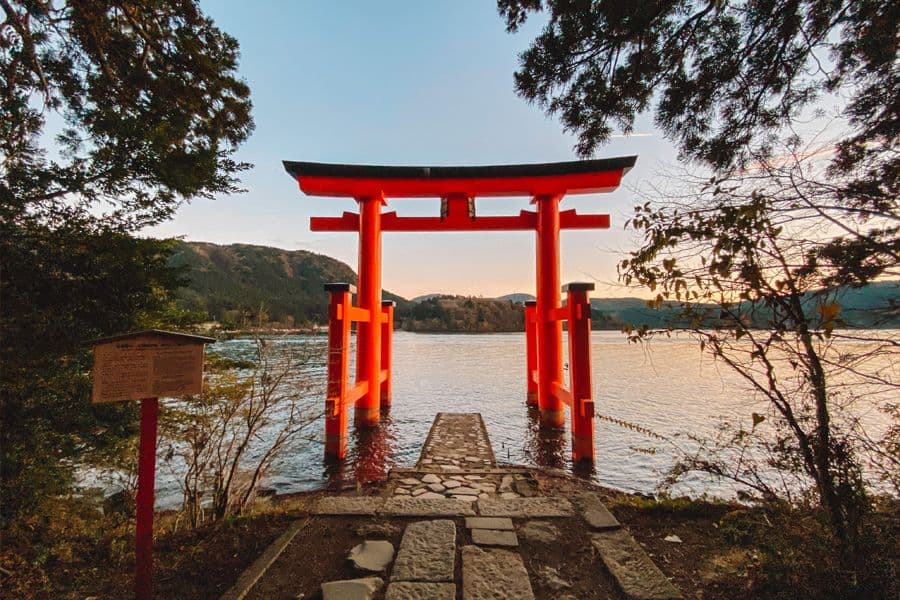
Japan is one of the most unique and culture-rich countries in the world. It’s counted as one of the leading cultural destinations in the world for a reason.
Being an island, Japan was isolated from other countries for centuries, allowing it to develop its very own unique customs and traditions.
While many influences from outside are now being introduced in the country, Japan remains a travel destination like no other.
Japan is known as a country of many contrasts. The hyper-modern side can be enjoyed in big metropolitan cities like Tokyo, where you can play video games in arcades, be checked into a hotel by a robot, sing karaoke or ride the fastest train in the world (the Shinkansen).
But it’s the traditional side where Japan really differentiates itself from the rest of the world. When visiting, you can dress up in traditional wear, the kimono, before heading over to temples there were built over a thousand years ago – some of the most famous ones can even be found inside the big cities.
In Kyoto, the cultural capital of Japan, you can still find geishas to this day – these are women dressed in kimonos wearing unique white make-up who specialize in tea ceremonies and performance arts.
Here, you can (must) also take part in an official tea ceremony . Matcha (Japanese green tea) plays a big role in Japanese culture and Kyoto is the perfect place to learn about it.
When in Japan, you should consider staying in a ryokan for at least one night. This is a traditional Japanese inn, usually equipt with tatami floors (traditional straw floors) and sometimes they even have an onsen (Japanese hot springs).
They can be found all across the country, but the city of Hakone has a lot of them , including onsen. Some even come with a view of the majestic Mount Fuji .
De Wet & Jin of the Museum of Wander
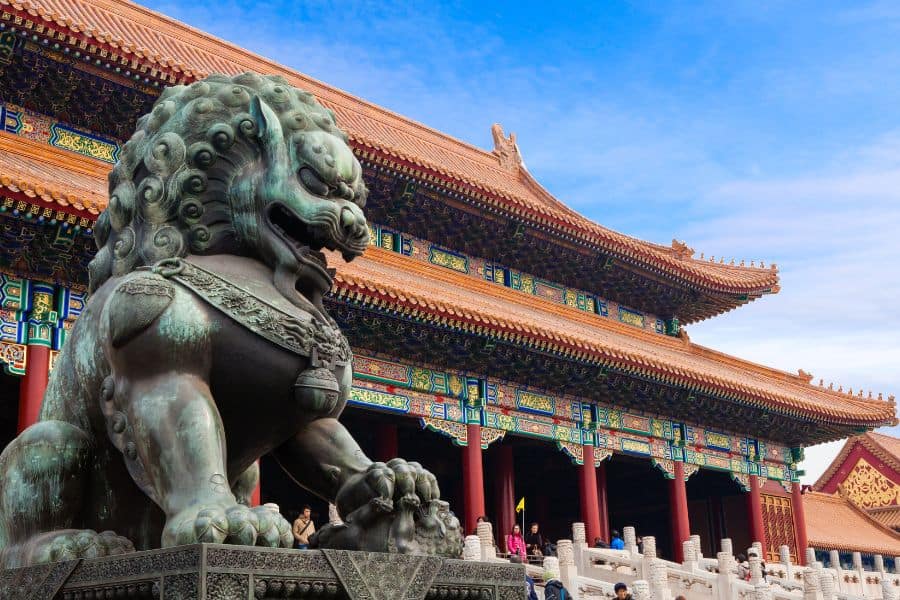
One of the top choices for cultural trips around the world, few places can compete with the cultural magnificence of China.
The country has a rich and diverse history that spans over 5,000 years, making it one of the oldest continuous civilizations in the world.
The staggering wealth of cultural heritage scattered across the country can make deciding where to go in China challenging. Whether looking for historical landmarks, tea culture , fantastic food, ancient and modern art, traditional medicine, minority cultures, or unique cultural experiences, China delivers like a few others.
First-time visitors to China can experience the best of Chinese culture and history in the capital, Beijing. Besides seeing the famous historical landmarks like the Forbidden City, the Great Wall, the Temple of Heaven, and the Summer Palace, they’ll also have many opportunities for a slice of authentic Beijing life.
Join the rest of Beijing and ride a bike along the wide and leafy bike lanes, or head to one of the parks to see people play chess, practice calligraphy or opera singing, or do ballroom dancing.
No visit to China is complete without indulging in its incredible cuisine. In Beijing, that means Peking duck. For the best roast duck in Beijing, you must not miss Quanjude restaurant.
Art lovers, collectors, or those looking for a unique souvenir from China should visit Beijing’s antique market. Panjiayuan Antique Market is home to hundreds of vendors dealing in authentic Chinese antiques and replicas – the fun is finding the difference and bargaining until the price is right.
While Beijing has accommodations to suit every budget and taste, staying in a traditional hutong courtyard hotel is best if you want to immerse yourself in the real Beijing. The Double Happiness Courtyard Hotel in the Dongcheng district is the perfect base to see and experience the local side of Beijing.
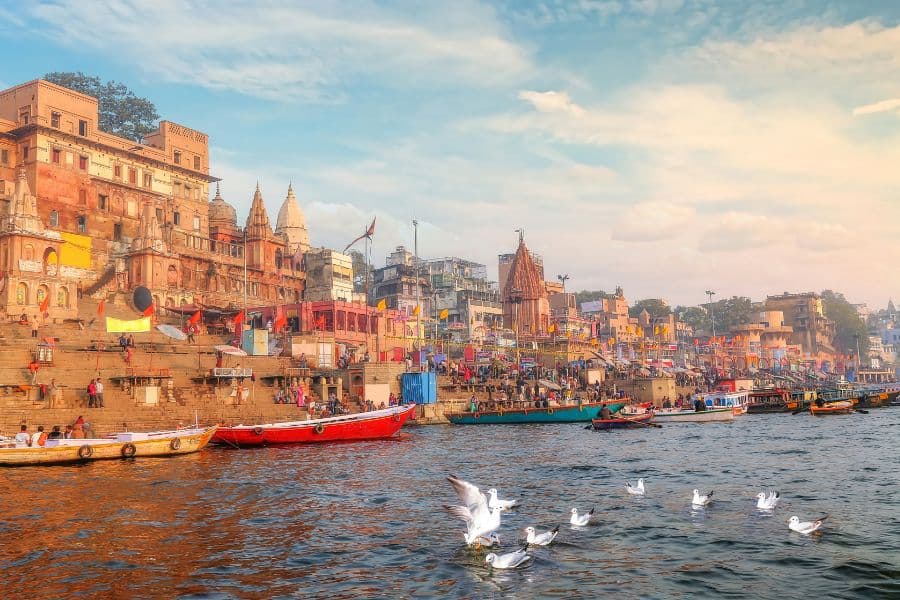
One of the oldest civilizations in the world, India has a rich, vibrant, and diverse cultural legacy that makes it the ultimate cultural tourism destination.
Over the centuries, India has been invaded several times by diverse rulers leaving an indelible mark on its cultural fabric. You can see and feel the influence of diverse cultures in architecture, traditional customs, food, dance, music, festivities, and languages. It, without a doubt, is one of the best places for culture in the world.
The Indian cultural heritage, values, and traditions have shaped the history of Asia and the world for that matter.
From ancient temples and royal palaces to majestic forts and historical monuments, the plethora of heritage sites in India showcases the cultural vitality of the country.
Each Indian state with its distinctive cultural heritage deserves a special place among beautiful cultural destinations in India, however, some states and cities take a lead for their cultural and historic stature on the world stage like Varanasi, Jaipur , Delhi , Amritsar , Madurai, Hampi, Mysore, Khajuraho, Kochi , and Rishikesh.
Among the various destinations for cultural tourism in India, Varanasi (Benaras or Kashi) is indeed the symbol of Indian culture. “Benaras is older than history, older than tradition, older even than legend, and looks twice as old as all of them put together,” penned Mark Twain.
One of the oldest living cities in the world, this sacred city on the banks of the Holy River Ganges is where people from across the world come to attain moksha (salvation). Its ancient temples, historic ghats, and revered Ganga Aarti offer unmissable cultural experiences. Without a doubt, Varanasi is one of the best cultural cities in the world.
With magnificent palaces, invincible forts, folk music, colorful festivals, and fairs – the royal cities of Rajasthan narrate the grandeur of erstwhile royals.
The unique temples of Tamil Nadu have great mythological and historical significance in Indian culture. The Meenakshi Temple in Madurai is the epitome of beauty and architecture and a must-visit for cultural buffs.
Khajuraho, a UNESCO World Heritage Site in Madhya Pradesh beautifully mirrors the art and creativity of ancient India. One of a kind in the world!
Kerala is a melting pot of different cultures and traditions. You can sense the Arab, Chinese, and European influences, especially in Fort Kochi. You can visit Kerala Kathakali Centre to witness traditional dances such as the Kathakali or the classic martial arts form of Kalaripayattu. Art lovers can plan around Kochi-Muziris Biennale, the biggest contemporary art festival in Asia.
No cultural trip to India is complete without taking part in one of the colorful Indian festivals . Holi and Diwali are hit among cultural tourists. And of course, gorging on traditional Indian food is part and parcel of an immersive travel experience in India.
The Mughal monuments of Delhi , the Golden Temple of Amritsar, the Indo-Portuguese architecture of Goa, the Awadhi heritage of Lucknow, the artistic and literary heritage of Kolkata, the historic temples of Bhubaneswar, the Buddhist pilgrimage of Bodh Gaya, ancient ruins of Hampi, palaces and pilgrim sites of Mysore, and on and on – India is your answer to culture fix.
And how can I talk about Indian culture and not mention its ancient healing traditions – Yoga and Ayurveda that make India a leader in holistic wellness? From Rishikesh and Narendra Nagar to Kottayam, Allepey, Palakkad, and Mysore – there are endless Yoga and Ayurveda Ashrams & Resorts in India.
For an immersive Indian culture experience, book a stay at one of the unique heritage hotels or local homestays or wellness retreats in India.
Ami Bhat of Thrilling Travel
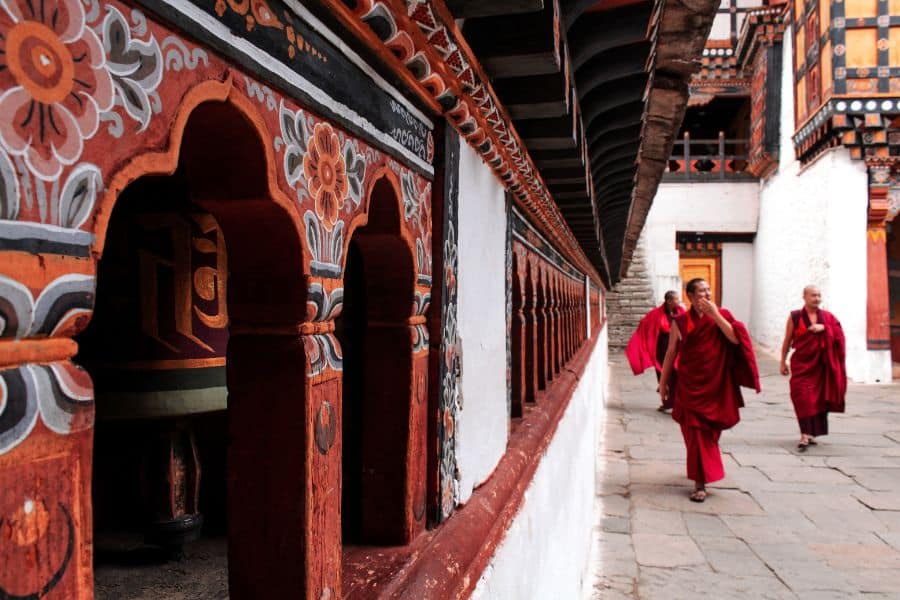
Known for its commitment to Gross National Happiness, Bhutan is a place where you will find how well-balanced the concepts of well-being and spiritual values are alongside economic development. The small landlocked country located in the eastern Himalayas is a perfect combination of culture, heritage, and nature.
The history of Bhutan dates back to the 8th century when Guru Rinpoche, also known as Padmasambhava, introduced Buddhism to the region. The country’s early history is characterized by the establishment of local chieftaincies, with the emergence of the Wangchuck dynasty in the early 20th century leading to the unification of the country.
It was in 2008, the country made the transition to a constitutional monarchy, with the king remaining the head of state but with a democratically elected government.
Every major town in Bhutan has a central Dzong (fort) which is not just a center of governance but also, a religious and cultural hot spot. A visit here not only allows you to appreciate the traditional Bhutanese architecture but gets you familiarized with the key customs and traditions of the country.
Besides these, there are several ancient monasteries and temples like Taktsang Monastery, Chimi Lhakhang ( the fertility temple), and the Gangtey Monastery that one can visit.
No cultural experience is complete without a taste of the local meals. Bhutanese cuisine is known for its spiciness and use of chilies, and traditional dishes include ema datshi (chilies and cheese), phaksha paa (pork with vegetables), and momos (dumplings).
It is highly recommended that one experiences a stay in one of their traditional villages located in peaceful valleys like the Haa Valley and Phobjikha Valley. There are several farmhouses that provide authentic experiences including traditional stone baths.
Kaitlyn from Carry On Only
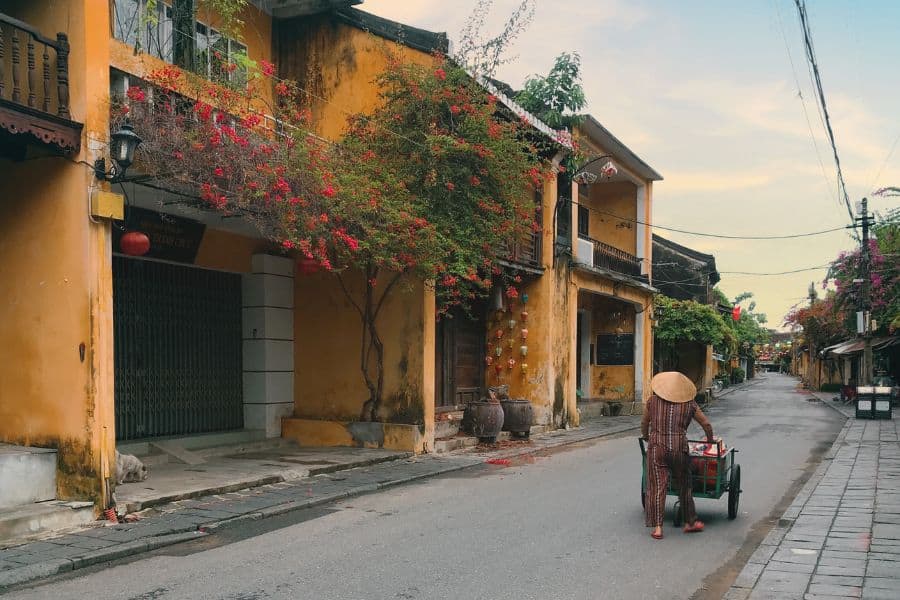
Vietnam is an ideal destination in South East Asia for those who wish to experience a diverse and fascinating culture. It’s a beautiful country brimming with endless cultural tourism attractions and thus, offers some of the best cultural vacations in the world.
The history of Vietnam is complex and includes significant events such as a 1000-year-long period of Chinese rule over northern and central Vietnam, a 1st century AD rebellion led by the Trung Sisters against Chinese domination, successful defense against Mongol invasion, French colonization during the 19th century, and the widely known Vietnam War.
Vietnam has a wide range of attractions that would interest culture buffs. These include the My Son Sanctuary, Cu Chi Tunnels, The Ancient Town of Hoi An (which features the Precious Heritage Art Gallery Museum , War Remnants Museum and the Independence Palace in Ho Chi Minh City , the imperial city of Hue, Bac Ha Market in Lao Cai, Water Puppet Theatre in Hanoi , and floating markets along the Mekong Delta.
If you want to have a complete cultural experience, then choosing a Homestay in the Sapa area is the optimal way to do it. You can get an authentic taste of the daily life of the Black Hmong by staying in The Little Hmong House .
Vietnamese locals are renowned for their friendliness and hospitality towards tourists, making it easy for visitors to connect with them and learn about their vibrant culture and way of life.
If you want to experience a magnificent culture, visiting Vietnam is a must-do on your bucket list!
Alex and Leah of Alex and Lean on Tour
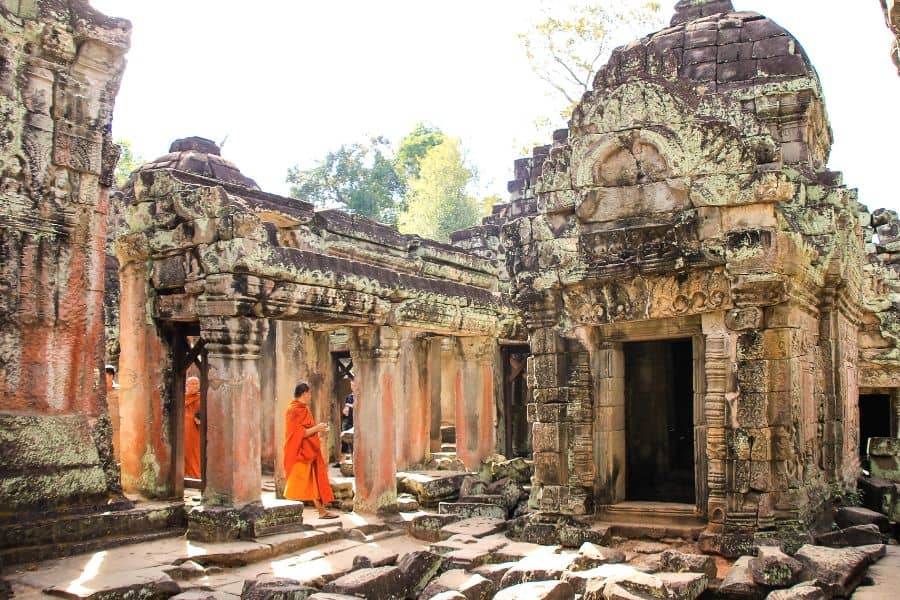
If you’re looking for an explosion of culture, look no further than Cambodia, one of the very best cultural places in the world.
The country has endless cultural attractions that you absolutely must visit. Whether it’s the famous sunset at Angkor Wat near Siem Reap or lesser-known gems such as the Battambang Bamboo train, there’s so much to experience in Cambodia.
Angkor Wat is an absolute must-visit for anyone traveling to Cambodia. The region has tons of temples, all representing something different about Cambodian culture.
If you’re looking to explore off the traditional touristy track, make sure to visit Battambang and stay at the beautiful Sanctuary Villa which fully blends into the environment perfectly yet still has amazing facilities!
Similarly, if you love the hustle and bustle of a city that has an abundance of great food places, Phnom Penh’s the place to be. Full of every food imaginable
Cambodia has a very fraught history and has only recently managed to dispose of the Khmer Rouge. This truly horrific regime attempted to restructure Cambodian society which ended up slaughtering millions of innocent people in prison and killing fields. It’s still a very poor country so make sure to be conscious and respectful when you visit!
If you’re looking to relax Cambodian-style then why not also visit the beautiful Koh Rong islands in the southwest? You’ll have the chance to swim in the turquoise sea by day and bio-illuminant plankton by night!
Dotti from Travel Oasis
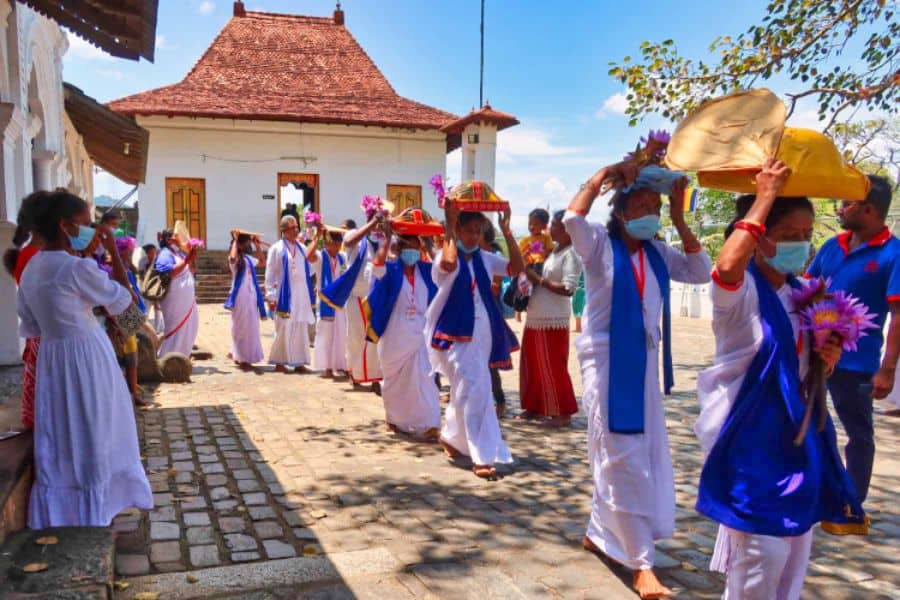
Sri Lanka is a fabulous destination for culture lovers. This little island is overflowing with cultural attractions due to its extensive history dating back millennia.
The most obvious place to get a cultural fix in Sri Lanka is the cultural triangle. This region, in the center of the country, is where the Sinhalese civilization was born. It’s also where the bulk of Sri Lanka’s cultural attractions are: the ancient cities of Anuradhapura and Polonnaruwa, Mihintale, the Dambulla cave temples, and the famous rock citadel of Sigiriya.
The largest of these is Anuradhapura , Sri Lanka’s first capital. It was one of the ancient world’s great metropolises at the time, with monasteries, massive dagobas, elaborate palaces, and water tanks. Many of these monuments still remain, not only as popular tourist attractions but as important Buddhist religious sites, so it’s common to see pilgrims paying visits.
Just south of the cultural triangle is Kandy , the second-largest city in the country. Kandy is known as the cultural capital of Sri Lanka due to housing the famous Temple of the Tooth. This temple, which is open to the public, is said to hold a tooth from the Buddha and is of utmost importance to Buddhists worldwide.
In the north of Sri Lanka is Jaffna, home to the majority of the country’s Tamil population. Jaffna is a great place to experience Sri Lanka’s Hindu culture, with shrines peppered throughout the region. The most famous is Nallur Kandaswamy Kovil, which dates back to the 13th century.
There’s no better place to stay than Ceylonima Home Stay in Anuradhapura. Run by an incredibly welcoming family who goes out of their way to provide the best experience for their guests. From giving local tips to informal cooking classes in their own kitchen, this is a cultural experience not to miss.
Linda of Muy Linda Travels
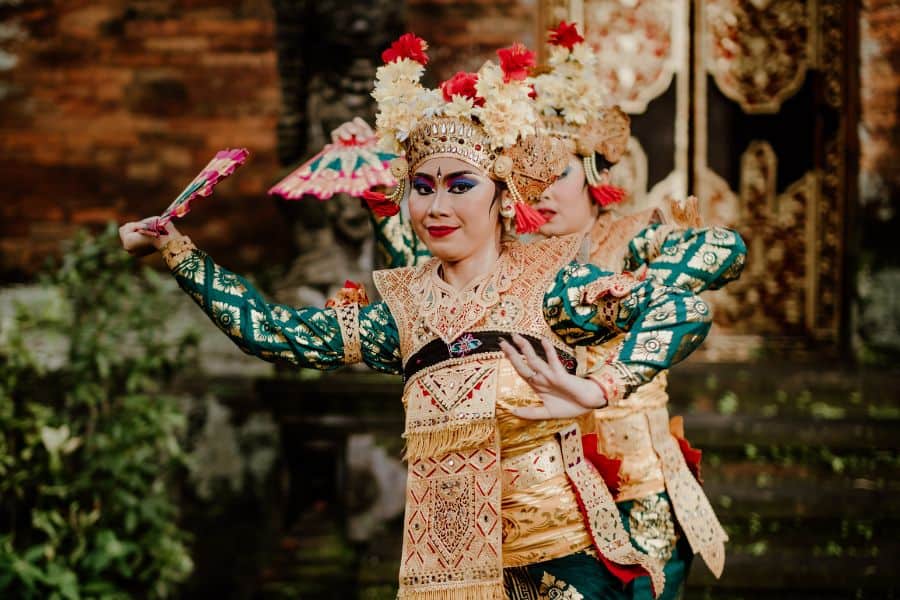
Indonesia is an archipelago in Southeast Asia comprising five main islands and more than 18,000 smaller islands located on ancient trading routes between Asia, and the Middle East.
With more than 300 ethnic groups, Indonesian culture is a blend of traditions, religions, and cultural practices. More than 85% of Indonesians are Muslim with Hinduism, Buddhism, and Christianity making up the remaining numbers.
Indonesia’s ancient religious monuments are a great place to start exploring the country’s rich history and culture. The Island of Bali has more than 10,000 Hindu shrines.
But Indonesia’s most beautiful temples can be found in Java. Majestic Borobudur, the largest Buddhist Temple in the world, and Prambanan Temple, the oldest and the largest of Indonesia’s Hindu Temples lie near Yogyakarta in Central Java. Both famous monuments are UNESCO world-heritage listed and recognized for their historical importance and cultural significance.
In Central Java, the Sarasvati Hotel in Borobudur is a lovely place to stay. The elegant Dutch colonial-era building has a superb location near the entrance to the Borobudur Temple grounds.
Indonesia has a history of Sultans that ruled local areas before and during the Dutch colonial rule. Royal Courts can be visited in Java, Bali, Borneo, and the Spice Islands. The Sultans were revered for their refinement and high culture. A highlight of visiting the Royal Palace in Yogyakarta is watching a live Gamelan and shadow puppet performance.
In Java, the Batik Museum in Solo has a beautiful collection of traditional Indonesian Batik fabrics and sarongs, and in Bali, traditional Dance is performed regularly with evening performances in Ubud and around the island.
Traditional Indonesian food is another way to explore the culture with dishes like, sate chicken and peanut sauce, Gado Gado, Babi Guling, Nasi Goreng, and Mi Goreng.
Indonesia has much to offer and is a great destination for culture lovers.
Emily from Emixglobe

With a long history of colonialism blended with rich aboriginal culture, Taiwan has an extremely colorful fusion of cultural heritage unique from all its East Asian counterparts.
One of the best ways to experience the various forms of Taiwanese culture is to visit the many historic streets scattered throughout Taiwan. Each historic street has its own unique history and culture associated with it.
From these streets, you’ll be able to get a glimpse of how Taiwanese people have lived throughout the centuries; from well-preserved buildings left from the Japanese colonial period to the fascinating and unique Hakka culture of Taiwan.
Some of the most beautiful and notable historic streets in Taiwan include Jiufen and Lukang Old Street, both dating back to the Qing dynasty.
Jiufen was once a prosperous mining town and many have speculated it to be the inspiration for Ghibli’s spirited away due to striking similarities. Lukang used to be the second most prominent town in Taiwan and an important seaport rich in Hakka culture.
The Aboriginal culture is also an important part of Taiwanese culture. The Aborigines have lived in Taiwan for 6000 years, and there are officially 16 recognized tribes in Taiwan, each with its own unique language and culture.
The best way to experience the Aboriginal culture is to take their villages and immerse yourself in their daily way of life and participate in festivals and events.
South Korea
Mayi from SecretMoona

In recent years, South Korea has undergone tremendous cultural change. Thus when considering the country, we often think of K-Pop, K-Drama, K-Food, and high-tech.
But South Korea also offers something for those interested in history and culture. A trip to South Korea is an invitation to discover 5,000 years of history, art, and culture.
Here, Chinese and Japanese influences can be seen in the rich heritage, but Korean culture displays a particular style. Starting with Seoul, a bubbling capital where futuristic architecture brushes shoulders with ancient palaces.
You can explore Bukchon Hanok Village. Surrounded by Gyeongbokgung Palace, Changdeokgung Palace, and Jongmyo Shrine, Bukchon Hanok Village is home to hundreds of traditional houses called hanok, which date back to the Joseon Dynasty.
After the capital, I invite you to visit the other major places: Busan, the maritime, Gyeongju, the historic, Andong, the traditional…
The historical treasures of Gyeongju, in particular, will take you back in time. As the ancient capital of the kingdom of Silla and often referred to as ‘ the museum without walls ,’ the city displays neither tall buildings nor modern architecture.
While there, explore the city’s royal past at Tumuli Park, a peaceful park full of tumuli (large round grassy tombs), and visit the Gyeongju National Museum. As an important cultural center, it preserves and exhibits Silla’s rich history and culture.
Other must-sees are Cheomseongdae, the oldest astronomical observatory in Asia, and the Bulguksa Temple. As a UNESCO World Heritage Site, Bulguksa Temple is home to the oldest cave temple in the country.
If you want to experience monastic life firsthand, you can stay there as part of a temple stay program and learn sunmudo, a traditional Buddhist Korean martial art, among other things.
Another place to explore South Korea’s cultural and historical sights is Andong. The town is known for its traditional culture, and the main attraction is the Hahoe Folk Village, a Unesco World Heritage site.
The village has large tile-roofed residences, thatched roofs houses, and old pavilions. Stroll through the narrow streets, visit the traditional houses, and explore the Hahoe Mask Museum, with its intriguing collection of Korean and international masks.
Caroline of Veggie Wayfarer

A colorful treasure trove for cultural aficionados is located along the silk road in Central Asia. Uzbekistan was once at the very heart of trade between East and West, it comes therefore as no surprise that modern-day Uzbek culture is an eclectic mix of different civilizations which is reflected in the country’s architecture, music, and even cuisine.
Originally inhabited by nomadic tribes, and later ruled by a myriad of empires and kingdoms including the Samanids, Timurids, and the Khanate of Bukhara. The country was folded into the Soviet Union in the 20 th century but regained its independence in 1991.
Luckily the gargantuan tiled mosques and traditional architecture were carefully preserved despite being depictions of an outlawed religion. Hospitality is of the utmost importance in Uzbek culture, being invited into someone’s home for a meal or a cup of tea is a common occurrence, although you might want to brush up on your Uzbek before attending.
While tourism in Uzbekistan has gained momentum in recent years, it still remains a wonderfully authentic place to visit.
Start your trip by exploring Samarkand , with the majestic Registan Square being an absolute must-visit. Next hop on a train to Bukhara and stay with a local family at the Komil Bukhara Boutique Hotel .
End your cultural trip to Uzbekistan with little Khiva, which once held the largest slave market in all of Central Asia and was rivaled only by Bukhara in importance.
The night train from Khiva to Tashkent will bring you back to the capital, where all international airfare departs from.
Carine from We Did It Our Way

Armenia, a small country in the Caucasus, is a beautiful place with a long history & rich culture. Armenia has been on maps since the Bronze Age under different dynasties and kingdoms.
Being the first Christian nation, adopting the religion in 301 AD, many of the cultural sites in Armenia are churches.
With over 4,000 to choose from, the most notable ones are the Holy City of Etchmiadzin, where the Armenian equivalent of the pope resides, and Khor Virap, where the father of Christianity in Armenia was held captive for years.
But there’s more to do in Armenia than visit churches ! Visit the Genocide Museum to learn about the horrific genocide perpetrated by the Turks in 1915. The Areni-1 Caves, are archaeological digs where there are relics that pin Armenia as one of the birthplaces of wine-making.
The world’s oldest leather shoe was also found here, currently kept at the History Museum of Armenia in Yerevan, where there are many other museums.
Other amazing places to visit in Armenia are the Garni temple, the only pagan temple in the country, dating back to the 1st century.
Karahunj, or Zorats Karer, is suspected to be the oldest astronomical observatory in the world. Khndzoresk is an old village that has been built into the side of the mountain, with caves and ruins to explore.
Almost every night, you can attend a concert or dance show in Yerevan or Gyumri. There are also a ton of festivals and events happening almost every weekend.
A great heritage hotel is the Tufenkian Old Dilijan Guest Rooms in Dilijan. They kept the allure of the architecture of the 1800s when the city of Dilijan was known as a blossoming center of culture, commerce, and cuisine.
There are also plenty of homestays to choose from . Just be careful as your hosts will likely feed you constantly, just a little sign of how much they appreciate you!
For these reasons and so many others, Armenia is a great place to visit for culture buffs. In 2 weeks, you can easily take in the best sights in the country.
Best Cultural Travel Destinations in Europe
Raksha Nagaraj of Solopassport

Located at the eastern end of the Black Sea between Russia and Armenia, Georgia is a transcontinental country belonging to both Europe and Asia.
As per Georgia’s history, the country has gone through many political changes/rulers, including the rule of the Soviet Union and it was declared independent (again) in 1991.
Georgia is especially famous for its wine culture, as the country is the oldest wine-making country in the world that dates back to 6000 years B.C.
With more than 80% of the population practicing Orthodox Christianity, Georgia is one of the most traditional and religious countries to visit.
Georgia was also the site of the Golden Fleece sought by Jason and the Argonauts in the Greek mythological tale of Argonautica. There are many medieval churches around the country, including UNESCO World Heritage sites Jvari Monastery and Bagrati Cathedral.
In fact, Georgia’s language, Mkhedruli script (alphabets), and dance are also recognized by UNESCO.
What makes the Georgians stand out is their hospitality and their respect for women. They believe that guests are Gods and make everyone feel at home and comfortable. The food in Georgia is also unique and they love their wine.
Their culture is best observed during their feast/festival called supra. During the feast, the role of the tamada/toastmaster is significant, and the culture of drinking the wine bottoms up irrespective of how big the glass/drinking horns called khantsi is.
One of the best ways to enjoy Georgian culture is by staying at a local hotel or homestay. Musmore Boutique Hotel , situated close to Liberty Square, is a budgeted hotel run by locals and is a great opportunity to interact and learn from them. The guests can also taste and try the local cuisine at the hotel.
Tamar of World by Weekend

If you’re looking for a travel destination rich in cultural heritage, then look no further than Turkey (Türkiye). One of the best cultural vacation destinations, Turkey has been at a cultural crossroads for millennia, giving the country its unique east-meets-west mix of cultures.
While visiting Turkey you’ll have the opportunity to explore ancient Greek ruins, explore Byzantine rock churches, and see the world’s best examples of Ottoman architecture.
Culture buffs should be sure to visit Istanbul , where Europe and Asia collide into one mega-city. Current-day Istanbul was the seat of power for the Ottoman sultans, who ruled for 600 years and whose empire spanned across southern Europe and the Middle East.
You can learn about the Ottoman Empire by visiting Topkapi and Dolmabahçe Palaces. While touring these two stunning palaces you will enter former bedrooms, private prayer rooms, and grand rooms for entertaining, giving you a sense of the lavish lifestyle of the sultans.
Turkey’s cultural significance, however, extends far beyond the busy streets of Istanbul. The ancient city of Ephesus , near current-day Izmir, was once an important Roman city and home to roughly a quarter of a million people.
The city was most famous for the Temple of Artemis, one of the Seven Wonders of the Ancient World. Today, the temple is in ruins aside from one free-standing column. However, the ancient city of Ephesus still contains many exemplary well-preserved ruins, making it a must-visit for travelers interested in ancient history.
Not to be overlooked by culture buffs visiting Turkey is the region of Cappadocia . Nearly 2,000 years ago, this picturesque land of fairy chimneys became home to early Christian settlers.
The settlers built churches into the rocks, chiseling out the rooms by hand. They also painted beautiful religious frescoes on the walls and ceilings, many of which can still be viewed today. The best place to see these Byzantine Christian creations is the Goreme Open Air Museum , which contains 15 rock churches.
For a unique and immersive accommodation experience in Cappadocia , be sure to stay at a cave hotel . Traditionally, many inhabitants of the valley resided in cave dwellings carved into the rocks. Today, you can experience this traditional local lifestyle, without the risk of erosion, by staying in a cave yourself!
Cris from LooknWalk

Located in Southern Europe, La Bella Italia, together with Greece, is considered the birthplace of Western civilization. Home to 53 cultural and 5 natural UNESCO Heritage sites, as well as 14 traditions recognized as intangible cultural heritage, the largest number in the world, Italy is a must on your itinerary if you are a culture buff.
Between historical sites, art museums, and colorful traditions, your trip to Italy will be an immersive experience of its history and culture.
Italy’s history spans eons. Rome started its life as a small village in the 8 th century BC. It grew into a republic, then an empire, spanning the entire Mediterranean basin, going as far north as Scotland and as far east as Mesopotamia and Arabia.
Reminders of this period dot Rome’s streets. Decades of war and the changes happening in nearby territories, eventually lead to the emergence of modern Italy.
When the Kingdom of Italy was proclaimed in 1861, its capital was Turin. It took 9 more years until Rome became the capital. But it wasn’t until after World War II that Italy became a republic again (1946).
Today, it’s one of the most popular travel destinations in the world and most travelers choose to discover Rome’s cultural and historical heritage.
Without a doubt, your cultural itinerary in Italy should start with visiting Rome’s Colosseum. And while you are here, tour the Vatican’s Museums, and go on a day trip to explore the ancient city of Pompeii .
If you are also into art, plan a trip to Florence, home to a large concentration of world-famous masterpieces. Visit the Uffizi Gallery, Ponte Vecchio, the Cathedral of Santa Maria del Fiore, and Palazzo Vecchio. And while in the area, make sure to also check out Pisa with its famous Leaning Tower.
No cultural exploration of Italy is complete without getting to know its cuisine. Learn to make pizza in Naples or discover the secrets of orecchiette in Puglia.
When it comes to accommodation, farm stays will allow you to get immersed in the Italian lifestyle. Agriturismo Podere Campriano in the heart of Chianti, close to both Florence and Siena, is a family-owned farm that produces fantastic wine and olive oil. Aside from wonderful accommodations, they also offer cooking classes and wine tours.
Elle of Only in Germany

Dating back thousands of years, Germany or Deutschland was a pagan nation and an important center of the Holy Roman Empire . It played a significant part in the history of Europe.
Germany is a hub for culture enthusiasts, with museums, art houses, and collection centers scattered across the country. All these places narrate the story of Germany and have significant cultural importance. They are perfect for witnessing the magic of art, history, and culture.
If you are a culture enthusiast, Berlin, the capital city of Germany is one of the best cities to visit in Germany.
The Pergamon Museum on the UNESCO World Heritage Site of Museum Island in Berlin houses long-buried treasures and monumental works worldwide, including Greek and Roman collections.
The Museum Brandhorst in Munich is the central venue for contemporary art, showcasing masterpieces from all over the world from the 1960s to the present.
With a host of musical theaters, opera houses, and live venues, Munich is a hub for performing arts and cultures. One must plan an evening catching traditional and classical performances at Deutsches Theater in Munich to get a dose of culture.
The Hamburg Art Hall is characterized by striking architecture, such as a historical staircase, study hall, or the atrium of the Gallery of Contemporary Art. It houses more than 150 works, including Meister Bertram and Caspar David Friedrich, and also offers a virtual tour.
The Museum Ludwig in Cologne covers major approaches in contemporary art and the 20th century. It boasts the most extensive pop art collection in Europe, the third biggest Picasso collection in the world, one of the best collections of German Expressionism, and one of the most important collections of photography.
The Ruhr Museum in Essen is located in the former coal preparation plant of the Zollverein colliery and provides information about the coal age to its visitors, focusing on the technical, historical, and cultural dimensions of the coal cage. Visitors can take a virtual tour of the museum and understand its history and its significance in real time.
Germany’s museums have preserved culturally and historically significant memorabilia with the utmost care, allowing visitors to cherish a sneak peek into the world and era that went by.
Apart from museums and art galleries, palaces, castles, cathedrals, and monuments also display Germany’s rich cultural heritage. The world-famous cathedral in Cologne is a beautiful reminder of Germany’s glorious past.
Milijana from World Travel Connector

Spain is one of the top countries in the world for its rich cultural heritage.
Spain has 49 World Heritage sites! Only Italy, China, and Germany have more World Heritage sites than Spain.
The cultural heritage of Spain goes back to prehistoric times. The Cave of Altamira near Santillana del Mar in northern Spain and its paleolithic cave painting is a UNESCO World Heritage Site.
But, the highest number of World Heritage Sites in Spain is related to medieval Spain.
The Old Cities of Santiago de Compostela, Avila, Salamanca, Toledo, and the historic center of Cordoba are among the prettiest places in Spain and are World Heritage Sites. Gorgeous Seville is among the most beautiful cities in Spain as well.
UNESCO declared Seville’s Cathedral, Alcázar, and Archivo de Indias a UNESCO World Heritage site, too. Besides that, UNESCO’s protected Alhambra Place in Granada is the most visited site in Spain. The Alhambra Palace receives 2 million visitors a year.
For a highly culturally immersive experience, Spain visitors can sleep in Paradors (historic buildings converted into luxury hotels). The first Parador in Spain was the Hostal de los Reyes Catolicos in Santiago de Compostela.
However, hiking Camino de Santiago is the top culturally immersive experience in Spain to seek for. Most of the mentioned World Heritage sites are on the Camino de Santiago routes. Camino de Santiago, or St James Way, is among the most famous world pilgrimage and hiking trails.
Camino de Santiago is a net of medieval routes across Spain and Europe that lead to the tomb of Apostle James the Greater in Santiago Cathedral in Spain. UNESCO proclaimed the French Route and Routes of Northern Spain of Camino de Santiago a World Heritage Site.
Camino pilgrims visit historical places. Those places hold the finest examples of Romanesque, Gothic, Renaissance, and Baroque architecture in Europe. In the last decade, over 200,000 pilgrims hiked Camino de Santiago.
So, if you seek one of the top culturally immersive experiences in a lifetime, prepare your Camino de Santiago packing list and head to Spain!
Aixoise from All About Aix

France is widely regarded as one of the best destinations for culture lovers due to its rich history, stunning architecture, world-class art, and gastronomy.
It has a long and rich history, from the Roman Empire to the Enlightenment, the French Revolution, and the modern era.
The country is home to some of the world’s most renowned museums, including the Louvre Museum in Paris, which houses some of the most famous works of art in history, such as the Mona Lisa and the Venus de Milo.
France has numerous historic sites, such as the Palace of Versailles, Notre-Dame Cathedral, and Eiffel Tower. And that is just in Paris.
Beyond the capital region, other ancient cities with significant contributions to French culture and heritage include Lyon, Marseille, Strasbourg, Bordeaux, Avignon, and Nice, to name just a few. Each of these cities has its own unique features.
Lyon is known for its gastronomic scene, Marseille for its seafood, Strasbourg for its architecture and Christmas markets, Bordeaux for its wine culture and architecture, Avignon for its papal palace and annual theater festival, and Nice for its beaches, art museums, and markets.
And for an art-inspired stay that combines art, relaxation, and gastronomy, I highly recommend visiting the region of Provence in the south of France , the birthplace of Paul Cézanne, a world-renowned Impressionist painter.
Just 15 km north of Aix-en-Provence and 49 km north of Marseille, you can stay at Château La Coste , renowned for its impressive contemporary art and architecture collection. This heritage hotel offers guests a scenic location amidst vineyards and olive groves, all the while providing an exceptional culinary experience, wine tastings, spa treatments, and relaxation. The French are known for their “ joie de vivre” and the south of France is the perfect place to experience it.
Jo Koni from World Wild Schooling

Welcome to Greece, a country rich in history and culture that has captivated travelers for centuries.
Greece is located in southeastern Europe, on the southern end of the Balkan Peninsula. The country has a long and fascinating history that dates back to ancient times, and its culture has influenced the world in many ways.
Greece is known for its breathtaking natural beauty, from its idyllic islands to its rugged mountains and stunning beaches. But what really makes Greece stand out is its incredible cultural heritage.
Greece has been the birthplace of some of the most important figures in art, science, and philosophy, and its ancient ruins and monuments are some of the most impressive in the world.
For visitors to Athens, the Acropolis is a must-see attraction. This ancient citadel is home to the Parthenon, one of the most iconic buildings in Greece. The Temple of Poseidon in Sounion , just a short drive from Athens, is another must-visit destination. This temple sits atop a cliff overlooking the Aegean Sea, and the views are absolutely stunning.
But there’s much more to Greece than just Athens. The island of Delos, located just a short boat ride from Mykonos, is an incredible archaeological site that was once a thriving city.
The ancient theater of Epidaurus, located in the Peloponnese, is another must-see attraction. And the ancient palace of Knossos on the island of Crete is a fascinating glimpse into the world of the Minoan civilization.
For an immersive cultural experience in Greece, we recommend staying at the Kyrimai Hotel , located in the small town of Gerolimenas in the Mani region of the Peloponnese. This historic hotel has been beautifully restored and offers guests a chance to experience the traditional architecture and way of life in this part of Greece. The hotel’s restaurant serves traditional Greek cuisine made with locally-sourced ingredients.
Whether you’re interested in ancient history, breathtaking landscapes, or simply relaxing on the beach, Greece has something for everyone.
With its rich cultural heritage and welcoming people, it’s no wonder that Greece remains one of the most popular destinations in the world.
Czech Republic
Joanna from The World in My Pocket

The Czech Republic might be a small country in Europe, but it has such a rich culture and history.
The Czech Republic gave some very important people to the world: Frank Kafka, Sigmund Freud, and Gregor Mendel among many other notable novelists, philosophers, composers, and sportspeople.
The Czech Republic has a long history that saw the country divided between Bohemia and Moravia, as well as part of the Austro-Hungarian Empire. Because of its history, the cultures blended and influenced the way the country is now.
In the South of the country, in Moravia, you can visit the Lednice-Vatice domain with the two castles which belonged to the Liechtenstein family. Here you can also notice the English-style landscaped gardens, which are unique in the Czech Republic.
If you are into science, it’s always a great idea to take a day trip to Brno and visit the museum dedicated to Mendel and his work in genetics. You will find out there that Mendel was an Augustinian friar at St Thomas Abbey, where you can see an incredible exhibition of his personal belongings.
In the West of the country, you will find the spa towns, which are now on the UNESCO Heritage list. In Marianske Lazne, you can stay at the same hotel where King Edward VII of England used to often come for treatments. You can ask at the reception of Nove Lazne to see his cabin, which has the original chair he used in the spa treatment rooms.
Diana of Travels in Poland

Poland has a rich cultural heritage that spans centuries and has influenced the world in countless ways.
Poland has a long and storied history, dating back to the Piast dynasty that ruled the country. Even before then, the legend of Lech is well known in Polish history.
Over the centuries, Poland has experienced numerous invasions, wars, and political upheavals, including the partitions of Poland in the late 18th century when the country was divided between Russia, Prussia, and Austria.
During World War II, Poland was the center of some of the deadliest concentration camps, including Auschwitz Birkenau , which can still be visited today.
Despite this, Poland has managed to preserve its cultural identity through its traditions, customs, and artistic expressions.
Poland’s culture is a fusion of Slavic, Germanic, and Jewish influences. One of the most impressive cultural aspects of Poland is its architecture, with many historic buildings and landmarks still standing today.
The Old Town of Kraków, the Wawel Castle, and the Royal Castle in Warsaw are all excellent examples of Poland’s rich architectural heritage.
Poland offers an array of experiences that celebrate its rich cultural heritage. The Wieliczka Salt Mine, a UNESCO World Heritage Site, is a must-visit attraction. The mine is a fascinating underground labyrinth of salt chambers, tunnels, and sculptures carved out of rock salt.
Poland is also known for famous individuals including Marie Curie, Nicholas Copernicus, and Chopin. Visitors can also explore Poland’s museums and galleries showcasing these individuals. The Chopin Museum in Warsaw is a great example of a museum dedicated to the famous composer.
Hotel Pugetow is an ideal place to stay when in Krakow. It is a heritage hotel that was built in 1874 and is part of the Puget Palace complex and has rooms where duchesses and dukes had once stayed.
Poland’s rich cultural heritage is a testament to its resilience and creativity throughout its complex history and offers a wealth of cultural experiences that are sure to captivate and inspire visitors from around the world.
Abbey of Trips on Abbey Road

Croatia is considered a cultural gem in Europe, known for its rich history, stunning architecture, and beautiful natural scenery, as well as its lively music, dance, and culinary traditions.
There are countless museums, galleries, and even UNESCO heritage sites around celebrating this beautiful Baltic country. The history here spans back over 13 centuries, at least so you just know that there are some juicy stories and history around.
One of the best things about Croatia’s cultural history is the rich tradition of folk dance. These dances vary from region to region. One of the most popular types of folk dance in Croatia is the kolo or circle dance, which is performed during religious holidays and other special occasions.
If you are visiting during one of the major holidays you may get lucky enough to see this dance performed in the town squares. Most of the time they wear traditional clothing as well. Women with big white hats and beautiful gowns, and the men keep it simple with black suits and traditional hats.
For places to go in Croatia for a cultural experience one of the most visited destinations is Dubrovnik , with its well-preserved medieval walls that surround the old town.
Another popular city in Croatia is Zadar . Here you will find a mix of Roman, modern, and medieval structures throughout the beautiful southern city. And if you are looking to get outside and explore the Plitvice Lakes National Park is amazing with dozens of cascading waterfalls and hiking paths to explore.
Plitvice Panta Rei is near the waterfalls and would be a perfect place to get an authentic and cultural stay in Croatia.
Amber from Amber Everywhere

Culture lovers will quickly fall head over heels for Sweden, a Scandinavian country in Europe known for its coffee breaks, an affinity for the outdoors, and lively music scene.
Although Sweden shares some similarities with its Scandinavian neighbors, you’ll find many distinct cultural practices, many of which are apparent even to a first-time visitor.
Perhaps the most popular among Swedes and visitors alike is the fika or coffee break. Often, coffee is enjoyed with chokladboll, a small, round chocolate treat.
You’ll notice immediately that most people in Sweden speak Swedish, although they tend to also speak other languages fluently. While you may not need to speak Swedish to navigate the country as a tourist, you’ll certainly experience more of Swedish culture if you have some experience with the language.
Try to learn a few words and phrases before you go to maximize your exposure to Swedish culture on your trip.
If you have a chance to meet or get to know Swedish people, you’ll notice that they value egalitarianism and tend to dislike boasting. Additionally, the country values the environment and the outdoors, so you’ll tend to see more organic, sustainable, or eco-friendly products in Sweden.
You’ll also find plenty of people spending their holidays exploring the outdoors, from parks near Stockholm to longer trips to Abisko.
You can experience Swedish culture and the beautiful landscapes of Lapland by staying in the STF Abisko Turiststation in the Arctic Circle. From the Turiststation, you can see the northern lights, hike in Lapland, ice climb, and generally enjoy the beautiful outdoor scenery.
Scotland, United Kingdom
Kristine of Scotland Less Explored

The first images that come to mind when thinking of Scotland are kilts, bagpipes, castles, and whisky. And yes, this is part of Scotland’s culture and history but there is so much more to the country. Just like there are so many more places to explore in Scotland than in Edinburgh and Glasgow.
However, these are still great cities to visit and the Edinburgh Festival and Military Tattoo are worthy of specifically arranging a trip around. Both cities have many museums and theatre performances but to better understand Scottish culture you should also visit the highlands and islands.
Accounts of Scotland’s history often start with, unlike England, Scotland was not invaded by the Romans in the 1 st Century AD. But sites such as Skara Brae (ruins of a village) in the Orkneys and the Callanish standing stones in the Outer Hebrides pre-date Stonehenge and even the pyramids in Egypt!
The Vikings also influenced Scotland which can be seen from the names of villages and locations. One of the most remarkable artifacts from this time is the Uig chessmen. The chess pieces are carved from walrus tusks and were found on a beach in Uig in 1831. They are on display at the National Museum in Edinburgh and Museum Nan Eilean in Stornoway.
Traveling through Scotland between May and September you can attend Highland Games with traditional sports such as cable toss and arts such as highland dancing accompanied by bagpipes.
In the more remote parts of the country, you will find most of Scotland’s 1,000 castles. Many can be visited on a guided tour but the most intimate way to experience one is to stay overnight.
One of the best is Glenapp Castle Hotel south of Glasgow. As well as beautiful grounds the hotel offers great dining options and a fascinating whisky-tasting experience can be arranged. You will find whisky distilleries all over Scotland but the most authentic are on Islay or Speyside.
Top Cultural Heritage Tourism Destinations in North America
United states of america.
Dawn Robson from Culture Feasting

The United States is a cultural destination like no other. As the country grew and expanded through immigration, so did its abundant culture .
In the Northeast, you’ll find that New York City is a tightly condensed metropolis filled with music, art, and theater. Carnegie Hall or Lincoln Center will satisfy the music aficionado and there is Broadway for theater enthusiasts. With more than 6 million visitors each year, the Metropolitan Museum of Art should not be missed.
Music lovers should head South to New Orleans, Louisiana, known as the birthplace of Jazz, where every spring the New Orleans Jazz & Heritage Festival is held.
For more live music make your way to Nashville, Tennessee, the Music City, to discover Country, Bluegrass, and Blues music at its source. Stroll through Music Row to see the recording studios of famous musicians such as Elvis Presley and Dolly Parton.
Plan a visit to Sante Fe, New Mexico, known for its abundant art scene and festivals. Uncover the culture of the indigenous people in the Southwest by visiting the Native American History Museum of Contemporary Native Arts in downtown Santa Fe. Explore the works and life of American artist Georgia O’Keefe.
To experience the art and history of the American cowboy culture visit The National Cowboy and Western Heritage Museum in Oklahoma City.
Stay in a log cabin at Meadowlake Ranch just outside of Tulsa Oklahoma and participate in the many ranch activities such as horse riding and rope throwing.
From east to west, the United States is a country filled with cultural destinations waiting for you to discover.
Mal from Raw Mal Roams

With a complex history and fascinating Mayan heritage intertwined with the colonial past, Mexico is one of the most captivating countries to visit today.
Before the Spanish colonization in the early 16th century, Mexico was home to many brilliant pre-Colombian civilizations. First was the great civilization of Teotihuacán, built between 100 B.C. and 700 A.D. near what’s today Mexico City.
Later on, came the Mayans, which were considered the most sophisticated and advanced civilization of pre-Columbian Mesoamerica. The influence of their culture, language, and architecture is still present today in places like Chichén Itzá, Palenque, and Tulum.
Aztecs were the last great rulers when the Spaniards arrived. During colonial times, the Spanish left their mark on Mexico by constructing grand cities, ornate monasteries, and breathtakingly beautiful churches representing a unique blend of European style and Mesoamerican influence.
Today, the rich Mayan and colonial heritage merges with the vibrant modern culture, creating a unique blend unlike any other. There are many ways you can immerse yourself in Mexican culture. Start your journey by exploring Chichen Itza – the ruins of the most important Mayan city. If you a history buff, go ahead and also visit other grand structures such as Palenque, Coba, and Uxmal.
Delve into majestic cities such as Merida and Izamal, adorned with delightful colonial architecture, and stay in the converted haciendas such as San Miguel Arcángel Izamal.
Explore the mystical cenotes that were sacred to the Mayans. Indulge in the Mexican food that varies from region to region as you traverse this stunning country! And experience Mexico’s most important festivities, such as Dia de Los Muertos (Day of the Dead) and Semana Santa (Easter).
Nikki of She Saves She Travels

Located in Central America along the Caribbean Sea, Belize is a phenomenal country to experience for those interested in history and the Mayan civilization. The Maya lived in the Yucatan Peninsula of Mexico, Guatemala, Honduras, El Salvador, and Belize.
A few of the most culturally significant sites in Belize are the Caracol Ruins, Actun Tunichil Muknal Cave, and Xunantunich Mayan Ruins , which are all located on the western edge of Belize near San Ignacio. Visitors can spend a day exploring each of these sites. Caracol and Xunantunich are Mayan cities with rich histories. Climb the pyramids and temples and let your tour guide explain the most important plazas and structures.
Actun Tunichil Muknal Cave (also known as the ATM Cave) is a sacred and spiritual site for the Mayans. To see the ancient artifacts, you’ll need to wade in waist-to-shoulder deep water and trek through narrow passages within the cave.
The ancient Mayan civilization is also known for a modern-day discovery: chocolate! Visitors to Belize can find a chocolate-making tour in many of the major tourist areas and large cities. Cacao farms will even show you how to make chocolate as the Mayans did, and how it’s been converted in recent history to a much sweeter version of the original.
For a unique stay in Belize, consider the Sleeping Giant Rainforest Lodge . Experience the lush, tropical rainforest with options to hike and discover hanging bridges along the way. Located in the heart of Belize, this 600-acre property is the right mix of relaxation and adventure for your Belize vacation!
Carley Rojas Avila of Home to Havana

Once considered an off-limits travel destination for travelers from the United States, policy changes in the past decade have made it easier than ever for travelers from the United States and beyond to visit Cuba.
One of the most complex and rich travel destinations in Latin America, Cuba offers everything from lush rainforests and soaring mountains to white sand beaches and world-class resorts.
One of the most interesting things to do in Havana, Cuba is to visit the Museo de la Revolución – Museum of the Revolution. Housed in the lavish former presidential palace, this museum houses important exhibits about the Cuban Revolution.
You can still see bullet holes on the outside of the building, maintained as a sign of the history of the taking of the palace during the Cuban Revolution. The museum’s outside patio area is home to a full-scale replica of the Granma, the ship Fidel Castro used to arrive in Cuba with a band of revolutionaries at the start of the Cuban Revolution.
While Havana is a must on any traveler’s itinerary, make sure to head outside of Havana as well to experience another side of Cuba. The Viñales Valley is a perfect choice just a few hours west of Havana.
Stay at Finca Media Luna , an eco-farm with beautiful accommodations and delicious home-cooked Cuban food, for a great way to connect with locals and see a stunning part of Cuba.
If you’d prefer a beach getaway, the people beach resort town of Varadero is a great choice with plenty of amenities, while more remote, untouched beaches like Cayo Jutias and Playa Maguana outside of Baracoa are other great options.
Top Cultural Destinations in South America
Martha from May Cause Wanderlust

Peru is a beautiful country for culture lovers because it has such a rich and varied cultural history. And the good news is you can explore a lot of Peru’s cultural tapestry in two weeks in Peru .
It has been home to ancient civilizations, including the Incas, who conquered the high altitude of Peru’s mountains and plateaus with stone steps, agricultural terraces, and impressive landmarks. The most well-known is, of course, Machu Picchu, a stone citadel perched high in the Andes. But there are many other Inca ruins around Cusco and the Sacred Valley of the Incas.
Then there’s the Nazca – an older civilization than the Incas, and more mysterious. Their legacy is the impressive Nazca lines, markings, and hieroglyphs on the desert floor, best seen from above. Scientists only have theories about their purpose and how they were constructed with such geometric regularity.
But the culture in Peru is not all a history lesson. To this day, there are pockets of preserved traditional culture, and one of the best places to experience this is Lake Titicaca. Here, island communities, still relatively isolated from the mainland, have preserved their traditional way of life.
A great way to immerse yourself in one of these cultures is a homestay on Amantani island , which is the most populated island, and known for its textiles and ceramics.
You can also do day trips from Puno to Taquile Island, also known for its textiles and its pretty archways, and the floating Uros islands, which are literally floating islands made from totara reeds.
And if you still haven’t had enough culture in Peru, modern Peru is known as a great foodie destination, with fresh, inventive cuisine and world-class restaurants.
Carley Rojas Avila of Explorers Away

Don’t let the dark periods of Colombia’s recent history weigh on you; Colombia is a vibrant and rich travel destination you’ll love exploring. With its delicious and varied regional cuisines, incredible dance and music traditions, and an array of natural and man-made attractions, it’s a destination anyone can love.
One of the highlights of a trip to Colombia is a visit to Ciudad Perdida, a “lost city” deep in the mountainous jungle near Colombia’s Caribbean coast. While would-be visitors have to embark on a four-day trek through the jungle to reach the expansive ruins and terraces of this indigenous city, it’s an adventure well worth the effort.
For a slightly less adventurous itinerary but just as memorable of an experience, head to Cartagena on Colombia’s northern coast. This historic city has impressive walls and forts dating back to the Spanish colonial era, as well as glimmering new skyscrapers and white sand beaches.
Make sure to stay in one of the restored colonial boutique hotels in Cartagena, such as Casa Pestagua , considered among the best places to stay in Cartagena after undergoing extensive refurbishing.
Best Cultural Tourism Destinations in Africa
Andy from Explore with Finesse

Kenya is a great destination for culture lovers due to its rich and diverse history. Located in East Africa, Kenya has been inhabited by humans for millions of years. Today, it is home to 42 different ethnic groups, each with its own unique traditions, language, and customs.
The Maasai people, for example, are known for their vibrant traditional dress, intricate beadwork, and their distinct way of life centered around cattle herding. Other ethnic groups include the Kikuyu, Luhya, and Luo.
Kenya was colonized by the British in the late 19th century and gained independence in 1963. Because of this, many Kenyans speak English in addition to the country’s other official language, Swahili. Today, Kenya is known for its stunning landscapes, wildlife, and diverse cultural heritage.
For culture buffs, a visit to the Maasai Mara National Reserve offers an opportunity to experience the Maasai culture firsthand. Visitors can witness traditional dance performances, participate in beadwork workshops, and even stay in a traditional Maasai homestay.
Another cultural attraction in Kenya that is worth visiting is Diani , a coastal town located south of Mombasa. Diani is known for its beautiful beaches and unique blend of Swahili and European cultures. One of the oldest mosques in Kenya, the Kongo Mosque, can be found in Diani. This was built in the 14th century by Arab explorers and is still in use today.
For an immersive cultural experience, consider staying at the Giraffe Manor . Located in Nairobi, the hotel is set on 140 acres of indigenous forest and offers guests the opportunity to interact with endangered Rothschild’s giraffes that frequently visit the property.
Trisha Agrawal from Try Wandering More

Egypt is home to the only remaining Wonder of the Ancient World, the Pyramids of Giza, one of the best cultural attractions. Being an ancient civilization, its history and culture date back to 3200 BC – over 5000 years ago. Mind-boggling!
The best bit is that one can see remnants of that age today through grand Egyptian temples dedicated to multiple gods, gigantic Pyramids, towering statues of Pharaohs, beautifully painted tombs, well-preserved mummies, and fascinating hieroglyphics. You’ll be completely drawn in and dazzled!
To immerse yourself in ancient architecture, head to the Pyramids around Cairo; the marvelous temples around Luxor, especially Karnak Temple (the second largest temple in the world); the tombs at the Valley of the Kings near Luxor, and Abu Simbel near Aswan.
To see the mummies of the pharaohs and the treasures hidden in the royal tombs, visit the National Museum of Egyptian Civilization and the Grand Egyptian Museum in Cairo.
Egypt is, however, more than just the Pharaonic era. It’s also about all those that came after – Persians, Greeks, Romans, Caliphates, Mamluks, Ottomans, the French, and the English.
Egypt is, therefore, a blend of cultures while being primarily Islamic. This is very noticeable in the food and architecture. Visit Alexandria and the temples of Dendera, Edfu, and Philae to learn about the Greco-Roman era. Walk through the markets and mosques in Islamic Cairo to learn about the Islamic age.
Egypt also has biblical significance. It is where Moses grew up and eventually received the Ten Commandments. It is also where the Holy Family took refuge after fleeing Bethlehem. Visit the churches and synagogues at Coptic Cairo and climb Mount Sinai to see biblical stories come to life.
While planning your trip to Egypt , add a felucca ride or a cruise down the Nile to your itinerary to experience life along the river. Don’t miss staying at a historic hotel like Marriott Mena House in Giza that overlooks the Pyramids.
Whether you are a seasoned cultural traveler or a newbie who wants to embrace culturally conscious travel or a traveler who’s looking for a one-off-out-of-the-ordinary experience – we hear you. This hand-picked list of the best cultural holiday destinations is sure to inspire each one of you to plan your next cultural getaway.
Did we miss a destination you feel should grace this compilation? Let us know in the comments below!
Save the Best Cultural Trips Guide to Pinterest

Anjali Chawla
Leave a Comment Cancel reply
© 2024 Travel Melodies. All Rights Reserved.
As an Amazon Associate, we earn from qualifying purchases.
Take advantage of the search to browse through the World Heritage Centre information.
Sustainable Tourism
UNESCO World Heritage and Sustainable Tourism Programme
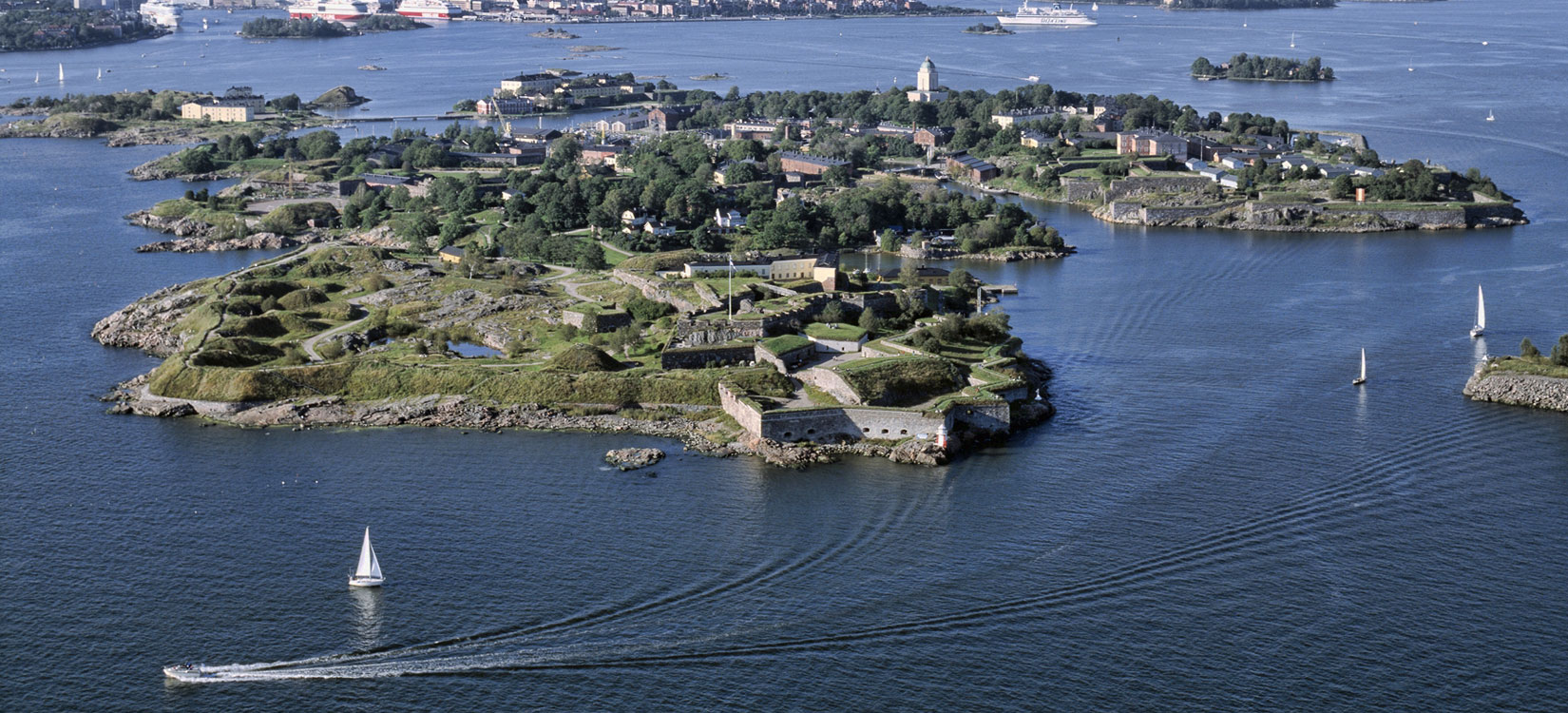
The UNESCO World Heritage and Sustainable Tourism Programme represents a new approach based on dialogue and stakeholder cooperation where planning for tourism and heritage management is integrated at a destination level, the natural and cultural assets are valued and protected, and appropriate tourism developed.
World Heritage and tourism stakeholders share responsibility for conservation of our common cultural and natural heritage of Outstanding Universal Value and for sustainable development through appropriate tourism management.
Facilitate the management and development of sustainable tourism at World Heritage properties through fostering increased awareness, capacity and balanced participation of all stakeholders in order to protect the properties and their Outstanding Universal Value.
Focus Areas
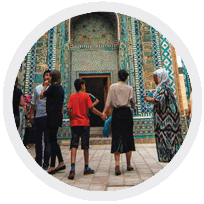
Policy & Strategy
Sustainable tourism policy and strategy development.

Tools & Guidance
Sustainable tourism tools

Capacity Building
Capacity building activities.

Heritage Journeys
Creation of thematic routes to foster heritage based sustainable tourism development
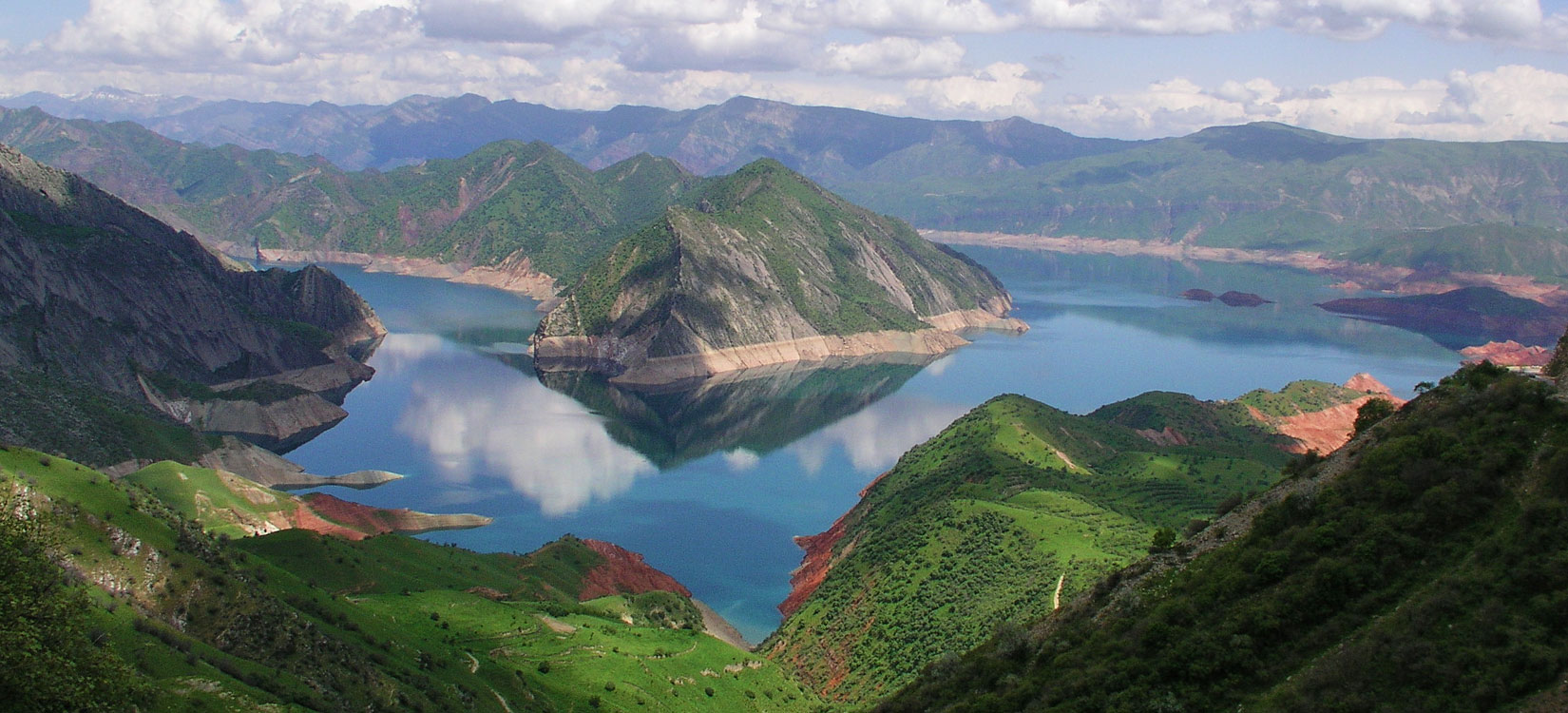
A key goal of the UNESCO WH+ST Programme is to strengthen the enabling environment by advocating policies and frameworks that support sustainable tourism as an important vehicle for managing cultural and natural heritage. Developing strategies through broad stakeholder engagement for the planning, development and management of sustainable tourism that follows a destination approach and focuses on empowering local communities is central to UNESCO’s approach.
Supporting Sustainable Tourism Recovery
Enhancing capacity and resilience in 10 World Heritage communities
Supported by BMZ, and implemented by UNESCO in collaboration with GIZ, this 2 million euro tourism recovery project worked to enhance capacity building in local communities, improve resilience and safeguard heritage.
Policy orientations
Defining the relationship between world heritage and sustainable tourism
Based on the report of the international workshop on Advancing Sustainable Tourism at Natural and Cultural Heritage Sites (Mogao, China, September 2009), the World Heritage Committee at its 34th session adopted the policy orientations which define the relationship between World Heritage and sustainable tourism ( Decision 34 COM 5F.2 ).
World Heritage and Tourism in a Changing Climate
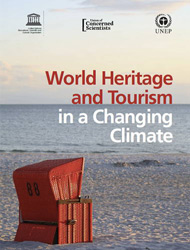
Providing an overview of the increasing vulnerability of World Heritage sites to climate change impacts and the potential implications for and of global tourism.
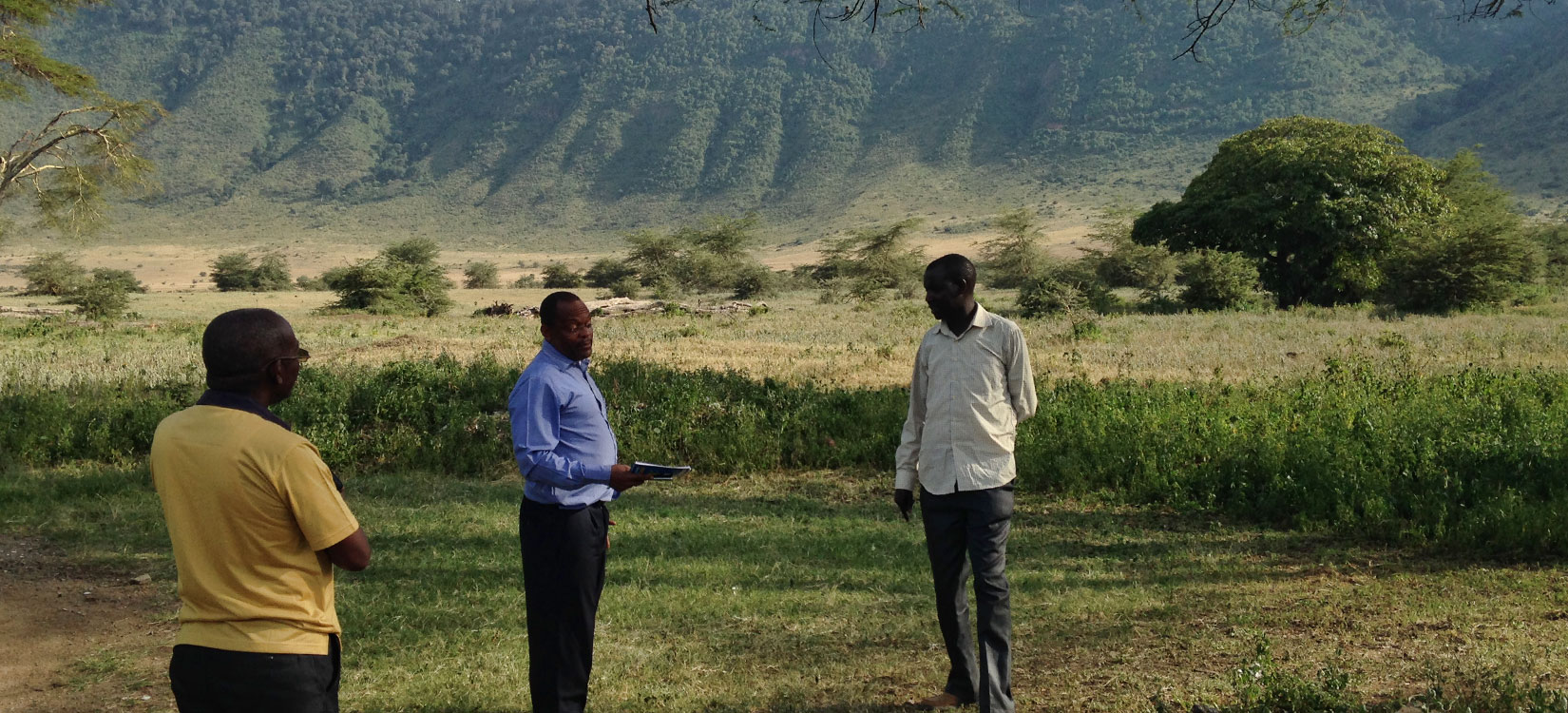
Sustainable Tourism Tools
Manage tourism efficiently, responsibly and sustainably based on the local context and needs

People Protecting Places is the public exchange platform for the World Heritage and Sustainable Tourism Programme, providing education and information, encouraging support, engaging in social and community dialogue

The ' How-To ' guides offer direction and guidance to managers of World Heritage tourism destinations and other stakeholders to help identify the most suitable solutions for circumstances in their local environments and aid in developing general know-how.
English French Russian

Helping site managers and other tourism stakeholders to manage tourism more sustainably
Capacity Building in 4 Africa Nature Sites
A series of practical training and workshops were organized in four priority natural World Heritage sites in Africa (Lesotho, Malawi, South Africa, Tanzania, Zambia and Zimbabwe) with the aim of providing capacity building tools and strategies for site managers to help them manage tourism at their sites more sustainably.
Learn more →
15 Pilot Sites in Nordic-Baltic Region
The project Towards a Nordic-Baltic pilot region for World Heritage and Sustainable Tourism (2012-2014) was initiated by the Nordic World Heritage Foundation (NWHF). With a practical approach, the project has contributed to tools for assessing and developing sustainable World Heritage tourism strategies with stakeholder involvement and cooperation.
Supporting Community-Based Management and Sustainable Tourism at World Heritage sites in South-East Asia
Entitled “The Power of Culture: Supporting Community-Based Management and Sustainable Tourism at World Heritage sites in South-East Asia", the UNESCO Office in Jakarta with the technical assistance of the UNESCO World Heritage and Sustainable Tourism Programme and the support from the Government of Malaysia is spearheading the first regional effort in Southeast Asia to introduce a new approach to sustainable tourism management at World Heritage sites in Malaysia, the Philippines and Indonesia.
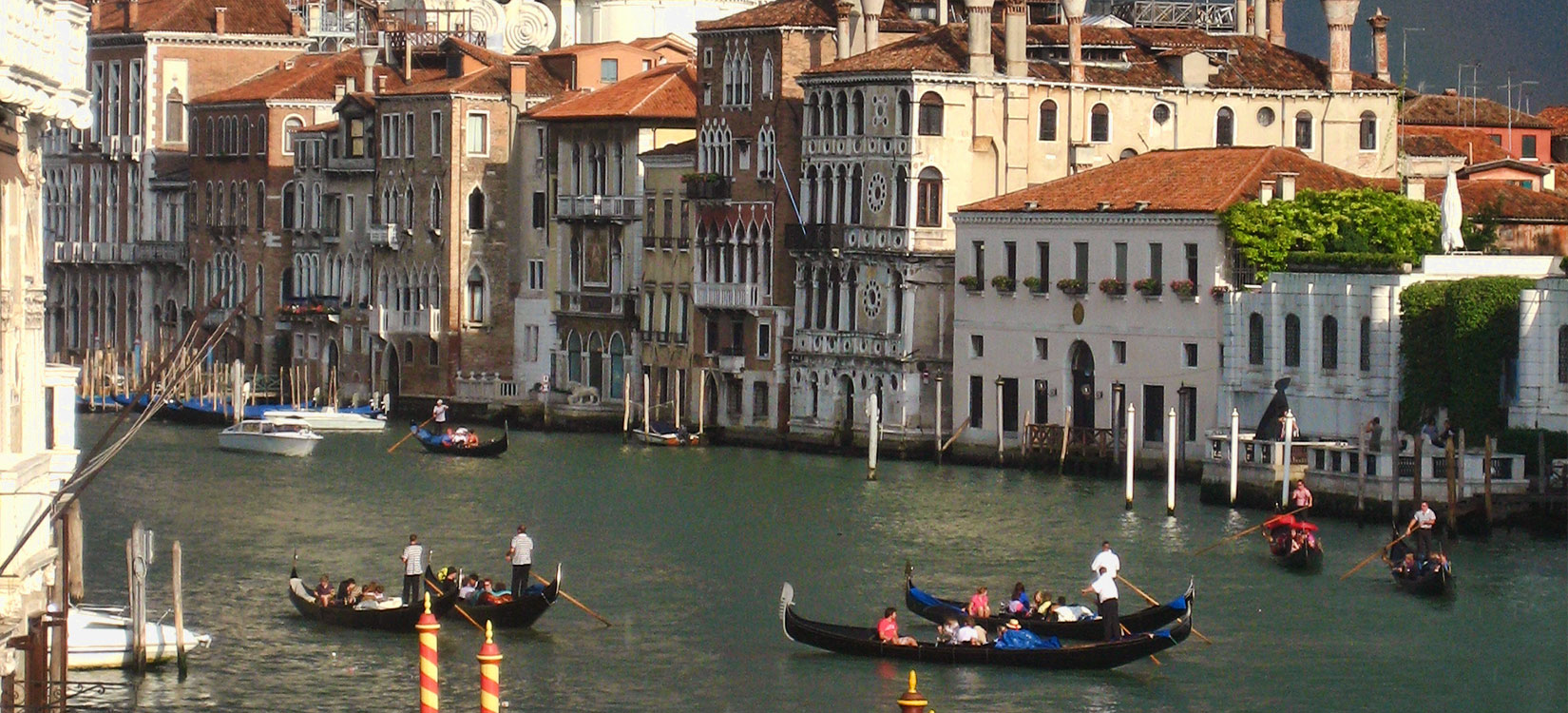
Cultural tourism is one of the largest and fastest-growing global tourism markets. Culture and creative industries are increasingly being used to promote destinations and enhance their competitiveness and attractiveness.
Many locations are now actively developing their cultural assets as a means of developing comparative advantages in an increasingly competitive tourism marketplace, and to create local distinctiveness in the face of globalization.
UNESCO will endeavour to create networks of key stakeholders to coordinate the destination management and marketing associated with the different heritage routes to promote and coordinate high-quality, unique experiences based on UNESCO recognized heritage. The goal is to promote sustainable development based on heritage values and create added tourist value for the sites.
UNESCO World Heritage Journeys of the EU
Creating heritage-based tourism that spurs investment in culture and the creative industries that are community-centered and offer sustainable and high-quality products that play on Europe's comparative advantages and diversity of its cultural assets.
World Heritage Journeys of Buddhist Heritage Sites
UNESCO is currently implementing a project to develop a unique Buddhist Heritage Route for Sustainable Tourism Development in South Asia with the support from the Korea International Cooperation Agency (KOICA). South Asia is host to rich Buddhist heritage that is exemplified in the World Heritage properties across the region.

Programme Background
In 2011 UNESCO embarked on developing a new World Heritage and Sustainable Tourism Programme.
The aim was to create an international framework for the cooperative and coordinated achievement of shared and sustainable outcomes related to tourism at World Heritage properties.
The preparatory work undertaken in developing the Programme responded to the decision 34 COM 5F.2 of the World Heritage Committee at its 34th session in Brasilia in 2010, which requested
“the World Heritage Centre to convene a new and inclusive programme on World Heritage and Sustainable Tourism, with a steering group comprising interested States Parties and other relevant stakeholders, and also requests the World Heritage Centre to outline the objectives and approach to the implementation of this programme".
The Steering Group was comprised of States Parties representatives from the six UNESCO Electoral Groups (Germany (I), Slovenia (II), Argentina (III), China (IV), Tanzania (Va), and Lebanon (Vb)), the Director of the World Heritage Centre, the Advisory Bodies (IUCN, ICOMOS and ICCROM), the United Nations World Tourism Organization (UNWTO) and the Swiss Government as the donor agency.
The Government of Switzerland has provided financial support for specific actions to be undertaken by the Steering Group. To coordinate and support the process, the World Heritage Centre has formed a small Working Group with the support of the Nordic World Heritage Foundation, the Government of Switzerland and the mandated external consulting firm MartinJenkins.
The World Heritage Committee directed that the Programme take into account:
- the recommendations of the evaluation of the concluded tourism programme ( WHC-10/34.COM/INF.5F.3 )
- the policy orientation which defines the relationship between World Heritage and sustainable tourism that emerged from the workshop Advancing Sustainable Tourism at Natural and Cultural Heritage Sites (Mogao, China, September 2009) ( WHC-10/34.COM/INF.5F.1 )
Overarching and strategic processes that the new World Heritage and Sustainable Tourism Programme will be aligned with include the Strategic Objectives of the World Heritage Convention (the five C's) ( Budapest Declaration 2002 ), the ongoing Reflections on the Future of the World Heritage Convention ( WHC-11/35.COM/12A ) and the Strategic Action Plan for the Implementation of the World Heritage Convention 2012-2022 ( WHC-11/18.GA/11 ), the Relationship between the World Heritage Convention and Sustainable Development (WHC-10/34.COM/5D), the World Heritage Capacity Building Strategy ( WHC-10/34.COM/5D ), the Global Strategy for a Representative, Balanced and Credible World Heritage List (1994), and the Evaluation of the Global Strategy and PACT initiative ( WHC-11/18.GA/8 - 2011 ).
In addition, the programme development process has been enriched by an outreach to representatives from the main stakeholder groups including the tourism sector, national and local governments, site practitioners and local communities. The programme design was further developed at an Expert Meeting in Sils/Engadine, Switzerland October 2011. In this meeting over 40 experts from 23 countries, representing the relevant stakeholder groups, worked together to identify the overall strategic approach and a prioritised set of key objectives and activities. The proposed Programme was adopted by the World Heritage Committee in 2012 at its 36th session in St Petersburg, Russian Federation .
International Instruments
International Instruments Relating to Sustainable Development and Tourism.
Resolutions adopted by the United Nations, charters adopted by ICOMOS, decisions adopted by the World Heritage Committee, legal instruments adopted by UNESCO on heritage preservation.
Resolutions adopted by the United Nations
- Report by the Department of Economics and Social Affairs: Tourism and Sustainable Development: The Global Importance of Tourism at the United Nations’ Commission on Sustainable Development 7th Session (1999)
- Resolution A/RES/56/212 and the Global Code of Ethics for Tourism adopted by the United Nations World Tourism Organization (1999)
Charters adopted by ICOMOS
- The ICOMOS International Cultural Tourism Charter (1999)
- The ICOMOS Charter for the Interpretation and Presentation of Cultural Heritage Sites (2008)
Decisions adopted by the World Heritage Committee
- Decision (XVII.4-XVII.12) adopted by the World Heritage Committee at its 25th Session in Helsinki (2001)
- Decision 33 COM 5A adopted by the World Heritage Committee at its 30th Session in Seville (2009)
- Decision 34 COM 5F.2 adopted by the World Heritage Committee at its 34th Session in Brasilia (2010)
- Decision 36 COM 5E adopted by the World Heritage Committee at its 36th Session in Saint Petersburg (2012)
Legal instruments adopted by UNESCO on heritage preservation in chronological order
- Convention on the Means of Prohibiting and Preventing the Illicit Import, Export and Transfer of Ownership of Cultural Property (1970)
- The Recommendation for the Protection of Movable Cultural Property (1978)
- The Recommendation on the Safeguarding of Traditional Culture and Folklore (1989)
- The Convention on the Protection of the Underwater Cultural heritage (2001)
- The Convention on the Protection and Promotion of the Diversity of Cultural Expressions (2005)
Other instruments
- Other instruments OECD Tourism Trends and Policies 2012 (French forthcoming)
- Programme on Sustainable Consumption and Production (In English)
- Siem Reap Declaration on Tourism and Culture 2015 – Building a New Partnership Model
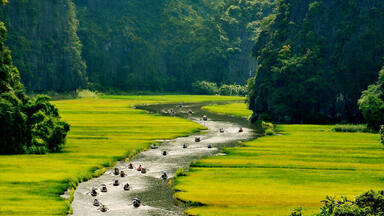
Decisions / Resolutions (5)
The World Heritage Committee,
- Having examined Document WHC/18/42.COM/5A,
- Recalling Decision 41 COM 5A adopted at its 41st session (Krakow, 2017) and Decision 40 COM 5D adopted at its 40th session (Istanbul/UNESCO, 2016), General:
- Takes note with appreciation of the activities undertaken by the World Heritage Centre over the past year in pursuit of the Expected Result to ensure that “tangible heritage is identified, protected, monitored and sustainably managed by Member States, in particular through the effective implementation of the 1972 Convention ”, and the five strategic objectives as presented in Document WHC/18/42.COM/5A;
- Welcomes the proactive role of the Secretariat for enhancing synergies between the World Heritage Convention and the other Culture and Biodiversity-related Conventions, particularly the integration of relevant synergies aspects in the revised Periodic Reporting Format and the launch of a synergy-related web page on the Centre’s website;
- Also welcomes the increased collaboration among the Biodiversity-related Conventions through the Biodiversity Liaison Group and focused activities, including workshops, joint statements and awareness-raising;
- Takes note of the Thematic studies on the recognition of associative values using World Heritage criterion (vi) and on interpretation of sites of memory, funded respectively by Germany and the Republic of Korea and encourages all States Parties to take on board their findings and recommendations, in the framework of the identification of sites, as well as management and interpretation of World Heritage properties;
- Noting the discussion paper by ICOMOS on Evaluations of World Heritage Nominations related to Sites Associated with Memories of Recent Conflicts, decides to convene an Expert Meeting on sites associated with memories of recent conflicts to allow for both philosophical and practical reflections on the nature of memorialization, the value of evolving memories, the inter-relationship between material and immaterial attributes in relation to memory, and the issue of stakeholder consultation; and to develop guidance on whether and how these sites might relate to the purpose and scope of the World Heritage Convention , provided that extra-budgetary funding is available and invites the States Parties to contribute financially to this end;
- Also invites the States Parties to support the activities carried out by the World Heritage Centre for the implementation of the Convention ;
- Requests the World Heritage Centre to present, at its 43rd session, a report on its activities. Thematic Programmes:
- Welcomes the progress report on the implementation of the World Heritage Thematic Programmes and Initiatives, notes their important contribution towards implementation of the Global Strategy for representative World Heritage List, and thanks all States Parties, donors and other organizations for having contributed to achieving their objectives;
- Acknowledges the results achieved by the World Heritage Cities Programme and calls States Parties and other stakeholders to provide human and financial resources ensuring the continuation of this Programme in view of its crucial importance for the conservation of the urban heritage inscribed on the World Heritage List, for the implementation of the Recommendation on the Historic Urban Landscape and its contribution to achieving the 2030 Sustainable Development Goals related to cities as well as for its contribution to the preparation of the New Urban Agenda, and further thanks to China and Croatia for their support for the implementation of the Programme;
- Also acknowledges the results achieved of the World Heritage Marine Programme, also thanks Flanders, France and the Annenberg Foundation for their support, notes the increased focus of the Programme on a global managers network, climate change adaptation strategies and sustainable fisheries, and invites States Parties, the World Heritage Centre and other stakeholders to continue to provide human and financial resources to support for the implementation of the Programme;
- Further acknowledges the results achieved in the implementation of the World Heritage Sustainable Tourism Programme, in particular the development of the Sustainable Tourism and Visitor Management Assessment tool and encourages States Parties to participate in the pilot testing of the tool, expresses appreciation for the funding provided by the European Commission and further thanks the Republic of Korea, Norway, and Seabourn Cruise Line for their support in the implementation of the Programme’’s activities;
- Further notes the progress in the implementation of the Small Island Developing States Programme, its importance for a representative, credible and balanced World Heritage List and building capacity of site managers and stakeholders to implement the World Heritage Convention , thanks furthermore Japan and the Netherlands for their support as well as the International Centre on Space Technology for Natural and Cultural Heritage (HIST) and the World Heritage Institute of Training & Research for the Asia & the Pacific Region (WHITRAP) as Category 2 Centres for their technical and financial supports and also requests the States Parties and other stakeholders to continue to provide human, financial and technical resources for the implementation of the Programme;
- Takes note of the activities implemented jointly by the International Astronomical Union (IAU) and ICOMOS under the institutional guidance of the World Heritage Centre, in line with its Decision 40 COM 5D, further requests the World Heritage Centre to disseminate among the States Parties the second volume of the IAU/ICOMOS Thematic Study on Astronomical Heritage and renames this initiative as Initiative on Heritage of Astronomy, Science and Technology;
- Also takes note of the progress report on the Initiative on Heritage of Religious Interest, endorses the recommendations of the Thematic Expert Consultation meetings focused on Mediterranean and South-Eastern Europe (UNESCO, 2016), Asia-Pacific (Thailand, 2017) and Eastern Europe (Armenia, 2018), thanks the States Parties for their generous contribution and reiterates its invitation to States Parties and other stakeholders to continue to support this Initiative, as well as its associated Marketplace projects developed by the World Heritage Centre;
- Takes note of the activities implemented by CRATerre in the framework of the World Heritage Earthen Architecture Programme, under the overall institutional guidance of the World Heritage Centre, and of the lines of action proposed for the future, if funding is available;
- Invites States Parties, international organizations and donors to contribute financially to the Thematic Programmes and Initiatives as the implementation of thematic priorities is no longer feasible without extra-budgetary funding;
- Requests furthermore the World Heritage Centre to submit an updated result-based report on Thematic Programmes and Initiatives, under Item 5A: Report of the World Heritage Centre on its activities, for examination by the World Heritage Committee at its 44th session in 2020.
1. Having examined document WHC-12/36.COM/5E,
2. Recalling Decision 34 COM 5F.2 adopted at its 34th session (Brasilia, 2010),
3. Welcomes the finalization of the new and inclusive Programme on World Heritage and Sustainable Tourism and notes with appreciation the participatory process for its development, objectives and approach towards implementation;
4. Also welcomes the contribution of the Steering Group comprised of States Parties representatives from the UNESCO Electoral Groups, the World Heritage Centre, the Advisory Bodies (IUCN, ICOMOS, ICCROM), Switzerland and the United Nations World Tourism Organisation (UNWTO) in the elaboration of the Programme;
5. Thanks the Government of Switzerland, the United Nations Foundation and the Nordic World Heritage Foundation for their technical and financial support to the elaboration of the Programme;
6. Notes with appreciation the contribution provided by the States Parties and other consulted stakeholders during the consultation phase of the Programme;
7. Takes note of the results of the Expert Meeting in Sils/Engadin (Switzerland), from 18 to 22 October 2011 contributing to the Programme, and further thanks the Government of Switzerland for hosting the Expert Meeting;
8. Adopts the World Heritage and Sustainable Tourism Programme;
9. Requests the World Heritage Centre to refine the Draft Action Plan 2013-2015 in an Annex to the present document and to implement the Programme with a Steering Group comprised of representatives of the UNESCO Electoral Groups, donor agencies, the Advisory Bodies, UNWTO and in collaboration with interested stakeholders;
10. Notes that financial resources for the coordination and implementation of the Programme do not exist and also requests States Parties to support the implementation of the World Heritage and Sustainable Tourism Programme;
11. Further requests the World Heritage Centre to report biennially on the progress of the implementation of the Programme;
12. Notes with appreciation the launch of the Programme foreseen at the 40th Anniversary of the World Heritage Convention event in Kyoto, Japan, in November 2012
1. Having examined Document WHC-10/34.COM/INF.5F.1 and WHC-10/34.COM/INF.5F.3,
2. Highlighting that the global tourism sector is large and rapidly growing, is diverse and dynamic in its business models and structures, and the relationship between World Heritage and tourism is two way: tourism, if managed well, offers benefits to World Heritage properties and can contribute to cross-cultural exchange but, if not managed well, poses challenges to these properties and recognizing the increasing challenges and opportunities relating to tourism;
3. Expresses its appreciation to the States Parties of Australia, China, France, India, Sweden, Switzerland and the United Kingdom, and to the United Nations Foundation and the Nordic World Heritage Foundation for the financial and technical support to the World Heritage Tourism Programme since its establishment in 2001;
4. Welcomes the report of the international workshop on Advancing Sustainable Tourism at Natural and Cultural Heritage Sites (Mogao, China, September 2009) and adopts the policy orientation which defines the relationship between World Heritage and sustainable tourism ( Attachment A );
5. Takes note of the evaluation of the World Heritage Tourism Programme by the UN Foundation, and encourages the World Heritage Centre to take fully into account the eight programme elements recommended in the draft final report in any future work on tourism ( Attachment B );
6. Decides to conclude the World Heritage Tourism Programme and requests the World Heritage Centre to convene a new and inclusive programme on World Heritage and Sustainable Tourism, with a steering group comprising interested States Parties and other relevant stakeholders, and also requests the World Heritage Centre to outline the objectives and approach to implementation of this programme, drawing on the directions established in the reports identified in Paragraphs 4 and 5 above, for consideration at the 35th session of the World Heritage Committee (2011);
7. Also welcomes the offer of the Government of Switzerland to provide financial and technical support to specific activities supporting the steering group; further welcomes the offer of the Governments of Sweden, Norway and Denmark to organize a Nordic-Baltic regional workshop in Visby, Gotland, Sweden in October 2010 on World Heritage and sustainable tourism; and also encourages States Parties to support the new programme on World Heritage and Sustainable Tourism including through regional events and the publication of materials identifying good practices;
8. Based upon the experience gained under the World Heritage Convention of issues related to tourism, invites the Director General of UNESCO to consider the feasibility of a Recommendation on the relationship between heritage conservation and sustainable tourism.
Attachment A
Recommendations of the international workshop
on Advancing Sustainable Tourism at Natural and Cultural Heritage Sites
Policy orientations: defining the relationship between World Heritage and tourism
1. The tourism sector
The global tourism sector is large and rapidly growing, is diverse and dynamic in its business models and structures.
Tourists/visitors are diverse in terms of cultural background, interests, behaviour, economy, impact, awareness and expectations of World Heritage.
There is no one single way for the World Heritage Convention , or World Heritage properties, to engage with the tourism sector or with tourists/visitors.
2. The relationship between World Heritage and tourism
The relationship between World Heritage and tourism is two-way:
a. World Heritage offers tourists/visitors and the tourism sector destinations
b. Tourism offers World Heritage the ability to meet the requirement in the Convention to 'present' World Heritage properties, and also a means to realise community and economic benefits through sustainable use.
Tourism is critical for World Heritage:
a. For States Parties and their individual properties,
i. to meet the requirement in the Convention to 'present' World Heritage
ii. to realise community and economic benefits
b. For the World Heritage Convention as a whole, as the means by which World Heritage properties are experienced by visitors travelling nationally and internationally
c. As a major means by which the performance of World Heritage properties, and therefore the standing of the Convention , is judged,
i. many World Heritage properties do not identify themselves as such, or do not adequately present their Outstanding Universal Value
ii. it would be beneficial to develop indicators of the quality of presentation, and the representation of the World Heritage brand
d. As a credibility issue in relation to: i. the potential for tourism infrastructure to damage Outstanding Universal Value
i. the threat that World Heritage properties may be unsustainably managed in relation to their adjoining communities
ii. sustaining the conservation objectives of the Convention whilst engaging with economic development
iii. realistic aspirations that World Heritage can attract tourism.
World Heritage is a major resource for the tourism sector:
a. Almost all individual World Heritage properties are significant tourism destinations
b. The World Heritage brand can attract tourists/visitors,
i. the World Heritage brand has more impact upon tourism to lesser known properties than to iconic properties.
Tourism, if managed well, offers benefits to World Heritage properties:
a. to meet the requirement in Article 4 of the Convention to present World Heritage to current and future generations
b. to realise economic benefits.
Tourism, if not managed well, poses threats to World Heritage properties.
3. The responses of World Heritage to tourism
The impact of tourism, and the management response, is different for each World Heritage property: World Heritage properties have many options to manage the impacts of tourism.
The management responses of World Heritage properties need to:
a. work closely with the tourism sector
b. be informed by the experiences of tourists/visitors to the visitation of the property
c. include local communities in the planning and management of all aspects of properties, including tourism.
While there are many excellent examples of World Heritage properties successfully managing their relationship to tourism, it is also clear that many properties could improve:
a. the prevention and management of tourism threats and impacts
b. their relationship to the tourism sector inside and outside the property
c. their interaction with local communities inside and outside the property
d. their presentation of Outstanding Universal Value and focus upon the experience of tourists/visitors.
a. be based on the protection and conservation of the Outstanding Universal Value of the property, and its effective and authentic presentation
b. work closely with the tourism sector
c. be informed by the experiences of tourists/visitors to the visitation of the property
d. to include local communities in the planning and management of all aspects of properties, including tourism.
4. Responsibilities of different actors in relation to World Heritage and tourism
The World Heritage Convention (World Heritage Committee, World Heritage Centre, Advisory Bodies):
a. set frameworks and policy approaches
b. confirm that properties have adequate mechanisms to address tourism before they are inscribed on the World Heritage List
i. develop guidance on the expectations to be include in management plans
c. monitor the impact upon OUV of tourism activities at inscribed sites, including through indicators for state of conservation reporting
d. cooperate with other international organisations to enable:
i. other international organisations to integrate World Heritage considerations in their programs
ii. all parties involved in World Heritage to learn from the activities of other international organisations
e. assist State Parties and sites to access support and advice on good practices
f. reward best practice examples of World Heritage properties and businesses within the tourist/visitor sector
g. develop guidance on the use of the World Heritage emblem as part of site branding.
Individual States Parties:
a. develop national policies for protection
b. develop national policies for promotion
c. engage with their sites to provide and enable support, and to ensure that the promotion and the tourism objectives respect Outstanding Universal Value and are appropriate and sustainable
d. ensure that individual World Heritage properties within their territory do not have their OUV negatively affected by tourism.
Individual property managers:
a. manage the impact of tourism upon the OUV of properties
i. common tools at properties include fees, charges, schedules of opening and restrictions on access
b. lead onsite presentation and provide meaningful visitor experiences
c. work with the tourist/visitor sector, and be aware of the needs and experiences of tourists/visitors, to best protect the property
i. the best point of engagement between the World Heritage Convention and the tourism sector as a whole is at the direct site level, or within countries
d. engage with communities and business on conservation and development.
Tourism sector:
a. work with World Heritage property managers to help protect Outstanding Universal Value
b. recognize and engage in shared responsibility to sustain World Heritage properties as tourism resources
c. work on authentic presentation and quality experiences.
Individual tourists/visitors with the assistance of World Heritage property managers and the tourism sector, can be helped to appreciate and protect the OUV of World Heritage properties.
Attachment B
Programme elements recommended by the Draft Final Report of the Evaluation of the World Heritage Tourism Programme by the UN Foundation:
1. Adopt and disseminate standards and principles relating to sustainable tourism at World Heritage sites;
2. Support the incorporation of appropriate tourism management into the workings of the Convention ;
3. Collation of evidence to support sustainable tourism programme design, and to support targeting;
4. Contribution of a World Heritage perspective to cross agency sustainable tourism policy initiatives;
5. Strategic support for the dissemination of lessons learned;
6. Strategic support for the development of training and guidance materials for national policy agencies and site managers;
7. Provision of advice on the cost benefit impact of World Heritage inscription;
8. Provision of advice on UNESCO World Heritage branding.
1. Having examined Documents WHC-09/33.COM/5A, WHC- 09/33.COM/INF.5A.1, WHC-09/33.COM/INF.5A.2, and WHC-09/33.COM/INF.5A.3 ,
2. Recalling Decision 32 COM 5 adopted at its 32nd session (Quebec City, 2008),
3. Takes note with appreciation of the activities undertaken by the World Heritage Centre over the past year in pursuit of the Committee's five Strategic Objectives;
4. Takes also note of the findings of the study undertaken by UNESCO's Internal Oversight Service on the mapping of the workload of the World Heritage Centre presented in Document WHC-09/33.COM/INF.5A.3;
5. Notes with satisfaction that the World Heritage Centre is working with the secretariats of intergovernmental committees of related conventions such as the Convention for the Safeguarding of Intangible Cultural Heritage , and the Convention for the Protection of the Underwater Cultural Heritage-2001 and recommends that such cooperation be encouraged as this would further strengthen the work of the Centre;
6. Requests the World Heritage Centre to prepare a document on the World Heritage Convention and its cooperation and exchange with other conventions and programmes in the field of cultural heritage for discussion at the 34th session of the World Heritage Committee (2010);
7. Also requests the World Heritage Centre, in future reports on activities undertaken, to further strengthen the information and analysis available to States Parties by:
a) Retaining the current format to report activities and including an update on progress with implementing the Committee's decisions,
b) Describing the criteria by which the World Heritage Centre makes decisions as to which activities under the Convention it undertakes,
c) And including, on a discretionary basis, analysis of strategic issues and new directions;
8. Further requests the World Heritage Centre to produce, on an experimental basis, an indexed audio verbatim recording of the proceedings of the 33rd Session in addition to the standard summary records (as produced since the 26th session of the World Heritage Committee);
9. Notes the outline provided by the World Heritage Centre of its roles and the roles of the Advisory Bodies and agrees that this topic be further discussed at the 34th session of the Committee in 2010 under a separate agenda item;
10. Requests furthermore the World Heritage Centre to outline the forward direction of the World Heritage thematic programmes and initiatives, to enable an understanding of how these themes connect with and integrate into general programmes, and how they might be resourced;
11. Notes that the Centre already proactively engages women in its Heritage Programmes in Asia, Africa and the Caribbean as part of its gender balance policy and the provision of equal opportunity to all, and recommends that gender balance and community involvement be prioritized in the Centre's programmes;
12. Adopts the World Heritage Thematic Programme on Prehistory presented in Annex 1 of document WHC-09/33.COM/5A ;
13. Requests the World Heritage Centre to reconsider the term "prehistory", to better recognize the continuing cultures of indigenous communities, to ensure global representation in the identification and conservation of related properties, and to present a report on progress in developing an Action Plan on Prehistory and World Heritage at its 34th session in 2010;
14. Notes with concern the ongoing destruction of some of these fragile sites, including the recent destruction of the Rock Art sites of Tardrat Acacus in Libya, and requests the State Party to take immediate action and other measures as necessary to address the problem in consultation with the World Heritage Centre and to invite a joint World Heritage Centre / ICOMOS mission;
15. Expresses its gratitude to the Governments of Bahrain, South Africa and Spain for the financial and technical support for the various international scientific encounters, and recognizes the proposal of the Government of Spain in establishing a centre for the research of Prehistory;
16. Recalling the Decision of the World Heritage Committee 31 COM.21C to carry out a programme of sustainable development concerning the conservation of earthen architecture, thanks the Governments of Italy and France for their support of the programme on earthen architecture in Africa and the Arab States in particular, and requests the potential financial donors and the States Parties to support the implementation of activities and further requests the World Heritage Centre to submit a progress report at its 35th session in 2011;
17. Takes note of the progress report on the World Heritage Tourism Programme;
18. Thanks the Governments of Australia, China, France, India, Switzerland and United Kingdom, who have worked in close collaboration with the World Heritage Centre and the Advisory Bodies, the World Tourism Organization and other partners, for contributing to the Initiative of Sustainable Tourism;
19. Expresses its gratitude to the Governments of Australia and China for the organization of a workshop on sustainable tourism at the World Heritage site, Mogao Caves, China, in September-October 2009 and requests that the following elements be submitted to the Committee for examination at its 34th session in 2010:
a) A report on the workshop,
b) The subsequent recommendations of the workshop regarding the adoption of best practices policy guidance, and concerning the changes proposed for the Operational Guidelines for the implementation of the World Heritage Convention ,
c) A document concerning the progress of the World Heritage Programme on Tourism;
20. Finally requests the Director of the World Heritage Centre to identify supplementary sources of funding to put into place a sufficient number of staff and resources at the World Heritage Centre and the Advisory Bodies in order to continue to efficiently contribute to the resolution of problems related to World Heritage conservation.
XVII.8 The Secretariat provided the following justifications for the selection:
- Tourism - growing threats on World Heritage sites from tourism which, if sustainably managed could offer socio-economic development opportunities;
- Forests - since close to 60 of the natural sites on the World Heritage List are forests and that the lessons being learned from the large-scale UNESCO-UN Foundation projects in the tropical forest sites in the Democratic Republic of the Congo can serve as case studies to enrich the programme;
- Cities - since close to 200 of the cultural sites on the List are historic centres or entire cities, and because 20% of the Fund's international assistance have served to address the challenge of urban heritage conservation;
- Earthen structures - since some 30 of the cultural sites on the List are included in this category, and due to the particularity of conservation of earthen heritage, and threats.
XVII.10 The Committee expressed its appreciation for the clarity of the presentation and the justifications provided. Indicating strong support for the overall programming approach, the Committee however indicated the need for the programme to respond to the priorities established by the Committee and to create strong links with the results of the Global Strategy actions and Periodic Reporting. The Committee approved the four proposed themes of the programmes in this first series of initiatives and authorized the Centre to proceed in their development.

What is cultural tourism and why is it growing?
Disclaimer: Some posts on Tourism Teacher may contain affiliate links. If you appreciate this content, you can show your support by making a purchase through these links or by buying me a coffee . Thank you for your support!
Cultural tourism is big business. Some people seek to embark on their travels with the sole intention of having a ‘cultural’ experience, whereas others may experience culture as a byproduct of their trip. We can argue that there is some form of cultural tourism in most holidays (even when taking an all-inclusive holiday you might try to local beer, for example).
But what do we mean by the term ‘cultural tourism’? What’s it all about? In this post I will explain what is meant by the term cultural tourism, providing a range of academic definitions. I will also explain what the different types of cultural tourists are, give examples of cultural tourism activities and discuss the impacts of cultural tourism. Lastly, I will provide a brief summary of some popular cultural tourism destinations.
What is cultural tourism?
Cultural tourism is the act of travellers visiting particular destinations in order to experience and learn about a particular culture . This can include many activities such as; attending events and festivals, visiting museums and tasting the local food and drinks.
Cultural tourism can also be an unintentional part of the tourism experience, whereby cultural immersion (with the local people, their language, customs, cuisine etc) is an inevitable part of a person’s holiday.
Cultural tourism definitions
It has been suggested that tourism is the ideal arena in which to investigate the nature of cultural production (MacCannell, 1976). Tourism provides endless opportunities to learn about the way other people live, about their society and their traditions. Whether you are attending the Running of the Bulls Festival in Pamplona , visiting the pyramids in ancient Egypt , taking a tour of the tea plantations in China or enjoying the locally brewed Ouzo on your all-inclusive holiday to Greece, you will inevitably encounter some form of cultural tourism as part of your holiday experience.
The World Tourism Organisation (WTO) (1985) broadly define cultural tourism as the movements of persons who satisfy the human need for diversity, tending to raise the cultural level of the individual and giving rise to new knowledge, experience and encounters. Cultural tourism is commonly associated with education in this way, some describing it more narrowly as educational cultural tourism (e.g. Bualis and Costa, 2006; Harner and Swarbrooke, 2007; Richards, 2005).
Although a common, more specific definition has not been agreed amongst academics due to the complexity and subjectivity of the term, there do appear to be two distinct viewpoints. The first focusses upon the consumption of cultural products such as sites or monuments (Bonink, 1992; Munsters, 1994), and the second comprises all aspects of travel, where travellers learn about the history and heritage of others or about their contemporary ways of life or thought (MacIntosh and Goeldner, 1986).
Csapo (2012) pertains that the umbrella term of cultural tourism can encompass a number of tourism forms including heritage (material e.g. historic buildings and non-material e.g. literature, arts), cultural thematic routes (e.g. spiritual, gastronomic, linguistic), cultural city tourism, traditions/ethnic tourism, events and festivals, religious tourism and creative culture (e.g. performing arts, crafts).

Types of cultural tourists
In attempt to understand the scope of cultural tourism academics have developed a number of typologies, usually based upon the tourist’s level of motivation.
Bywater (1993) differentiated tourists according to whether they were culturally interested, motivated or inspired.
Culturally interested tourists demonstrate a general interest in culture and consume cultural attractions casually as part of a holiday rather than consciously planning to do so.
Culturally motivated tourists consume culture as a major part of their trip, but do not choose their destination on the basis of specific cultural experiences, whereas for culturally inspired tourists culture is the main goal of their holiday.
A more complex typology was proposed by McKercher and Du Cros (2002), who defined tourists based upon the depth of the cultural experience sought, distinguishing them in to one of five hierarchical categories.
The first is the purposeful cultural tourist for whom cultural tourism is their primary motive for travel. These tourists have a very deep cultural experience.
The second category is the sightseeing cultural tourist for whom cultural tourism is a primary reason for visiting a destination, but the experience is more shallow in nature.
The serendipitous cultural tourist does not travel for cultural reasons, but who, after participating, ends up having a deep cultural tourism experience, whilst the casual cultural tourist is weakly motivated by culture and subsequently has a shallow experience.
Lastly, the incidental cultural tourist is one who does not travel for cultural tourism reasons but nonetheless participates in some activities and has shallow experiences.
Adapting this theory, Petroman et al (2013) segments tourists based upon their preferred cultural activities.
The purposeful cultural tourist, described as according to Mckercher and Du Cros (2002), enjoys learning experiences that challenge them intellectually and visits history museums, art galleries, temples and heritage sites that are less known.
The tour-amateur cultural tourist is akin with the sightseeing cultural tourist above and they often travel long distances, visit remote areas, enjoy tours and wandering through the streets.
The occasional cultural tourist plays a moderate role in the decision of travelling and enjoys an insignificant cultural experience, their preferred activities being to visit attractions and temples that are easy to reach and to explore, although not to the extent that the tour-amateur cultural tourist does.
The incidental cultural tourist plays a small or no role in the decision to travel and enjoys an insignificant cultural experience, whilst visiting attractions that area within easy reach and heritage theme parks.
The last segment is the accidental cultural tourist, who plays a small or no role in the decision to travel but enjoys a deep cultural experience. This tourist type is diverse and as such has no preferred activities attributed to it.
Importance of cultural tourism
Cultural tourism is important for many reasons. Perhaps the most prominent reason is the social impact that it brings.
Cultural tourism can help reinforce identities, enhance cross cultural understanding and preserve the heritage and culture of an area. I have discussed these advantages at length in my post The Social Impacts of Tourism , so you may want to head over there for more detail.
Cultural tourism can also have positive economic impacts . Tourists who visit an area to learn more about a culture or who visit cultural tourism attraction, such as museums or shows, during their trip help to contribute to the economy of the area. Attractions must be staffed, bringing with it employment prospects and tertiary businesses can also benefit, such as restaurants, taxi firms and hotels.
Furthermore, for those seeking a deep cultural experience, options such as homestays can have positive economic benefits to the members of the community who host the tourists.
Read also: Overtourism explained: What, why and where
Personally, I think that one of the most important benefits of cultural tourism is the educational aspect. Tourists and hosts alike can learn more about different ways of life. This can help to broaden one’s mind, it can help one to think differently and to be more objective. These are qualities that can have many positive effects on a person and which can contribute to making them more employable in the future.
Cultural tourism activities
Whether a tourist is seeking a deep cultural experience or otherwise, there are a wide range of activities that can be classified as cultural tourism. Here are a few examples:
- Staying with a local family in a homestay
- Having a tour around a village or town
- Learning about local employment, for example through a tour of a tea plantation or factory
- Undertaking volunteer work in the local community
- Taking a course such as cooking, art, embroidery etc
- Visiting a museum
- Visiting a religious building, such as a Mosque
- Socialising with members of the local community
- Visiting a local market or shopping area
- Trying the local food and drink
- Going to a cultural show or performance
- Visiting historic monuments
Impacts of cultural tourism
There are a range of impacts resulting from cultural tourism activities, both good and bad. Here are some of the most common examples:
Positive impacts of cultural tourism
Revitalisation of culture and art.
Some destinations will encourage local cultures and arts to be revitalised. This may be in the form of museum exhibitions, in the way that restaurants and shops are decorated and in the entertainment on offer, for example.
This may help promote traditions that may have become distant.
Preservation of Heritage
Many tourists will visit the destination especially to see its local heritage. It is for this reason that many destinations will make every effort to preserve its heritage.
This could include putting restrictions in place or limiting tourist numbers, if necessary. This is often an example of careful tourism planning and sustainable tourism management.
This text by Hyung You Park explains the principles of heritage tourism in more detail.
Negative impacts of cultural tourism
Social change.
Social change is basically referring to changes in the way that society acts or behaves. Unfortunately, there are many changes that come about as a result of tourism that are not desirable.
There are many examples throughout the world where local populations have changed because of tourism. Perhaps they have changed the way that they speak or the way that they dress. Perhaps they have been introduced to alcohol through the tourism industry or they have become resentful of rich tourists and turned to crime. These are just a few examples of the negative social impacts of tourism.
Read also: Business tourism explained: What, why and where
Globalisation and the destruction of preservation and heritage.
Globalisation is the way in which the world is becoming increasingly connected. We are losing our individuality and gaining a sense of ‘global being’, whereby we more and more alike than ever before.
Globalisation is inevitable in the tourism industry because of the interaction between tourists and hosts, which typically come from different geographic and cultural backgrounds. It is this interaction that encourage us to become more alike.
Standardisation and Commercialisation
Similarly, destinations risk standardisation in the process of satisfying tourists’ desires for familiar facilities and experiences.
While landscape, accommodation, food and drinks, etc., must meet the tourists’ desire for the new and unfamiliar, they must at the same time not be too new or strange because few tourists are actually looking for completely new things (think again about the toilet example I have previously).
Tourists often look for recognisable facilities in an unfamiliar environment, like well-known fast-food restaurants and hotel chains. Tourist like some things to be standardised (the toilet, their breakfast, their drinks, the language spoken etc), but others to be different (dinner options, music, weather, tourist attractions etc).
Loss of Authenticity
Along similar lines to globalisation is the loss of authenticity that often results from tourism.
Authenticity is essentially something that is original or unchanged. It is not fake or reproduced in any way.
The Western world believe that a tourist destination is no longer authentic when their cultural values and traditions change. But I would argue is this not natural? Is culture suppose to stay the same or it suppose to evolve throughout each generation?
Take a look at the likes of the long neck tribe in Thailand or the Maasai Tribe in Africa. These are two examples of cultures which have remained ‘unchanged’ for the sole purpose of tourism. They appear not to have changed the way that they dress, they way that they speak or the way that they act in generations, all for the purpose of tourism.
You can learn more about what is authenticity in tourism here or see some examples of staged authenticity in this post.
Culture clashes
Because tourism involves movement of people to different geographical locations cultural clashes can take place as a result of differences in cultures, ethnic and religious groups, values, lifestyles, languages and levels of prosperity.
Read also: Environmental impacts of tourism
The attitude of local residents towards tourism development may unfold through the stages of euphoria, where visitors are very welcome, through apathy, irritation and potentially antagonism when anti-tourist attitudes begin to grow among local people. This is represented in Doxey’s Irritation Index, as shown below.

Tourist-host relationships
Culture clashes can also be exasperated by the fundamental differences in culture between the hosts and the tourists.
There is likely to be economic inequality between locals and tourists who are spending more than they usually do at home. This can cause resentment from the hosts towards the tourists, particularly when they see them wearing expensive jewellery or using plush cameras etc that they know they can’t afford themselves.
Further to this, tourists often, out of ignorance or carelessness, fail to respect local customs and moral values.
There are many examples of ways that tourists offend the local population , often unintentionally. Did you know that you should never put your back to a Buddha? Or show the sole of your feet to a Thai person? Or show romantic affection in public in the Middle East?
Cultural tourism destinations
Whilst many would argue that cultural tourism is ingrained to some extent in travel to any country, there are some particular destinations that are well-known for their ability to provide tourists with a cultural experience.
Cultural tourism in India
It is impossible not to visit India and experience the culture. Even if you are staying in a 5 star Western all-inclusive hotel in Goa, you will still test Indian curries, be spoken to by Indian workers and see life outside of the hotel on your transfer to and from the airport.
For most people who travel to India, however, cultural tourism is far more than peeking outside of the enclave tourism bubble of their all-inclusive hotel.
Thousands of international tourists visit the Taj Mahal each year. Many more people visit the various Hindu and Buddhist temples scattered throughout the country as well as the various Mosques. Some visit the famous Varanassi to learn about reincarnation.
Most tourists who visit India will try the local dal, eat the fresh mutton and taste chai.
All of these activities are popular cultural tourism activities.
Cultural tourism in Thailand
Thailand is another destination that offers great cultural tourism potential. From the Buddhist temples and monuments and the yoga retreats to homestays and village tours, there are ample cultural tourism opportunities in Thailand .
Cultural tourism in Israel
Israel is popular with religious tourists and those who are taking a religious pilgrimage, as well as leisure tourists. I visited Israel and loved travelling around to see the various sights, from Bethlehem to Jerusalem . I’m not religious in any way, but I loved learning about the history, traditions and cultures.
Cultural tourism in New York
New York is a city that is bustling with culture. It is world famous for its museums and you can learn about anything from World War Two to the Twin Towers here.
Many would argue that shopping is ingrained in the culture of those who live in New York and many tourists will take advantage of the wide selection of products on offer and bargains to be had on their travels to New York.
You can also treat yourself to watching a traditional West End show, trying some of the famous New York Cheesecake and enjoying a cocktail in Times Square!
Cultural tourism in Dubai
Dubai might not be the first destination that comes to mind when you think of cultural tourism, but it does, in fact, have a great offering.
What I find particular intriguing about Dubai is the mix of old and new. One minute you can be exploring the glitz and glamour of the many high-end shopping malls and skyscrapers and the next you can be walking through a traditional Arabian souk.
Cultural tourism: Conclusion
As you can see, there is big business in cultural tourism. With a wide range of types of cultural tourists and types of cultural tourism experiences, this is a tourism sector that has remarkable potential. However, as always, it is imperative to ensure that sustainable tourism practices are utilised to mitigate any negative impacts of cultural tourism.
If you are interested in learning more about topics such as this subscribe to my newsletter ! I send out travel tips, discount coupons and some material designed to get you thinking about the wider impacts of the tourism industry (like this post)- perfect for any tourism student or keen traveller!
Further reading
Want to learn more about cultural tourism? See my recommended reading list below.
- Cultural Tourism – A textbook illustrating how heritage and tourism goals can be integrated in a management and marketing framework to produce sustainable cultural tourism.
- Deconstructing Travel: Cultural Perspectives on Tourism – This book provides an easily understood framework of the relationship between travel and culture in our rapidly changing postmodern, postcolonial world.
- Re-Investing Authenticity: Tourism, Place and Emotions – This ground-breaking book re-thinks and re-invests in the notion of authenticity as a surplus of experiential meaning and feeling that derives from what we do at/in places.
- The Business of Tourism Management – an introduction to key aspects of tourism, and to the practice of managing a tourism business.
- Managing Sustainable Tourism – tackles the tough issues of tourism such as negative environmental impact and cultural degradation, and provides answers that don’t sacrifice positive economic growth.
- Tourism Management: An Introduction – An introductory text that gives its reader a strong understanding of the dimensions of tourism, the industries of which it is comprised, the issues that affect its success, and the management of its impact on destination economies, environments and communities.
- Responsible Tourism: Using tourism for sustainable development – A textbook about the globally vital necessity of realising sustainable tourism.
Liked this article? Click to share!
Advisory Council on Historic Preservation
Each year, millions of travelers visit America’s historic places. The National Trust for Historic Preservation defines heritage tourism as “traveling to experience the places, artifacts, and activities that authentically represent the stories and people of the past and present.” A high percentage of domestic and international travelers participate in cultural and/or heritage activities while traveling, and those that do stay longer, spend more, and travel more often. Heritage tourism creates jobs and business opportunities, helps protect resources, and often improves the quality of life for local residents.
The ACHP has encouraged national travel and tourism policies that promote the international marketing of America’s historic sites as tourism destinations. The ACHP also engages in ongoing efforts to build a more inclusive preservation program, reaching out to diverse communities and groups and engaging them in dialogue about what parts of our national legacy should be more fully recognized, preserved, and shared.
The ACHP developed Preserve America , a national initiative to encourage and support community efforts for the preservation and enjoyment of America’s cultural and natural heritage. In partnership with other federal agencies, the initiative has encouraged the use of historic assets for economic development and community revitalization, as well as enabling people to experience and appreciate local historic resources through heritage tourism and education programs. These goals have been advanced by an Executive Order directing federal agencies to support such efforts, a community designation program, and a recognition program for outstanding stewardship of historic resources by volunteers.
From 2004-2016, over 900 Preserve America Communities were designated in all 50 states, the District of Columbia, and two territories, as well as nearly 60 Preserve America Stewards . Many Preserve America Communities are featured in “Discover Our Shared Heritage” National Register on-line travel itineraries . From 2006 through 2010, the National Park Service (in partnership with the ACHP) awarded more than $21 million in Preserve America Grants to support sustainable historic resource management strategies, with a focus on heritage tourism.
These links are being provided as a convenience and for informational purposes only; if they are not ACHP links, they do not constitute an endorsement or an approval by the ACHP of any of the products, services or opinions of the corporation or organization or individual. The ACHP bears no responsibility for the accuracy, legality, or content of the external site or for that of subsequent links. Please contact the external site for answers to questions regarding its content, including its privacy policies.
Related resources.
Destination Stewardship Center
Extending the work of the national geographic center for sustainable destinations..

Cultural Heritage Tourism
Topic Editor: Lucy Matthews
Heritage, Architecture, Cultures, G astronomy These links provide resources for enhancing the interaction between tourism and the human story of the locale. Scroll down to see Pertinent Findings: The Case for Heritage Tourism.
Cultural tourism is: “A type of tourism activity in which the visitor’s essential motivation is to learn, discover, experience and consume the tangible and intangible cultural attractions/products in a tourism destination. These attractions/products relate to a set of distinctive material, intellectual, spiritual and emotional features of a society that encompasses arts and architecture, historical and cultural heritage, culinary heritage, literature, music, creative industries and the living cultures with their lifestyles, value systems, beliefs and traditions.” – UNWTO
Pertinent Blog Posts
- 19 Lessons from 41 World Heritage Sites – Swen Lorenz tells us what he’s learned about WH.
- Advice for a Basque Destination – Jonathan Tourtellot is interviewed by Urdaibai Magazine about building responsible tourism in this culturally rich region.
- America’s Unheralded Gift to Tourism – 2016 was the 50th anniversary of the National Historic Preservation Act.
- Anna Maria Island Restoration – A Florida island saves its historic character and engages in sustainable stewardship in the face of increased tourism and development.
- By Their Bootstraps: Homemade Heritage Tourism in Peru – A look at one of the 2021 Green Destinations’ Top 100 Destination Sustainability Stories from Jeniffer Stephanie Diaz Santivañez, Promotor Touristico.
- Challenging Hit-and-Run Tourism in Cultural Heritage Sites – Engelbert Ruoss.
- Neolocalism and Tourism – Dr. Christina Cavaliere writes about the multi-author book she co-edited on neolocalism – including the term’s intersection with heritage tourism.
- Rural Tunisians Join to Initiate Restorative Tourism – In a Green Destinations’ Top 100 Destination Sustainability Stories entry from 2021, a rural Tunisian region works together to reduce outmigration through cultural tourism.
- Saving Cultural Heritage – Chris Flynn of WTACH looks at opportunities to save culture through tourism in the case of the Singapore Hawkers.
- The Nisga’a Offer an Indigenous Tourism Model – Bert Mercer with Laura Hope explains developing culturally sensitive tourism in Canada.
- Tourism Success Means Protecting Shared Assets – Jay Walljasper looks at Cinque Terre, Italy.
- World Heritage: Will It Really Bring More Tourism to the U.S.? Case in point: Poverty Point, La. – Jonathan Tourtellot.
Organizational Resources
Advisory Council on Historic Preservation (US) Independent federal agency that recommends preservation policy for the President and Congress and provides information on how to work with Section 106 and on Training and Education .
African World Heritage Fund (Africa) The inter-governmental AWHF provides grants to support UNESCO World Heritage sites and candidate sites in Africa to protect cultural and natural heritage.
AIA-ATTA Guide to Best Practices for Archaeological Tourism (US-Global) These useful guides from the Archaeological Institute of America and Adventure Travel Trade Association come in versions for site managers and for tourists.
Ambassador’s Fund for Cultural Preservation (US-Global) Learn about opportunities for culturally related funding for developing countries through the US Department of State.
American Indian Alaska Native Tourism Association (US) – AIANTA offers resources for indigenous tourism including a Cultural Heritage Tourism planner , trainings , a website for Indian Country travel and more.
Europa Nostra (Europe) “The European Voice of Civil Society committed to Cultural Heritage” engages in knowledge-sharing, site advocacy, and procedures for the European Heritage Awards / Europa Nostra Awards.
European Capitals of Culture (Europe) This EU program helps promote tourism to destinations throughout Europe.
European Heritage Alliance 3.3 (Europe) Follow links to EU and Alliance member documents related to heritage policies and promotion.
Global Sustainable Tourism Council (Global) Their Destination Criteria includes a section on cultural sustainability.
International Council on Monuments and Sites (Global) This nongovernmental organization for conservation of heritage collects and disseminates expert information on conservation principles, techniques, and policies. The ICOMOS International Scientific Committees page lists a host of specialty committees that each provide additional information.
National Conference of State Historic Preservation Officers (US) Find your US State HPO who can help protect your site.
National Park Service (US) Find out how to take local preservation action and how your community can achieve National Heritage Area designation .
National Trust for Historic Preservation (US) This D.C.-based nonprofit offers various services. Hotels occupying buildings more than 50 years old can apply for membership in the marketing program Historic Hotels of America , which publishes a directory and provides a central reservation service. The forum includes networking events, conference and hotel discounts, and announcements about grants, awards, and other opportunities.
National Trust for Historic Preservation Library, University of Maryland (US) This extensive collection of American preservation resources includes books, maps, journals, postcards, architectural records, and more.
Preservation Directory (US & Canada) Preservation Directory provides listings of conferences, grants, articles, organizations, historic real estate and more, along with heritage tourism-specific resources such as museums & historic structures, historic lodging, and historic tours.
The World Tourism Association for Culture & Heritage (Global) WTACH is an NGO membership organization working across stakeholders to balance the needs of tourism and cultural heritage.
UNESCO World Heritage and Sustainable Tourism Programme (Global) Facilitates collaboration between tourism and heritage stakeholders for responsible tourism at heritage sites. The page has links to useful toolkits and guides.
UNESCO World Heritage List (Global/Regional) Check out the comprehensive list of World Heritage Sites. Find your regional WH Centre: Africa , Asia & Pacific , Europe & North America , Latin America and the Caribbean .
UNWTO Tourism and Culture (Global) Find links to relevant UNWTO declarations, conferences and research.
World Monuments Fund (Global) Search for case studies similar to your project. The biennial World Monuments Watch highlights heritage sites in danger.
Educational Opportunities
Professional Certificate in Cultural Heritage Tourism (US) This program from The George Washington University’s School of Business in partnership with AIANTA focuses on indigenous cultural tourism.
Undergraduate Certificate, Cultural Heritage Tourism (US) This online certificate program from Indiana University readies students for careers in heritage tourism and related fields, and includes an internship experience.
MSc Tourism Development & Culture (UK-Europe) This joint Master’s program from the University of Glasgow provides opportunities to study part of the time at universities in Malta, Sweden, and Portugal.
MA Cultural Heritage Management (US) This online Master’s degree from Johns Hopkins explores both tangible and intangible forms of cultural heritage.
Pertinent Findings: The Case for Heritage Tourism
Cultural Heritage Counts for Europe The collaborative CHCFE report led by Europa Nostra shows the benefits of heritage for a variety of key European sectors.
Historic Preservation: An Overlooked Economic Driver This 2018 study finds impressive economic impacts of heritage tourism for Rhode Island.
The Case for Responsible Travel: Trends & Statistics 2017 Section 4 of this CREST report discusses Cultural Values, Diversity, and Heritage, including the business case.
The Economic & Fiscal Impacts of Heritage Tourism in New Jersey This 2013 report finds that heritage tourism is beneficial to the economy of the state of New Jersey.
The Economic Impact of National Heritage Areas These US National Park Service reports from 2013-2017 illustrate the positive economic impacts of Heritage Areas.
The Importance of Cultural Heritage Tourism AIANTA pulled together this infographic with sourced statistics.
Do you have research or links to add to this list? Let us know! Comment or contact us.
Editor for this page: Lucy Matthews.
About Lucy Matthews
Lucy has MA's from King's College London in Tourism, Environment & Development and Terrorism, Security & Society, and has managed the World Travel & Tourism Council's Tourism for Tomorrow Awards.
- More Posts(3)
Leave a Reply Cancel reply
Your email address will not be published. Required fields are marked *
Please enter an answer in digits: 11 − 6 =

Heritage and Cultural Heritage Tourism pp 193–205 Cite as
The Partnership between Tourism and Cultural Heritage Management: Key Actions at the International Level
- Hilary du Cros 4
- First Online: 15 November 2023
98 Accesses
The nature of the partnership between tourism and cultural heritage management is discussed in this chapter. Ideally, sustainable cultural tourism should involve a partnership that satisfies both tourism and cultural heritage management stakeholders. The chapter discusses the parallel evolution of tourism and cultural management, which leads into a discussion of their role as potential collaborators. Six possible relationships that exist along the conflict/partnership continuum are then discussed. Full partnership represents one end while open conflict represents the other end. A case study is presented which explores the nature of the relationship and key actions at the international level for World Heritage properties regarding strategic planning and resilience building. Finally, recommendations are made for better information sharing and more collective problem-solving to move beyond peaceful coexistence to close partnerships between the sectors at international and destination levels.
- Heritage tourism
- Stakeholder responsibilities
- Resilience building
This is a preview of subscription content, log in via an institution .
Buying options
- Available as PDF
- Read on any device
- Instant download
- Own it forever
- Available as EPUB and PDF
- Durable hardcover edition
- Dispatched in 3 to 5 business days
- Free shipping worldwide - see info
Tax calculation will be finalised at checkout
Purchases are for personal use only
Listing of organizational abbreviations used in this article
UN World Trade Organization
Global Sustainable Tourism Council
International Centre for the Study of the Preservation and Restoration of Cultural Property ICOMOS
International Council on Monuments and Sites
United Nations Educational, Scientific and Cultural Organization UNWTO
United Nations World Tourism Organization
Butler R (ed) (2017) Tourism and resilience. CABI International, Wallingford
Google Scholar
du Cros H, Lee YSF (2007) Cultural heritage management in China: preserving the Pearl River Delta cities. Routledge/Abingdon, London
Book Google Scholar
du Cros H, McKercher B (2020) Cultural tourism, 3rd edn. Routledge/Abingdon, London
Esen SY, Alinoz GB (2021) The heritage resilience scorecard: performance measurement in risk governance of cultural heritage. Hist Environ Policy Pract 12(5):1–30
GSTC (2021) Athens joins GSTC. Available at: https:// www.gstcouncil.org/athens-joins-gstc/. Accessed 5 Dec 2022
Higgins-Desbiolles F, Chew B, Doering A (2021) Socializing tourism after COVID-19: reclaiming tourism as a social force? J Tour Futures ahead-of-print(ahead-of-print). Follow journal https://doi.org/10.1108/JTF-03-2021-0058
ICCROM (2021) ICCROM Sendai framework from 2015. https://www.undrr.org/implementing- sendai-framework/what-sendai-framework . Accessed 27 Apr 2022
ICOMOS (1976, 1999, 2021) Cultural tourism charter. https://www.icomos.org/en/resources/charters-and-texts . Accessed 27 Apr 2022
McKercher B, Ho SY, du Cros H (2005) The relationship between tourism and cultural heritage: evidence from Hong Kong. Tour Manag 26:539–548
Article Google Scholar
Noorashid N, Wei LC (2021) Coping with COVID-19: the resilience and transformation of community-based tourism in Brunei Darussalam. Sustainability 13(15):8618. https://doi.org/10.3390/su13158618 . Accessed 27 Apr 2022
Resta V, Perossini F (2019) Resilient tourism in a resilient cultural heritage site. In: Kavoura A, Kefallonitis E, Giovanis A (eds) Strategic innovative marketing and tourism, Springer Proceedings in Business and Economics. Springer, Cham. https://doi.org/10.1007/978-3-030-12453-3_131 . Accessed 27 Apr 202
Sharma DG, Thomas A, Paul J (2021) Reviving tourism industry post-COVID-19: a resilience-based framework. Tour Manag Perspect 37:100786. ISSN 2211-9736. https://doi.org/10.1016/j.tmp.2020.100786 . Accessed 27 Apr 2022
Smith-Christensen C (2021) Building resilience through visitor management and monetory innovation. Poster at living heritage and climate change Scientific Symposium August 2021 Special issue on destination tourism resilience research in Tourism Review International (2018), vol. 22
UNESCO (2000) Levuka Fiji action plan. Forum conducted UNESCO cultural heritage management and tourism: models for cooperation among stakeholders’ conference/workshop, Bhaktapur, Nepal 8–12 April 2000
UNESCO (2021) World heritage in the face of COVID-19. Available at: https://unesdoc.unesco.org/ark:/48223/pf0000377667 . Accessed 28 Sept 2021
UNESCO Bangkok (2021) About. UNESCO sustainable tourism pledge. Available at: https://unescosustainable.travel/en/about-the-pledge . Accessed 28 Sept 2021
UNWTO (2004) Tourism congestion management at natural and cultural sites. UNWTO, Madrid
UNWTO (2021) UNWTO/UNESCO world conference on tourism and culture investing future generations. Available at: https://www.unwto.org/4th-unwtounesco-world-conference-tourism- and-culture-investing-future-generations . Accessed 29 Sept 2021
Download references
Author information
Authors and affiliations.
University of New Brunswick, St John, New Brunswick, Canada
Hilary du Cros
You can also search for this author in PubMed Google Scholar
Editor information
Editors and affiliations.
Boise State University, Boise, ID, USA
Department of Archaeology, Silpakorn University, Bangkok, Thailand
Thanik Lertcharnrit
Associate Director Southeast Archaeological Center (Retired), National Park Service, Tallahassee, FL, USA
George S. Smith
Rights and permissions
Reprints and permissions
Copyright information
© 2023 The Author(s), under exclusive license to Springer Nature Switzerland AG
About this chapter
Cite this chapter.
du Cros, H. (2023). The Partnership between Tourism and Cultural Heritage Management: Key Actions at the International Level. In: Yu, PL., Lertcharnrit, T., Smith, G.S. (eds) Heritage and Cultural Heritage Tourism. Springer, Cham. https://doi.org/10.1007/978-3-031-44800-3_16
Download citation
DOI : https://doi.org/10.1007/978-3-031-44800-3_16
Published : 15 November 2023
Publisher Name : Springer, Cham
Print ISBN : 978-3-031-44799-0
Online ISBN : 978-3-031-44800-3
eBook Packages : Social Sciences Social Sciences (R0)
Share this chapter
Anyone you share the following link with will be able to read this content:
Sorry, a shareable link is not currently available for this article.
Provided by the Springer Nature SharedIt content-sharing initiative
- Publish with us
Policies and ethics
- Find a journal
- Track your research
- African Studies
- American Studies
- Ancient World (Classics)
- Anthropology
- Asian Studies
- Black Studies
- Communication
- Criminology & Criminal Justice
- Environmental Studies
- Film & Media Studies
- Food & Wine
- Gender & Sexuality
- Global Studies
- Latin American Studies
- Legal Studies
- Literary Studies & Poetry
- Middle Eastern Studies
- Technology Studies
- View sample interior images >
- Download cover image >
- Create a flier for this title >

Destination Culture Tourism, Museums, and Heritage
- by Barbara Kirshenblatt-Gimblett (Author)
- September 1998
- First Edition
- Paperback $38.95, £33.00
Title Details
Rights: Available worldwide Pages: 348 ISBN: 9780520209664 Trim Size: 7 x 10 Illustrations: 98 black-and-white photographs
About the Book
Destination Culture takes the reader on an eye-opening journey from ethnological artifacts to kitsch. Posing the question, "What does it mean to show?" Barbara Kirshenblatt-Gimblett explores the agency of display in a variety of settings: museums, festivals, world's fairs, historical re-creations, memorials, and tourist attractions. She talks about how objects—and people—are made to "perform" their meaning for us by the very fact of being collected and exhibited, and about how specific techniques of display, not just the things shown, convey powerful messages. Her engaging analysis shows how museums compete with tourism in the production of "heritage." To make themselves profitable, museums are marketing themselves as tourist attractions. To make locations into destinations, tourism is staging the world as a museum of itself. Both promise to deliver heritage. Although heritage is marketed as something old, she argues that heritage is actually a new mode of cultural production that gives a second life to dying ways of life, economies, and places. The book concludes with a lively commentary on the "good taste/bad taste" debate in the ephemeral "museum of the life world," where everyone is a curator of sorts and the process of converting life into heritage begins.
About the Author
Barbara Kirshenblatt-Gimblett is Professor of Performance Studies and of Hebrew and Judaic Studies at New York University.
Table of Contents
List of Illustrations
Acknowledgments
Introduction
part 1 The Agency of Display
Objects of Ethnography
Exhibiting Jews
part 2 A Second Life as Heritage
Destination Museum
Ellis Island
Plimoth Plantation
part 3 Undoing the Ethnographic
Confusing Pleasures
Secrets of Encounter
part 4 Circulating Value
Disputing Taste
Notes
Index
Related Books
A history of the western art market, art and the global economy, monument wars, art worlds, 25th anniversary edition, art subjects, inside the white cube, eccentric modernisms, istanbul exchanges, gan's constructivism.

- {{subColumn.name}}
National Accounting Review

- {{newsColumn.name}}
- Share facebook twitter google linkedin

Motivations in heritage destinations of the cultural tourist: the case of Malaga (Spain)
- Guillermo Ceballos-Santamaría 1 ,
- José Mondéjar-Jiménez 1 , , ,
- Francisco Sánchez-Cubo 1 ,
- Alejandro García-Pozo 2
- 1. Faculty of Social Sciences, University of Castilla-La Mancha, Cuenca, Spain
- 2. Faculty of Tourism, University of Málaga, Málaga, Spain
- Received: 07 September 2020 Accepted: 24 January 2021 Published: 27 January 2021
JEL Codes: F63, L83, O18
- Full Text(HTML)
- Download PDF
Cultural tourism is considered one of the most respectful segments both with the heritage preservation of the visited destination and from an environmental point of view. Not only because it is not a type of mass tourism, but also because these tourists want to know the heritage of the destination and its culture, gastronomy and way of life. The main objective of this paper is to identify the aspects that influence the tourist the most when choosing a destination from the point of view of their motivations and the services and cultural offer of the destination. The empirical study took place in the city of Málaga because it is an attractive destination for many different segments of tourists, has a great services and cultural offer and an important heritage legacy. PLS-PM models have been used since they allow to confirm the intensity and sign of the stated hypotheses. There are four latent factors included in the model: Tourist Destination, Cultural Offer, City Services and Tourist Motivations.
- cultural tourism ,
- heritage destinations ,
- motivations ,
Citation: Guillermo Ceballos-Santamaría, José Mondéjar-Jiménez, Francisco Sánchez-Cubo, Alejandro García-Pozo. Motivations in heritage destinations of the cultural tourist: the case of Malaga (Spain)[J]. National Accounting Review, 2021, 3(1): 86-94. doi: 10.3934/NAR.2021004
Related Papers:
- This work is licensed under a Creative Commons Attribution-NonCommercial-Share Alike 4.0 Unported License. To view a copy of this license, visit http://creativecommons.org/licenses/by-nc-sa/4.0/ -->
Supplements
Access history.
- Corresponding author: Email: [email protected] ;
Reader Comments
- © 2021 the Author(s), licensee AIMS Press. This is an open access article distributed under the terms of the Creative Commons Attribution License ( http://creativecommons.org/licenses/by/4.0 )
通讯作者: 陈斌, [email protected]
沈阳化工大学材料科学与工程学院 沈阳 110142

Article views( 2945 ) PDF downloads( 186 ) Cited by( 4 )
Figures and Tables

Figures( 1 ) / Tables( 5 )

Associated material
Other articles by authors.
- Guillermo Ceballos-Santamaría
- José Mondéjar-Jiménez
- Francisco Sánchez-Cubo
- Alejandro García-Pozo
Related pages
- on Google Scholar
- Email to a friend
- Order reprints
Export File

- Figure 1. Structural equation model
- Research article
- Open access
- Published: 06 May 2021
The cultural and heritage tourist, SEM analysis: the case of The Citadel of the Catholic King
- Ricardo David Hernández-Rojas 1 ,
- Juan Antonio Jimber del Río ORCID: orcid.org/0000-0001-6886-7434 1 ,
- Alberto Ibáñez Fernández 2 &
- Arnaldo Vergara-Romero 3
Heritage Science volume 9 , Article number: 52 ( 2021 ) Cite this article
14k Accesses
14 Citations
4 Altmetric
Metrics details
This study researches the loyalty of travelers to destinations which include material cultural heritage. It analyzes the loyalty of visitors to a destination with cultural heritage sites in order to provide results which can be used to improve the management of the destination. This research used Warp-PLS 7.0 software with a structural equations model to evaluate the 8 proposed and validated hypotheses. A questionnaire was given to a sample of 499 tourists who visited The Citadel of the Catholic King in Córdoba and the statistical study of the replies gave results about the loyalty of visitors to a destination which includes cultural heritage. This study adds an innovative component by analyzing the moderating effect of perceived heritage quality and perceived cultural quality on the relationship of perceived value and visitor satisfaction. This study shows that visitor loyalty to The Citadel of the Catholic King depends on the visitor satisfaction with the cultural heritage, it also analyses how the quality perceived by the tourist modulates to varying degrees the relationship between perceived value and tourist satisfaction. Areas which can be improved at cultural heritage sites have been identified and these include the professionalization of tour guides specialized in cultural heritage sites, improving and showing the cultural importance of the heritage, the information available about the heritage and the access to the heritage. These findings are important for city managers when preparing projects to increase the loyalty and competitiveness of the city compared to other similar destinations with cultural heritage.
Introduction
Cultural material heritage has become a factor which can make a city more attractive to visitors. Adequate management of the heritage is essential to achieve visitor satisfaction during and after the visit as well as improve the visitor expectations before and the perceived quality after the visit. Continuous improvement of these aspects can be the differentiating factor for the loyalty of the visitor to the city. The strong competition for visitors between destinations with heritage and culture sites, especially UNESCO listed sites, means that making continual improvements to the management of these sites is essential. The current situation will only become more difficult in the future [ 1 ]. In view of this, visitor loyalty to a destination is an important factor to take into account, especially for tourist destinations in areas with cultural heritage [ 2 ]. This research makes a valuable contribution to this subject [ 2 ].
The Citadel of the Catholic King is material heritage that has a lot of historical and cultural relevance. Firstly, due to the cultures that used the site. The first record of the existence of the enclave comes from Roman culture when it was used as a way to defend the city against incursions made on the Guadalquivir River. After that it became the center of Arabic culture in Spain, being used as the residence of the city rulers. After the reconquest of Cordoba by the Catholic kings, it was transformed into a building where the monarchs could rest and relax. The Citadel of the Catholic King is also a place where important historical changes for Spain and the world happened. It was the place where Cristopher Columbus met the Catholic Kings, who were the Monarchs that unified Spain into a Kingdom [ 3 ]. The building that can be visited today was built by Alfonso XI in 1328 on the site of the Omeya Citadel (Arabic origin) [ 4 ]. From 1492 to 1811, it was owned by the holy Catholic inquisition. From 1822 to 1931 it was a prison and later used as a military installation until its transfer in 1955 to the Córdoba City Council, which now owns it and manages it as a tourist site [ 5 ]. The Alcázar was classified as a Historical Monument in 1931 and is in the area in Córdoba that was declared a World Heritage Site by UNESCO in 1994. Currently, The Citadel of the Catholic King is the third most visited material heritage in Cordoba, the second being the synagogue of Cordoba and the first is the Mosque-Cathedral. In 2019 it had 615,737 tourist visits, and an average growth in visits of 10.69% in the last 10 years (Observatorio de turismo de Córdoba, 2019).
This study is based in the American Customer Satisfaction Index (ACSI) [ 6 ], which is a model that has been fully tested for use in research on tourism [ 7 ], tourist satisfaction [ 8 ], heritage [ 9 ] and culture [ 10 ].
“The ACSI model has been used in multiple studies of satisfaction and loyalty in tourism in general and in heritage tourism [ 11 , 12 , 13 , 14 , 15 , 16 , 17 , 18 , 19 ].
The model is based on the expectations that are created before visiting a heritage tourism destination (expected quality). Tourists once they arrive at their destination, live the experience at destination, perceive the quality of different factors that build the perceived quality. Both constructs, (expected quality and perceived quality) relate to the perceived value, which compares the balance or imbalance between perceived cost at its destination and the value received at it. Once the tourist has internalized the perceived value, he is able to assess the level of satisfaction at the destination. The satisfaction level allows you to decide to recommend and repeat the destination (Loyalty).”
This study expands the existing literature about the satisfaction and loyalty of heritage and cultural tourists, since the expected quality of the heritage and cultural aspects are separated, as are the perceived cultural quality and the perceived heritage quality. The concept of moderating constructs is also added to the classic theory of the Structural Equation Model. Two hypotheses specifically analyze the modulating effect of the constructs perceived cultural quality and perceived heritage quality of the visiting tourist. This study is configured as follows: first the introduction, secondly there is the theoretical framework that explains the constructs of the theoretical model and structural equations, below explains the methodology used and the fourth section summarizes the results of the research. To finish the article we find the discussion and conclusions of the study, followed by a list of the references used in the article.
In recent decades Cultural tourism occupies a niche market with exponential growth in international tourism [ 20 ]. Visiting tourists have motivations perceptions and build their idea of satisfactory destination based on various factors. Cultural and heritage, as an important part of the demand for knowledge of the place visited, create the experience of the tourist's visit that allows to have the ability to make the decision to return, recommend and promote the destination as a prominent part of his historical heritage experience [ 21 ]. World heritage cities compete to offer recreational and cultural experiences that attract the greatest number of tourists with the desire to learn more about the history of the destination, enriching their knowledge and their life experience [ 22 ]. Ramires, Brandao, and Sousa describes cultural historical tourism as a social phenomenon [ 23 ]. Cultural heritage cities have to differentiate the difference from the competition, either including in their cultural offer local customs, centuries of history, art and traditions transmitted from generation to generation. Consequently, heritage tourism is important for the cities that have heritage sites [ 24 ].
In this context, the components that are related to satisfaction in the visit to the material heritage can cite how visitors seek new experiences, authentic contexts and unique or exceptional activities. Actions such as participation, hedonism, knowledge, nostalgia, history, novelty and local culture are the basic ingredients of a memorable and satisfying tourist experience [ 25 ], in the same line the authors [ 26 ] highlight how the experiences provided in the heritage present the same degree of satisfaction for visitors that aims to visit the material heritage itself as those who visit the heritage for the tourist experiences around it (theatrical visits, historical explanations). This, coupled with the fact that these activities are usually carried out on holidays and that holiday contribute to the satisfaction of life and its quality of life [ 27 , 28 , 29 ] in addition to adding congratulations and pleasurable effects to the activities carried out in the holiday period [ 30 ].
Studies have shown that loyalty to a visited place is directly related to the satisfaction and opinion of the visitor [ 31 , 32 ]. Studies which analyze loyalty in tourism have mainly looked into the attitude and intention of the visitor [ 32 ]. Academic studies can be grouped into two categories due to how loyalty is examined. The first group investigates repeat purchases, that is to say, tourists returning to a destination. The second, and far more interesting, group takes loyalty to mean recommending the tourist destination to other future tourists [ 33 , 34 , 35 ]. This means that the tourist feels a connection with a destination and intends to visit it again in the future, while also recommending it to third parties [ 36 , 37 , 38 , 39 ]. It should be pointed out that there are authors who warn that a tourist’s desire for new experiences may counteract the loyalty shown to the destination [ 40 ]. Studies which investigate loyalty to cultural heritage are mainly cognitive and use structural equations to predict intentions to return to or recommend a destination [ 41 , 42 ].
How comfortable the tourist felt at the destination and the monument visited is one of the most important factors when deciding to return to a destination, and therefore for visitor loyalty [ 35 , 38 , 43 ]. The perceived quality is usually considered one of the most important factors in research on tourist behavior [ 44 ]. Researchers define perceived quality as the overall accumulation of the tourist’s feelings about the experience at a destination [ 45 , 46 ]. Tourists value their experience as positive or negative for different attributes of the monument or destination [ 80 ]. Following on from this idea, the perceived value of a destination by a visitor is considered to be the most important indicator of their intentions to return to the chosen destination. It is possible that a customer does not buy a product or service because it is not considered value for money as the perceived value is not adequate for the price asked [ 47 ]. Studies by different authors explain that perceived value measures a tourist’s general assessment of their experience at a destination from the feelings they had there [ 48 , 49 ]. Cossío-Silva et al. obtain a realistic idea of tourist behavior by means of this variable and the results obtained can be useful for public institutions and organizations that offer tourism [ 50 ]. Customers who are aware of the value of a service or product sometimes expect particular benefits from it [ 51 ]. For this reason, perceived value is related to the usefulness of a purchase because the purchase has intrinsic benefits that satisfy the buyer’s needs [ 52 ]. A tourist who is interested in value will look for information and contemplate the idea fully before making a decision [ 53 ]. This means that perceived value affects the decisions of customers [ 54 ]. Perceived value can positively affect the loyalty of a customer [ 47 ] because customers who are aware of the value of a service make positive judgements about it, relating value to price and critically assessing all options.
This study analyses the relationship between the following variables, perceived heritage quality (PPQ) and the expected heritage quality (EPQ), perceived cultural heritage quality (PCHQ) and the expected cultural heritage quality (ECHQ), the perceived value of the visit as a whole (PV), satisfaction (SATISFAC) and loyalty (LOYALTY). In literature there are several studies including these variables, however few studies include modulating variables in the relationships between constructs [ 55 , 56 ]. The different authors who have used this type of theoretical model are shown in Table 1 .
The questionnaire with which the data was obtained was designed following various authors who have used constructs similar to those used in the theoretical model. The ACSI model has been used in multiple studies of satisfaction and loyalty in tourism in general and in heritage tourism [ 11 , 12 , 13 , 14 , 15 , 16 , 17 , 18 , 19 ].
The model is based on the expectations that are created before visiting a heritage tourism destination (expected quality). Tourists once they arrive at their destination, live the experience at destination, perceive the quality of different factors that build the perceived quality. Both constructs, (expected quality and perceived quality) relate to the perceived value, which compares the balance or imbalance between perceived cost at its destination and the value received at it. Once the tourist has internalized the perceived value, he is able to assess the level of satisfaction at the destination. The satisfaction level allows you to decide to recommend and repeat the destination (loyalty).
The variables which were investigated in this study are satisfaction and loyalty. These have been studied on several occasions in different areas by several authors [ 57 , 58 ]. Both variables are positively related showing that the probability of a visitor at a heritage site revisiting or recommending the destination is high [ 59 , 60 ] if they are satisfied with the visit. These are judgments made by tourists because of their experience at the destination, and these affect the likelihood of the tourist revisiting the site or city and their willingness to recommend it to friends and family [ 2 , 61 ].
Managers of cultural material heritage should have previous information about the visitors who visit the site in order to plan actions which will improve the visitor expectations about the heritage and cultural experiences. These modify the behavior of the tourist because of the relationship between the perceived value and satisfaction. This study uses structural equations with all the above variables and, as it also includes a new approach using moderating relationships at heritage sites, it is of academic interest. This research increases the contribution to academic literature around heritage, loyalty and satisfaction by adding culture on the visit.
There are not many Royal and historical Citadels (with a past dated at least from the Muslim era) in Spain which are put in tourist value and are visitable. The uniqueness that were the quarters of the Catholic kings, with a historical character and that are touristic. In particular, there are four: Royal Citadel Sevilla, Royal Citadel Madrid, the Muslim Citadel of Valencia and the Royal Citadel Almunia (Palma de Mallorca). In academic matters, different studies have been carried out from the historical or archaeological perspective [ 62 , 63 ] but not from the tourist management. The Citadel of the Catholic King of Cordoba is the most culturally, and architecturally significant. It belongs to the historic center of Cordoba being an inscription by UNESCO and is dated from roman times, an optimal conservation and valued for the tourism, therefore it is the most historical and cultural.
The aim of this study is to add to the information available about cultural heritage tourism, contribute to the improvement of the management of visits to the unique heritage sites and provide useful knowledge for cultural heritage managers and tourism companies. The most concrete objective is to detect how tourist experiences in culture and heritage increase satisfaction and loyalty by increasing visits, repetition and their recommendation. This research studies the loyalty of visitors to the cultural heritage site and to the city, along with the Satisfaction and Expectations of the tourists who visit The Citadel of the Catholic King. Scientific literature which studies cultural heritage tourism by investigating heritage and culture, and the influence on Perceived Quality at different Citadel s, is scarce. While it is true that there are some studies in tourism with modeling variables, the study in particular cases of heritage tourism in Spain (as a second country in the ranking of international tourists) is novel. It contributes to academic knowledge about the cultural and heritage aspects of material heritage. This means that it makes a contribution to the current knowledge of cultural heritage and city management.
Therefore this article contributes in several ways: first it contributes to scientific literature in the analysis of the modulation of cultural and heritage quality perceived in the relationship between perceived value in general and satisfaction, considering ranges of low values and high values, secondly, provides the study of the characteristics of the cultural and heritage tourism through the visit to a cultural heritage and third place, provides conclusions to achieve or loyalty improve to tourists cultural and heritage.
Hypotheses development
The variables used to measure the loyalty of the visitors to the city of Cordoba were, (1) The expected cultural quality of The Citadel of the Catholic King, (2) The expected heritage quality of The Citadel of the Catholic King, (3) The perceived cultural quality of The Citadel of the Catholic King, (4) The perceived heritage quality of The Citadel of the Catholic King, (5) Comparing the expected quality and the perceived quality we can estimate the perceived value, (6) Satisfaction, as an emotional or cognitive response of the visiting tourist, and (7) The loyalty that tourists feel as a result of their attitude and contact with the experience in destiny.
The following (Fig. 1 ) hypotheses were formulated using the existing literature:

Research model
Hypothesis 1 (H1)
The expected patrimonial quality (EPQ) positively and significantly influences the perceived patrimonial quality (PPQ). EPQ influences PPQ.
Hypothesis 2 (H2)
The expected cultural heritage quality (ECHQ) positively and significantly influences the perceived cultural heritage quality (PCHQ). ECHQ influences PCHQ.
Hypothesis 3 (H3)
The perceived cultural heritage quality positively and significantly influences the perceived value as a whole. PCHQ influences PV.
Hypothesis 4 (H4)
The perceived patrimonial quality (PPQ) positively and significantly influences the perceived value (PV) as a whole. PPQ influences PV.
Hypothesis 5 (H5)
The perceived patrimonial quality (PPQ) positively and significantly influences the relationship between perceived value (PV) and satisfaction (SATISFAC). PPQ moderates PV which influences SATISFAC.
Hypothesis 6 (H6)
The perceived cultural heritage quality (PCHQ) positively and significantly influences the relationship between perceived value (PV) and satisfaction (SATISFAC). PCHQ moderates PV which influences SATISFAC.
Hypothesis 7 (H7)
The perceived value (PV) influences the satisfaction (SATISFAC) with it. PV influences SATISFAC.
Hypothesis 8 (H8)
The satisfaction of the visitor to the cultural heritage positively influences their loyalty to it. SATISFAC influences LOYALTY.
Methodology
Questionnaire and data collection.
This study was conducted in Córdoba, Andalusia, Spain. Córdoba, as with its four UNESCO world heritage sites, has an extraordinary cultural and heritage offer, full of history, traditions and centuries of Arab, Jewish and Christian knowledge [ 64 ]. The data was collected with a questionnaire, which was given to tourists visiting the Citadel of the Catholic King. To ensure the validity of the questionnaire, the questions were based on previous similar studies [ 65 ]. To ensure the validity of the questionnaire, the questions were based on previous similar studies [ 66 ].
The information was collected using a questionnaire together with a personal interview with each tourist after their visit to Citadel of the Catholic King. The questionnaire was prepared in November 2019. The validation of the survey and the construction of the questions is based on consolidated indicators from previous research [ 114 , 115 ]. Once the indicators had been obtained, a two-stage refining process was used. First, the indicators proposed by an investigator were analyzed, then the final survey was tested and verified by a manager at the Citadel of the Catholic King. This meant that the validity of the indicators in the constructs of the proposed research model were checked twice.
The questionnaire consisted of five sections, which were, (1) Questions about the expected heritage quality, perceived heritage quality and perceived value at The Citadel of the Catholic King, which includes the Arabic and Christian heritage of the Citadel, the conservation of the heritage site and the culture on display (2) Questions about the expected cultural quality, perceived cultural quality and perceived value at the The Citadel of the Catholic King, which includes the Arabic culture of the Citadel, the Christian culture of the Citadel and the information available about the history of the monument, etc. (3) Questions about visitor satisfaction with The Citadel of the Catholic King, (4) Questions about the loyalty of visitors to The Citadel of the Catholic King, and if they would recommend it to their family, friends, and workmates (5) Questions about the sociodemographic profile. Tourists were informed of the academic purposes and the anonymity of the study before completing the questionnaire. Verbal consent was requested before the tourist completed the questionnaire. The anonymity of the respondent was guaranteed at all times. The questions in the first four parts of the questionnaire used a seven-point Likert scale, where one was the answer totally disagree and seven totally agree. Participation in the study was voluntary. The questionnaire contained 68 items, the sample data was collected through a personal questionnaire at different times of the day. The questionnaire was only given to tourists who had visited the Citadel of the Catholic King and its cultural heritage. The sociodemographic profile and the details of the trip were completed with closed questions. There were 499 valid questionnaires in the sample, which had a 95% confidence level and a sampling error of 3.25%.
Research data was tabulated and analyzed using (PLS-SEM), using Warp-PLS 7.0 software (ScriptWarp Systems, P.O. Box 452428, Laredo, Texas, 78045, USA).
Many authors have used in their studies the latent variables seen in Table 1 .
This section describes the results obtained after applying the structural equation models. First, a summary of the sociodemographic profile is shown, then the reliability and validity of the proposed model, and finally, the contrast of the eight hypotheses raised in the theoretical model.
Table 2 shows the sociodemographic profile. 45.5% of those interviewed were women, compared to 53.3 men, and 1.2% did not indicate their sex. The questionnaires were answered mainly by young people between 30 and 39 years old (31.1%) who had studied at the university (39.7%).
The relationship between the observed and latent variables is shown in Table 3 . The structural coefficients of the normalized model have also been calculated.
Analysis of the individual reliability of the items
In order to validate the proposed model, the validity and reliability of the reflective and formative constructs were analyzed.
The formative construct (loyalty) follows the recommendations according to Sarstedt et al. Regarding the convergent validity of the constructs, all the articles proposed in the model (Table 4 ) had a value > 0.707 [ 99 ].
With an analysis of the reflective constructs we can study the individual reliability of the elements with an analysis of the simple correlations of each observed variable with respect to the construct to which it belongs. Following Carmines and Zeller [ 100 ] maintaining the values of 0.707 are necessary for a variable to be accepted as part of a construct. Fifty-six of the sixty-six reflective elements have values > 0.707, therefore we can affirm that it has good reliability for the elements that make up each first-order construct. Once individual reliability had been studied, the validity and reliability of the constructs were analyzed [ 101 ]. The analysis consisted of evaluating collinearity and verifying that the value of the inflation factor variance (VIF) is > five. The results did not show collinearity in the variables used for the loyalty construct.
Likewise, Table 5 shows the analysis of the reflective constructs (expected heritage quality, expected cultural quality, perceived heritage quality, perceived cultural quality, perceived value and satisfaction) [ 102 ].
After this analysis, we can affirm that the results indicated a quasi-optimal individual reliability, since all the load values were above the minimum required threshold of 0.505 or 0.6 according to Fornell and Larcker [ 103 ] and Barclay, Higgins and Thompson [ 101 ].
In fact, the analysis revealed that the loads were statistically significant at 99.99%. Based on the results of these calculations, the measurement model was considered valid and reliable, which meant that the structural model could then be analyzed.
Analysis of the reliability of the first-order constructs
In order to confirm whether the observed variables rigorously and adequately measure the latent variable they represent, following Nunnally and Bernstein [ 104 ], the Cronbach’s Alpha and composite reliability values are taken, checking if they are higher or equal to 0.7 (Table 7 ). As all the values exceed this lower limit, the reliability of the first order constructs and their ability to measure Loyalty are confirmed. In our analysis, all the constructs exceeded a value of 0.9 (expected heritage quality, perceived heritage quality, expected cultural quality, perceived cultural quality, perceived value and satisfaction) which means that there can be no doubt about the constructs capacity for measuring Loyalty (Table 6 ).
Convergent validity
To evaluate the convergent validity of a set of variables, that is, if it explains one construct and not another, the mean variance extracted (AVE) is used, it is the acceptance criterion most commonly used in research to evaluate this concept (Table 7 ). Fornell and Larcker [ 103 ] determined that the minimum value of the AVE must be > 0.5, which means that the construct shares more than half of its variance with its indicators, the rest of the variance is explained by the error measurement [ 68 ]. The mean variance extracted is applicable to latent variables with reflective indicators. The nine Loyalty variables share more than 69% of their variance. Based on the results obtained, we can confirm that the measurements made are valid.
Discriminatory validity
To verify the discriminatory validity, in line with Barclay, Higgins and Thompson the cross-factor loads of indicators of a latent variable are checked against the indicator loads of the other latent variables (Table 8 ). Factorial loads must have greater value with their own variable than with the others evaluated in the model.
In addition, Henseler et al., in conducting simulation studies, demonstrated that the lack of validity is better detected by means of the HTMT ratio (Table 9 ). If the monotrait-heteromethod correlations (correlations between indicators that measure the same construct) are greater than heterotrait-heteromethod (correlations between indicators that measure different constructs) there will be discriminatory validity. Thus, the HTMT key figure must be below one (Gold et al. consider a value of 0.90).
In this sense, you can also use a resampling or bootstrapping to test whether the HTMT key figure is significantly different from one using the confidence interval. According to the criteria set, the confidence intervals for the HTMT must be less than one, allowing this criterion to be validated (Table 10 ).
Hypothesis testing
To verify the goodness-of-fit of the proposed model, different parameters that address said goodness were calculated in Tables 11 and 12 .
Once all the constructs (reflective and formative) have been verified and validated as well as the goodness of the fit of the model, we can affirm that the results obtained are adequate and justify their validity and applicability.
Then the significance of the Path Coefficient of each hypothesis was calculated (Table 13 ). This showed that all the hypotheses are compatible (H1, H2, H3, H4, H5, H6, H7 and H8).
Hypotheses H1, H2, H3, H4, H5, H6, H7 and H8 were all supported. This means that there is a positive and significant relationship between the expected and perceived cultural quality, and the expected and perceived heritage quality. There is also a positive and significant relationship between perceived cultural and heritage quality and the overall perceived value. The perceived cultural quality has a positive and significant moderating influence on the relationship between perceived value and satisfaction of the visiting tourist. There is a positive and significant relationship between the satisfaction and loyalty of visitors at the heritage site.
Figure 2 shows the values of the structural coefficients of the constructs. The limiting probability (p-value) of each one is used to validate the importance of the relationships between the constructs of the proposed model.

Path diagram of the proposed model with the p-value
Discussion and conclusion
The satisfaction of the tourists who visit cities with cultural heritage is the determining factor for loyalty to the city. The tourists and visitors who would repeat their visit also recommend and share their cultural and heritage experience with family, friends and co-workers. The public administration aims to preserve culture and heritage and maintain the sustainable value of the cultural heritage sites it manages. For private travel companies that have been trying for years to increase the number of visitors and the number of overnight stays, the loyalty of visiting tourists is the key to achieving their goal, which will also increase employment and the economy at the destination.
The analysis of the loyalty of tourists in the destination is important for obtaining excellence in tourist destinations. In this study, a model of structural equations was generated in which latent modulating variables of the main components that are part of satisfaction were implemented. The loyalty of the visiting tourist especially interested in the heritage and culture of the selected destination is analyzed. The results obtained in the study confirmed the hypotheses proposed in the theoretical model and can be used to improve the competitiveness of a destination.
The main variables that influenced the choice of the destination city were the cultural and heritage quality that I expected to find when choosing to visit a city declared a World Heritage Site and the recommendation and loyalty of other visitors to the destination [ 105 , 106 , 107 ].
At the end of the visit to a world heritage city, the tourist evaluates the gap between the cultural and heritage quality that he expects at the time he prepares the visit, collects information and creates a preconceived idea of the destination and the one he perceives once arrives at the destination, has an experience through the professionals, the accommodations, the monuments and the heritage city as a whole. All this set of sensations and perceptions converge in the satisfaction of the visiting tourist, it gave a feeling of satisfaction that made the visitors recommend it to others as a tourist destination.
Hypothesis 1
The expected cultural quality of the visitor positively and significantly influences the perceived cultural quality. In Fig. 3 , the sinusoidal behavior of this variable can be observed, and shows that for very high values of expected cultural quality there is no direct influence on perceived cultural quality. This result coincides with studies by [ 69 , 108 ]. Heritage managers must organize cultural activities at and around the heritage site. These activities increase the expected quality and therefore also the perceived quality. Visitors commented that they would like to see theatrical activities together with specialist guides at the destination to increase their satisfaction with the visit.

Hypothesis 1 ECHQ—PCHQ
Hypothesis 2
The expected heritage quality of the visitor positively and significantly influences the perceived heritage quality. In Fig. 4 the sinusoidal behavior means that for very high values of expected heritage quality there is no direct influence on the perceived heritage quality. This confirms studies by [ 71 , 92 ]. This result suggests that the digital information available online and the information on display at the destination must be increased. The tourists interviewed in the study claimed that there were not many references to this heritage site in terms of videos, photography, etc. and therefore they did not have any references for the expected quality of the heritage, which means that the perceived heritage quality was diminished.

Hypothesis 2 EPQ—PPQ
Hypothesis 3
The perceived heritage quality of the visitor positively and significantly influences the perceived value of the destination as a whole. Figure 5 shows how the perceived value changes as the perceived heritage quality increases. These results coincide with other studies about heritage [ 71 ]. This means that managers of heritage sites should think about improving the maintenance at the site.

Hypothesis 3 PPQ—PV
Hypothesis 4
The perceived cultural quality of the visitor positively and significantly influences the perceived value of the destination as a whole. Figure 6 shows the linear influence of perceived cultural quality on the total perceived value. This result coincides with the research of [ 109 ]. Heritage managers should be aware of the cultural quality of the heritage. A pile of stones means nothing without the culture that is attached to it. Therefore, heritage managers must make sure that the culture that is associated with a site is explained in the tourists visits.

Hypothesis 4 PCHQ—PV
Hypothesis 5 (Fig. 7 a)
The perceived cultural quality (PCHQ) of the visitor positively and significantly modulates the relationship between perceived value and satisfaction. Figure 7 b shows that for a range of low moderating variable values (perceived cultural quality-PCHQ), in the face of unit increases in perceived value (PV), satisfaction (SATISFAC) increases more than proportionately; for a range of perceived cultural quality high values (PCHQ), in the face of unit increases in perceived value (PV) visitor satisfaction increases less than proportionately. Therefore, for both low values and high values of perceived cultural quality (PCHQ) the satisfaction (SATISFAC) of the visiting tourist increases in the face of increases in perceived value (PV). This matches the results found by other authors [ 68 , 73 ]. This means that increasing the quality of the heritage helps to increase the overall satisfaction of the tourist with the experience lived.

a. Hypothesis 5 3D. PCHQ ⟶ (PV—SATISFAC). b Hypothesis 5 2D. PCHQ ⟶ (PV—SATISFAC)
Hypothesis 6 (Fig. 8 a)
The perceived heritage quality (PPQ) by the visitor positively and significantly moderates the relationship between perceived value (PV) and satisfaction (SATISFAC). Figure 8 b shows that in a range of low values of the modulating variable (perceived quality of equity-PPQ), in the face of unit increases in perceived value (PV) satisfaction grows more than proportionally. In a range of high values of the moderating variable, the relationship between perceived value and satisfaction is linear. This coincides with the results of studies by other authors [ 110 , 111 ]. That is, for both low values and high values of the modulating variable, satisfaction (SATISFAC) increases as the perceived value (PV) increases. We can say that in view of increases in the quality of the heritage, increasing the perceived value of the site increases the satisfaction of the tourist. Increasing the quality of perceived heritage helps to increase overall satisfaction with the tourist experience.

a. Hypothesis 6 3D. PPQ ⟶ (PV—SATISFAC). b Hypothesis 6 2D. PPQ ⟶ (PV—SATISFAC)
Hypothesis 7
The perceived value of the visit influences visitor satisfaction with the heritage site. Figure 9 shows that for values of − 1.8 and more the expected cultural quality has a linear and direct influence on perceived cultural quality and for very low values this behavior is reversed. This result has also been observed by other authors [ 105 , 112 , 113 ]. This result means that for the case being studied, and for cultural heritage in general, the visitor satisfaction can be increased by providing information about the history and the culture of the site. This can be done by having rooms dedicating to the cultures that inhabited the heritage site and explaining the significant milestones that took place there. A high entrance price without offering much cultural and heritage information is counterproductive for the perceived value.

Hypothesis 7 PV—SATISFAC
Hypothesis 8 was also confirmed, showing the direct influence that visitor satisfaction in a destination has on tourist loyalty. Figure 10 shows the sine behavior of this relationship. Only in very low extreme values and very high satisfaction, it has no effect on the loyalty of the visiting tourist. For non-extreme values of satisfaction, in the face of increased satisfaction, there are proportional increases in tourist loyalty. The results showed that satisfaction, quality and expectations are positive factors that influence the visitor's decision to return, and recommend a destination. This coincided with the results of other studies [ 108 , 114 ]. This study confirmed the relationship between the high satisfaction of the tourist with the heritage of Cordoba and the willingness of tourists to return and recommend the Citadel of the Catholic King. This means that tourists’ loyalty from cultural heritage to heritage is high, even though deficiencies that affected heritage expectations were also identified. These deficiencies included the lack of a website dedicated to the site and the lack of advertising. Deficiencies affecting tourist satisfaction were also found. These include the lack of specialized guides, the lack of theatrical visits, the lack of signs and indications and the lack of information on the culture and history of heritage. The latter affects loyalty. Although tourist satisfaction was generally acceptable, there were too many irregularities to achieve tourist loyalty.

Hypothesis 8 SATISFAC—LOYALTY
This study outlines a reachable goal for the managers of the heritage in Cordoba so that the experience of visitors to the city can be maximized. This means that having visitors who are satisfied with their visit becomes one of the main reasons to exhibit the heritage. The results of this study agree with those found in previous studies [ 59 , 115 ] which indicate that satisfaction has a positive influence on loyalty to the destination, and encourages the tourist to return to the destination in the future and to recommend it to family and friends. This study states the most important factors to achieve loyalty of heritage tourists in a city which has been home to various cultures, and where there are different heritage sites that show the cultures that have inhabited the city.
This study identifies various factors which visitors to the city consider important when visiting a heritage site. The conservation and cleanliness of the heritage site were valued highly, as was the fact that the heritage sites are inside, or close to, the historical city center. In this way, Cordoba unites and links the tourist to the destination, which positively influences loyalty to the city. The brand created by this set of heritage sites, together with the perceived quality of the visit are factors which can be used to attract tourists who want to experience local culture by visiting these sites [ 95 ].
As general conclusions regarding the theoretical implications this research demonstrates, supports and verifies how variables in tourism affect each other. Research, search and study of new relationships and new variables becomes essential. Therefore, we must continue to study the different variables and their relationships in favor of the loyalty of the tourist in the destination. The practical implications for managers of this type of heritage is the importance of focusing on those who visit the heritage: that is, you have to think about all the tourist flows, motivations, moods, but always with the aim of giving a complete tourist experience and the highest quality for those who visit the heritage.
The limitations of this study were due to the sample which was used. The data was obtained from heritage tourists at The Citadel of the Catholic King, which means that the collected data is only valid for one type of tourist at one destination. It would be desirable to study elsewhere where kings stayed overnight and placed their base outside the capital. Another limitation is to perform the study at a time, being convenient to do it temporarily to see the evolution. Similarly, measuring loyalty as the intention of future behavior is a limitation of this study. Finally, loyalty does not always mean accurate behavior, the tourist can have amazing behavior [ 116 ].
For future lines of research, this study could be carried out in other destinations in Spain such as Madrid or Ibiza which have Alcazares of Catholic kings placed in tourist value, and the results obtained in this work could be compared with those of other destinations. Another possible line of research could be to perform this same study, but aimed at international tourists, in order to examine their motivations and thus establish a segmentation of the touristic offerings of the community according to the type of tourist, national or international.
On the other hand, this study does not deepen and concrete in the tourist experiences around the culture and heritage of a historical heritage asset and how each one affects the value of loyalty and recommendation, therefore, is a future line of research.
Availability of data and materials
Availability of data and materials in the editorial manager.
Kim H, et al. Assessing the economic values of World Heritage Sites and the effects of perceived authenticity on their values. Int J Tour Res. 2018;20(1):126–36.
Article Google Scholar
Zhang H, et al. Destination image and tourist loyalty: a meta-analysis. Tour Manage. 2014;40:213–23.
Montejo Córdoba AJ. La rauda del Alcázar de Córdoba . 2006.
Redondo JFM, et al. Investigaciones arqueológicas en la Muralla de la Huerta del Alcázar (Córdoba). Anejos de anales de arqueología cordobesa. 2009;2:183–230.
Google Scholar
Arjona Fuentes J. Potencialidad De Los Eventos De Religiosidad Popular Como Complemento a La Oferta De Turismo Cultural En La Ciudad De Córdoba (Appeal of Popular Religious Events as a Complement to Cultural Tourist Attractions in the City of Cordova) . Available at SSRN 2595585, 2014.
Fornell C, et al. The American customer satisfaction index: nature, purpose, and findings. J Mark. 1996;60(4):7–18.
Bezerra GC, Gomes CF. Determinants of passenger loyalty in multi-airport regions: implications for tourism destination. Tourism Manage Perspect. 2019;31:145–58.
Huang S, Weiler B, Assaker G. Effects of interpretive guiding outcomes on tourist satisfaction and behavioral intention. J Travel Res. 2015;54(3):344–58.
Jimber del Río JA, et al. Loyalty in heritage tourism: the case of Córdoba and its four world heritage sites. Int J Environ Res Public Health. 2020;17(23):8950.
Cho M-H. A study of authenticity in traditional Korean folk villages. Int J Hosp Tour Adm. 2012;13(2):145–71.
de Sousa EM, et al. Innovation in explaining loyalty: extension of the ACSI model. Rev Admin Em Dialog. 2021;23(1):10–25.
Gao B, et al. When online reviews meet ACSI: how ACSI moderates the effects of online reviews on hotel revenue. J Travel Tour Mark. 2020;37:396–408.
Ali SS, Kaur R. An analysis of satisfaction level of 3PL service users with the help of ACSI. Benchmarking Int J. 2018;25(1):24–46.
Kim W-H. The impact of online reviews on customer satisfaction: an application of the American Customer Satisfaction Index (ACSI). Int J Tour Manage Sci. 2017;32(5):65–78.
Dani V. Measuring customer satisfaction for F&B chains in Pune using ACSI model . In: International Conference on Trade, Markets and Sustainability (Ictms-2013), 2014;133:465–472.
Sun K-A, Kim D-Y. Does customer satisfaction increase firm performance? An application of American Customer Satisfaction Index (ACSI). Int J Hosp Manage. 2013;35:68–77.
Ivanov V, Joseph K, Wintoki MB. Disentangling the market value of customer satisfaction: evidence from market reaction to the unanticipated component of ACSI announcements. Int J Res Mark. 2013;30(2):168–78.
Park T, Jaegal D. Understanding the satisfaction process of festival visitors through the revised ACSI model: the Andong Mask Dance Festival. J Tour Sci. 2005;28(4):87–105.
Ali SS, Kaur R. An analysis of satisfaction level of 3PL service users with the help of ACSI. Benchmarking Int J. 2018;25:24–46.
Altunel MC, Erkurt B. Cultural tourism in Istanbul: the mediation effect of tourist experience and satisfaction on the relationship between involvement and recommendation intention. J Destin Mark Manag. 2015;4(4):213–21.
Craik J. The culture of tourism. In: Touring cultures. Routledge; 2002. p. 123–46.
Poria Y, Butler R, Airey D. Links between tourists, heritage, and reasons for visiting heritage sites. J Travel Res. 2004;43(1):19–28.
Ramires A, Brandao F, Sousa AC. Motivation-based cluster analysis of international tourists visiting a World Heritage City: the case of Porto, Portugal. J Destin Mark Manag. 2018;8:49–60.
Burns L, Eaddy M, Moore C, Speno L, McRae H. Heritage tourism handbook: a how-to guide for Georgia. Atlanta, GA, USA: Georgia Department of Natural Resources; 2010.
Crespi-Vallbona M. Satisfying experiences: guided tours at cultural heritage sites. J Herit Tour. 2021;16(2):201–17.
Jensen O, Li Y, Uysal M. Visitors’ satisfaction at managed tourist attractions in Northern Norway: do on-site factors matter? Tour Manage. 2017;63:277–86.
Dolnicar S, Yanamandram V, Cliff K. The contribution of vacations to quality of life. Ann Tour Res. 2012;39(1):59–83.
Su MM, Wall G, Xu K. Heritage tourism and livelihood sustainability of a resettled rural community: mount Sanqingshan World Heritage Site, China. J Sustain Tour. 2016;24(5):735–57.
McCabe S, Johnson S. The happiness factor in tourism: subjective well-being and social tourism. Ann Tour Res. 2013;41:42–65.
Gilbert D, Abdullah J. Holidaytaking and the sense of well-being. Ann Tour Res. 2004;31(1):103–21.
Paul J, Modi A, Patel J. Predicting green product consumption using theory of planned behavior and reasoned action. J Retail Consum Serv. 2016;29:123–34.
Buhalis D, López EP, Martinez-Gonzalez JA. Influence of young consumers’ external and internal variables on their e-loyalty to tourism sites. J Destin Mark Manag. 2020;15:100409.
Castro CB, Armario EM, Ruiz DM. The influence of market heterogeneity on the relationship between a destination’s image and tourists’ future behaviour. Tour Manage. 2007;28(1):175–87.
Chen C-F, Tsai D. How destination image and evaluative factors affect behavioral intentions? Tour Manage. 2007;28:1115–22.
Sato S, et al. Adventure tourism motivation and destination loyalty: a comparison of decision and non-decision makers. J Destin Mark Manag. 2018;8:74–81.
Kozak M. Repeaters’ behavior at two distinct destinations. Ann Tour Res. 2001;28(3):784–807.
Kozak M, Rimmington M. Tourist satisfaction with Mallorca, Spain, as an off-season holiday destination. J Travel Res. 2000;38:260–9.
Yoon Y, Uysal M. An examination of the effects of motivation and satisfaction on destination loyalty: a structural model. Tour Manage. 2005;26:45–56.
Chi CG-Q, Qu H. Examining the structural relationships of destination image, tourist satisfaction and destination loyalty: an integrated approach. Tour Manage. 2008;29:624–36.
Hallak R, Assaker G, El-Haddad R. Re-examining the relationships among perceived quality, value, satisfaction, and destination loyalty: a higher-order structural model. J Vacat Mark. 2018;24:118–35.
Kang J-W, Lee H, Namkung Y. The impact of restaurant patrons’ flow experience on SNS satisfaction and offline purchase intentions. Int J Contemp Hosp Manag. 2018;30:797–816.
Yu T-W, Chen T-J. Online travel insurance purchase intention: a transaction cost perspective. J Travel Tour Mark. 2018;35:1175–86.
Yuksel A, Yuksel F, Bilim Y. Destination attachment: effects on customer satisfaction and cognitive, affective and conative loyalty. Tour Manage. 2010;31:274–84.
Wu H-C, Li T. A study of experiential quality, perceived value, heritage image, experiential satisfaction, and behavioral intentions for heritage tourists. J Hospital Tour Res. 2017;41(8):904–44.
Jin N, Lee S, Lee H. The effect of experience quality on perceived value, satisfaction, image and behavioral intention of water park patrons: new versus repeat visitors. Int J Tour Res. 2015;17:82–95.
Loureiro SMC, González FJM. The importance of quality, satisfaction, trust, and image in relation to rural tourist loyalty. J Travel Tour Mark. 2008;25:117–36.
Lichtenstein DR, Netemeyer RG, Burton S. Distinguishing coupon proneness from value consciousness: an acquisition-transaction utility theory perspective. J Mark. 1990;54:54–67.
Chang L-L, Backman KF, Huang YC. Creative tourism: a preliminary examination of creative tourists’ motivation, experience, perceived value and revisit intention. Int J Cult Tour Hospital Res. 2014;8:401–19.
Anderson EW, Sullivan MW. The antecedents and consequences of customer satisfaction for firms. Mark Sci. 1993;12:125–43.
Cossío-Silva F-J, Revilla-Camacho M-Á, Vega-Vázquez M. The tourist loyalty index: a new indicator for measuring tourist destination loyalty? J Innov Knowl. 2019;4:71–7.
Bao YQ. Discerning store brand users from value consciousness consumers: the role of prestige. Adv Consum Res Vol Xxxi. 2004;31:707–12.
Chen C-F, Chou S-H. Antecedents and consequences of perceived coolness for Generation Y in the context of creative tourism—a case study of the Pier 2 Art Center in Taiwan. Tour Manage. 2019;72:121–9.
Pillai KG, Kumar V. Differential effects of value consciousness and coupon proneness on consumers’ persuasion knowledge of pricing tactics. J Retail. 2012;88(1):20–33.
Delgado-Ballester E, Hernandez-Espallardo M, Rodriguez-Orejuela A. Store image influences in consumers’ perceptions of store brands: the moderating role of value consciousness. Eur J Mark. 2014;48(9–10):1850–69.
Parasuraman A, Zeithaml VA, Berry LL. A conceptual model of service quality and its implications for future research. J Mark. 1985;49(4):41–50.
Chang S. Experience economy in hospitality and tourism: gain and loss values for service and experience. Tour Manage. 2018;64:55–63.
Wong IA, Ji M, Liu MT. The effect of event supportive service environment and authenticity in the quality-value-satisfaction framework. J Hospital Tour Res. 2018;42(4):563–86.
Kuo N-T, et al. The asymmetric effect of tour guide service quality on tourist satisfaction. J Qual Assur Hosp Tour. 2018;19(4):521–42.
Alrawadieh Z, Alrawadieh Z, Kozak M. Exploring the impact of tourist harassment on destination image, tourist expenditure, and destination loyalty. Tour Manage. 2019;73:13–20.
Azhar ME, Prayogi MA, Sari M. The role of marketing mix and service quality on tourist satisfaction and loyalty at samosir. Rev Hospital. 2018;15:124–37.
Cronin Jr JJ, Brady MK, Hult GTM. Assessing the effects of quality, value, and customer satisfaction on consumer behavioral intentions in service environments. J Retail. 2000;76(2):193–218.
Cabeza Méndez JM. El Real Alcázar de Sevilla. Zabaglia. 2011;8:10–3.
Jiménez Castillo P, Navarro Palazón J, Alcázares. alcazabas y almunias durante el periodo taifa (siglo XI): los espacios palatinos al servicio de unos poderes en formación . 2016.
Csapo J. The role and importance of cultural tourism in modern tourism industry. In: Strategies for tourism industry-micro and macro perspectives. 2012;201–232.
Farooq MS, et al. Impact of service quality on customer satisfaction in Malaysia airlines: a PLS-SEM approach. J Air Transp Manag. 2018;67:169–80.
Ozdemir B, Çizel B, Bato CR. Satisfaction with all-inclusive tourism resorts: the effects of satisfaction with destination and destination loyalty. Int J Hospital Tour Admin. 2012;13(2):109–30.
Nguyen THH, Cheung C. Chinese heritage tourists to heritage sites: what are the effects of heritage motivation and perceived authenticity on satisfaction? Asia Pacific J Tour Res. 2016;21(11):1155–68.
Kempiak J, et al. The heritage tourist: an understanding of the visitor experience at heritage attractions. Int J Herit Stud. 2017;23(4):375–92.
Ganzaroli A, De Noni I, van Baalen P. Vicious advice: analyzing the impact of TripAdvisor on the quality of restaurants as part of the cultural heritage of Venice. Tour Manage. 2017;61:501–10.
Alazaizeh MM, et al. Giving voice to heritage tourists: indicators of quality for a sustainable heritage experience at Petra, Jordan. J Tour Cult Chang. 2019;17(3):269–84.
Thanou A, Tsiropoulou EE, Papavassiliou S. Quality of experience under a prospect theoretic perspective: a cultural heritage space use case. IEEE Trans Comput Soc Syst. 2019;6(1):135–48.
Mansor N, et al. Mosque tourism certification in Waqf management: a model by Ukhwah Samara. Soc Sci Human. 2015;23:291–304.
Donthu N, Yoo B. Cultural influences on service quality expectations. J Serv Res. 1998;1(2):178–86.
Tata J, Prasad S. Cultural and structural constraints on total quality management implementation. Total Qual Manag. 1998;9(8):703–10.
Gurung A, Prater E. A research framework for the impact of cultural differences on IT outsourcing. In: Global sourcing of services: strategies, issues and challenges. World Scientific; 2017. p. 49–82.
Chapter Google Scholar
Chen C-F, Chen F-S. Experience quality, perceived value, satisfaction and behavioral intentions for heritage tourists. Tour Manage. 2010;31(1):29–35.
Jeon MM, Kang MM, Desmarais E. Residents’ perceived quality of life in a cultural-heritage tourism destination. Appl Res Qual Life. 2016;11(1):105–23.
Lee S, et al. Heritage tourism in Singapore Chinatown: a perceived value approach to authenticity and satisfaction. J Travel Tour Mark. 2016;33(7):981–98.
Agyeiwaah E, et al. Understanding culinary tourist motivation, experience, satisfaction, and loyalty using a structural approach. J Travel Tour Mark. 2019;36(3):295–313.
Thi K, et al. The effects of service quality on international tourist satisfaction and loyalty: insight from Vietnam. Int J Data Netw Sci. 2020;4(2):179–86.
Marshall PA. Cultural influences on perceived quality of life. In: Seminars in oncology nursing. Elsevier; 1990.
Pouso S, Uyarra MC, Borja Á. The recovery of estuarine quality and the perceived increase of cultural ecosystem services by beach users: a case study from northern Spain. J Environ Manage. 2018;212:450–61.
Mohseni S, et al. Attracting tourists to travel companies’ websites: the structural relationship between website brand, personal value, shopping experience, perceived risk and purchase intention. Curr Issue Tour. 2018;21(6):616–45.
Nilson TH. Value-added marketing: marketing management for superior results. McGraw-Hill Book Company; 1992.
Pandža Bajs I. Tourist perceived value, relationship to satisfaction, and behavioral intentions: the example of the Croatian tourist destination Dubrovnik. J Travel Res. 2015;54(1):122–34.
Tom Dieck MC, Jung TH. Value of augmented reality at cultural heritage sites: a stakeholder approach. J Destinat Market Manag. 2017;6(2):110–7.
Gallarza MG, Maubisson L, Rivière A. Replicating consumer value scales: a comparative study of EVS and PERVAL at a cultural heritage site. J Bus Res. 2020;126:614–23.
Qi L, et al. Time-aware distributed service recommendation with privacy-preservation. Inf Sci. 2019;480:354–64.
Hallak R, Assaker G, El-Haddad R. Re-examining the relationships among perceived quality, value, satisfaction, and destination loyalty: a higher-order structural model. J Vacat Mark. 2018;24(2):118–35.
Cheng BL, et al. Service recovery, customer satisfaction and customer loyalty: evidence from Malaysia’s hotel industry. Int J Qual Serv Sci. 2019;11:187–203.
Hosany S, Prayag G. Patterns of tourists’ emotional responses, satisfaction, and intention to recommend. J Bus Res. 2013;66(6):730–7.
Domínguez-Quintero AM, González-Rodríguez MR, Paddison B. The mediating role of experience quality on authenticity and satisfaction in the context of cultural-heritage tourism. Curr Issue Tour. 2020;23(2):248–60.
Veasna S, Wu W-Y, Huang C-H. The impact of destination source credibility on destination satisfaction: the mediating effects of destination attachment and destination image. Tour Manage. 2013;36:511–26.
Assaker G, Vinzi VE, O’Connor P. Examining the effect of novelty seeking, satisfaction, and destination image on tourists’ return pattern: a two factor, non-linear latent growth model. Tour Manage. 2011;32(4):890–901.
San Martín H, Herrero A, García de los Salmones MdM. An integrative model of destination brand equity and tourist satisfaction. Curr Issues Tour. 2019;22(16):1992–2013.
Gómez-Zapata JD, Espinal-Monsalve NE, Herrero-Prieto LC. Economic valuation of museums as public club goods: why build loyalty in cultural heritage consumption? J Cult Herit. 2018;30:190–8.
Verma A, Rajendran G. The effect of historical nostalgia on tourists’ destination loyalty intention: an empirical study of the world cultural heritage site—Mahabalipuram, India. Asia Pacific J Tour Res. 2017;22(9):977–90.
Fu X. Existential authenticity and destination loyalty: evidence from heritage tourists. J Destin Mark Manag. 2019;12:84–94.
Henseler J, Chin WW. A comparison of approaches for the analysis of interaction effects between latent variables using partial least squares path modeling. Struct Equ Model. 2010;17(1):82–109.
Carmines EG, Zeller RA. Reliability and validity assessment, vol. 17. USA: Sage publications; 1979.
Book Google Scholar
Barclay D, Higgins C, Thompson R. The partial least squares (PLS) approach to casual modeling: personal computer adoption ans use as an Illustration. 1995.
Hair JF, Ringle CM, Sarstedt M. Partial least squares: the better approach to structural equation modeling? Long Range Plan. 2012;45(5–6):312–9.
Fornell C, Larcker DF. Structural equation models with unobservable variables and measurement error: algebra and statistics. USA: SAGE Publications; 1981.
Nunnally JC, Bernstein IH. Psychometric theory. New York: McGraw-Hill; 1978.
Su L, Hsu MK, Swanson S. The effect of tourist relationship perception on destination loyalty at a world heritage site in China: the mediating role of overall destination satisfaction and trust. J Hospital Tour Res. 2017;41(2):180–210.
Santa-Cruz FG, López-Guzmán T. Culture, tourism and world heritage sites. Tour Manag Perspect. 2017;24:111–6.
Cossío-Silva F-J, Revilla-Camacho M-Á, Vega-Vázquez M. The tourist loyalty index: a new indicator for measuring tourist destination loyalty? J Innov Knowl. 2019;4(2):71–7.
Chen H, Rahman I. Cultural tourism: an analysis of engagement, cultural contact, memorable tourism experience and destination loyalty. Tour Manag Perspect. 2018;26:153–63.
Oriade A, Schofield P. An examination of the role of service quality and perceived value in visitor attraction experience. J Destin Mark Manag. 2019;11:1–9.
Sánchez-Sánchez MD, De-Pablos-Heredero C, Montes-Botella JL. A behaviour model for cultural tourism: loyalty to destination. Econ Res Ekonomska Istraživanja, 2020;1–18.
Elmoussaoui M. The phenomenological significance of dwelling in architecture. The case of Eastern Beka’a Valley-Lebanon. 2020.
Liu Y, et al. Understanding the relationship between food experiential quality and customer dining satisfaction: a perspective on negative bias. Int J Hosp Manag. 2020;87:102381.
Alnawas I, Hemsley-Brown J. Examining the key dimensions of customer experience quality in the hotel industry. J Hosp Market Manag. 2019;28(7):833–61.
Prayag G, et al. Understanding the relationships between tourists’ emotional experiences, perceived overall image, satisfaction, and intention to recommend. J Travel Res. 2017;56:41–54.
Su Y, Teng W. Contemplating museums’ service failure: extracting the service quality dimensions of museums from negative on-line reviews. Tour Manage. 2018;69:214–22.
Bodet G. Loyalty in sport participation services: an examination of the mediating role of psychological commitment. J Sport Manag. 2012;26(1):30–42.
Download references
Acknowledgements
Not applicable.
This research received no external funding.
Author information
Authors and affiliations.
Department Agricultural Economics, Sociology, and Policy, Faculty of Economics and Business Sciences, Universidad de Córdoba, Plaza de Puerta Nueva S/N, 14002, Cordoba, Spain
Ricardo David Hernández-Rojas & Juan Antonio Jimber del Río
Management, International Relations, University of Science and Technology, Fujairah, UAE
Alberto Ibáñez Fernández
Department of Research, Ecotec University, Samborondón-Ecuador and Espiritu Santo University, Samborondón, Ecuador
Arnaldo Vergara-Romero
You can also search for this author in PubMed Google Scholar
Contributions
Conceptualization, AV-R and RDH-R; methodology, JAJR and AI-F; software, JAJR and RDH-R; validation JAJR; RDH-R and AV-R; formal analysis, JAJR; RDH-R; AI-F; investigation, AV-R and RDH-R; resources, AV-R and RDH-R; data curation, RH-R and AI-F; writing—original draft preparation, AV-R; writing—review and editing, AV-R, AI-F; visualization, AV-R; supervision, JAJR; project administration, N/A; funding acquisition, N/A.
Corresponding author
Correspondence to Juan Antonio Jimber del Río .
Ethics declarations
Competing interests.
The authors declare that they have no competing interests.
Additional information
Publisher's note.
Springer Nature remains neutral with regard to jurisdictional claims in published maps and institutional affiliations.
Rights and permissions
Open Access This article is licensed under a Creative Commons Attribution 4.0 International License, which permits use, sharing, adaptation, distribution and reproduction in any medium or format, as long as you give appropriate credit to the original author(s) and the source, provide a link to the Creative Commons licence, and indicate if changes were made. The images or other third party material in this article are included in the article's Creative Commons licence, unless indicated otherwise in a credit line to the material. If material is not included in the article's Creative Commons licence and your intended use is not permitted by statutory regulation or exceeds the permitted use, you will need to obtain permission directly from the copyright holder. To view a copy of this licence, visit http://creativecommons.org/licenses/by/4.0/ . The Creative Commons Public Domain Dedication waiver ( http://creativecommons.org/publicdomain/zero/1.0/ ) applies to the data made available in this article, unless otherwise stated in a credit line to the data.
Reprints and permissions
About this article
Cite this article.
Hernández-Rojas, R.D., del Río, J.A.J., Fernández, A.I. et al. The cultural and heritage tourist, SEM analysis: the case of The Citadel of the Catholic King. Herit Sci 9 , 52 (2021). https://doi.org/10.1186/s40494-021-00525-0
Download citation
Received : 25 February 2021
Accepted : 23 April 2021
Published : 06 May 2021
DOI : https://doi.org/10.1186/s40494-021-00525-0
Share this article
Anyone you share the following link with will be able to read this content:
Sorry, a shareable link is not currently available for this article.
Provided by the Springer Nature SharedIt content-sharing initiative
- Heritage tourism
- Cultural heritage
- Structual ecuation model
English Vietnamese Chinese French German Indonesian Japanese Khmer Korean Laotian Russian Spanish Thai
THE VOICE OF VIETNAM - VOV World
Ha giang international culture, tourism and cuisine festival 2024 opens.
Vinh Phong -
The 3-day event will also create exchange opportunities for businesses, organizations and individuals and showcase local products.
Nguyen Van Son, Chairman of the provincial People’s Committee, said the festival has 65 booths, 22 of them are from provinces and cities nationwide, 17 culinary booths representing China, Azerbaijan, South Korea, Japan, and Thailand, and the remaining booths introducing cuisine, culture, and tourism of Ha Giang.
“In order to build Ha Giang tourism brand in the new period, we offer visitors experience of the culture of various regions. We also create an ethnic culture space and organize an art program titled ‘Ha Giang, the color of culture’,” said Son.
Festival goers can also try the delicious specialties prepared by chefs from 22 provinces and cities nationwide and Ha Giang’s districts.
“This is also an opportunity to promote links between Ha Giang and provinces, cities, associations and tourism businesses to jointly develop new tourism products and routes and expand tourism markets,” Son noted.
VOV VOVworld Vietnam Ha Giang International Culture Tourism and Cuisine Festival Ha Giang province ethnic culture space Nguyen Van Son

Phu Quoc island to become high-quality service, ecotourism hub

30 countries and territories to take part in VIETNAM MEDI-PHARM 2024

HCM City becomes member of UNESCO Global Network of Learning Cities

Truce talks between Israel and Hamas to resume Sunday in Cairo, Egyptian television station says

Grilled pork patties – a popular Vietnamese dish

Fish porridge, a delightful dish for Tet

Short film urges for sea turtles protection

UN General Assembly passes International Day of Play resolution proposed by Vietnam

Vietnam vehemently condemns terrorist attacks in Russia

Viettel named world’s 2nd strongest telecoms brand: Brand Finance

“Central Heritage Connection” train route launched

2026 World Cup qualifiers: Team Vietnam defeated by Indonesia in first leg face-off
Vietnam's maritime sovereignty.

UIM F1H2O World Championship Grand Prix of Binh Dinh for powerboats opens

Whale Worshiping Festival 2024 organized in Son Tra

“I Love My Homeland Sea and Islands” contest reaches the final round

All activities in East Sea must comply with int’l law: deputy spokesperson

Media contributes to protecting Fatherland’s sovereignty over sea and islands
Music on the go ♫.

MELODY OF THE HOMELAND - Songs dedicated to Hanoi
MUSIC ON - Album Cam On

21-02-2024 MUSIC NEWS

MELODY OF THE HOMELAND - New V-Pop songs
MUSIC ON - WeChoice 2023 Album

Passing Thru Travel
15 Eco-Islands 2024 – Sustainable Island Retreats
Posted: February 24, 2024 | Last updated: February 24, 2024

In an age where sustainable travel is not just a preference but a necessity, islands around the world are leading the way in eco-friendly tourism. These destinations offer more than just stunning beaches and clear waters; they are committed to preserving their natural beauty and cultural heritage. From the remote corners of the Pacific to the vibrant ecosystems of the Caribbean, this guide explores 15 of the world’s most sustainable island getaways. Each of these islands offers a unique blend of responsible tourism practices and unforgettable natural experiences, ensuring that your visit leaves a positive impact.
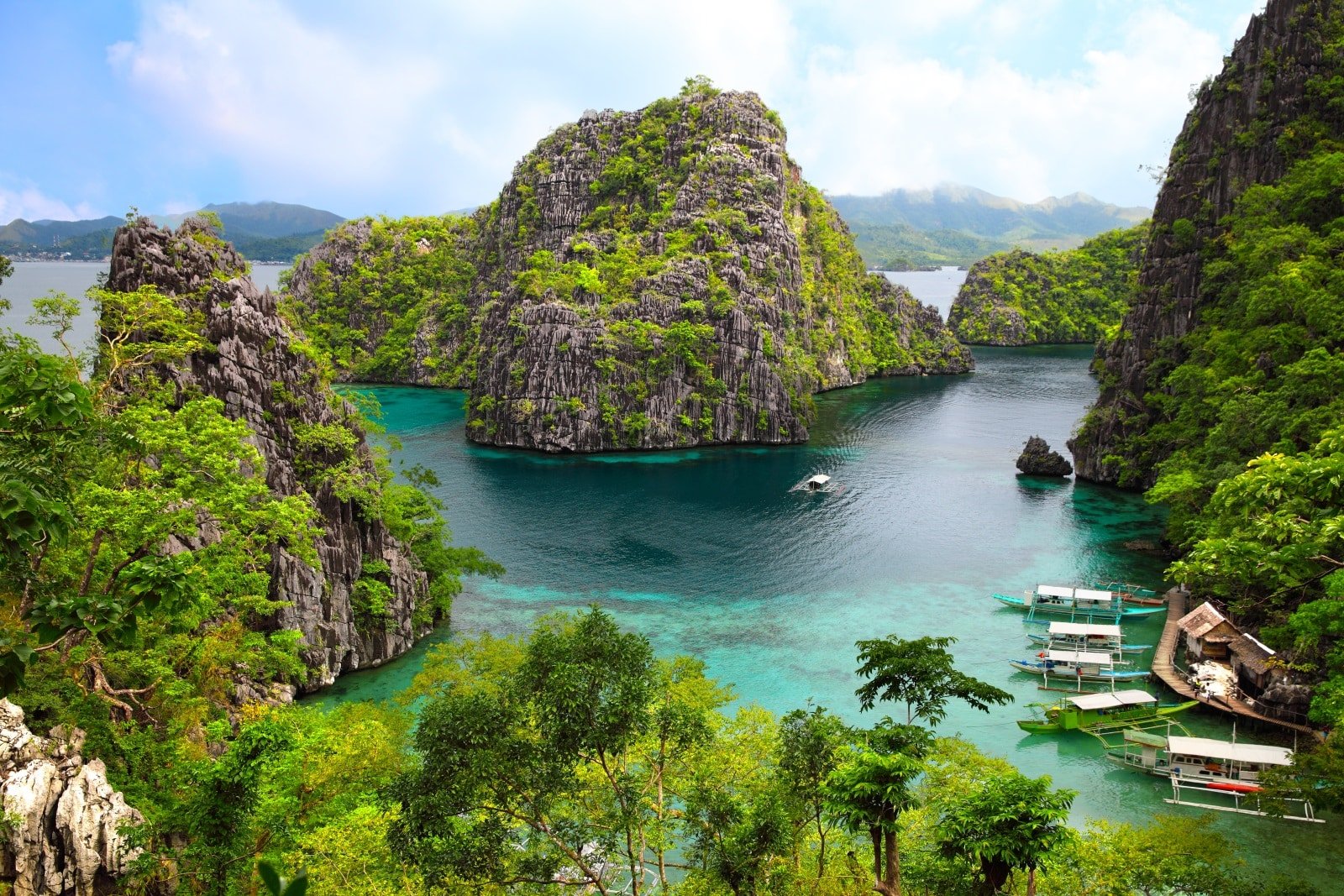
1. Palawan, Philippines
Palawan, the Philippines’ ecological marvel, is a testament to sustainable island living. This lush paradise, with its crystal-clear waters and rich marine life, is a haven for eco-conscious travelers. The island’s efforts in conservation are evident in attractions like the UNESCO-listed Puerto Princesa Subterranean River National Park and the sustainable luxury resorts in El Nido. Community-based tourism initiatives here not only protect the environment but also support local livelihoods. Visitors can engage in snorkeling, island-hopping, and exploring hidden lagoons, all conducted with respect to the natural surroundings.
Insider’s Tip: Engage in community-led tours for an authentic and responsible exploration of the island.
When To Travel: The dry season from November to May offers the best weather.
How To Get There: Fly to Puerto Princesa or El Nido from major cities in the Philippines.

2. Galapagos Islands, Ecuador
The Galapagos Islands, a unique showcase of biodiversity, are a global model for sustainable tourism. The Ecuadorian government and local operators maintain strict controls to preserve the islands’ delicate ecosystems. Visitors can marvel at the unique wildlife and volcanic landscapes while contributing to conservation efforts. The islands offer a range of eco-friendly accommodations and tours that prioritize environmental responsibility. Activities include guided nature walks, snorkeling with sea lions, and observing the famous Galapagos tortoises in their natural habitat.
Insider’s Tip: Opt for smaller, eco-certified cruises to minimize your environmental impact.
When To Travel: Visit from June to December for cooler temperatures and active wildlife.
How To Get There: Fly to Baltra or San Cristobal from mainland Ecuador.
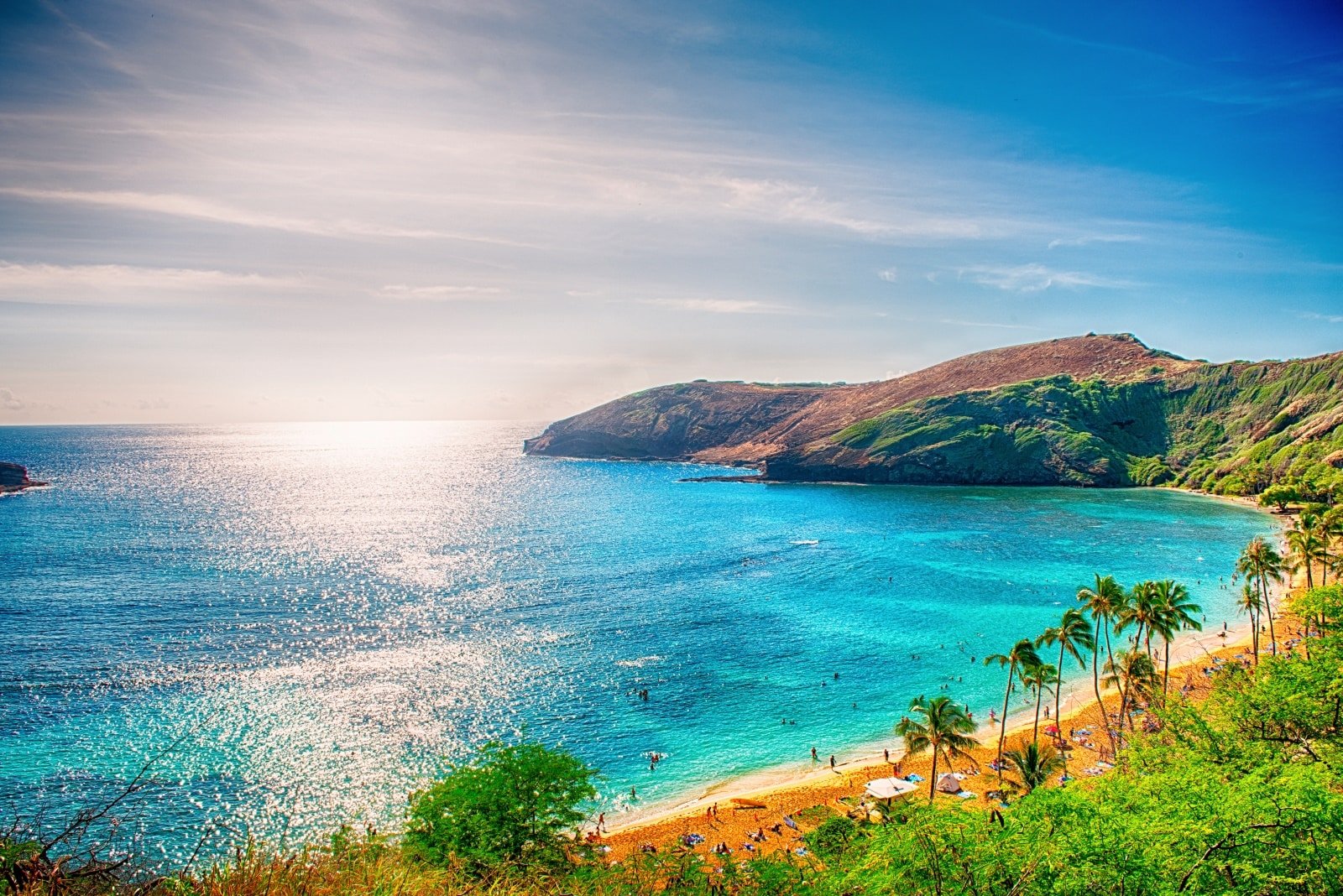
3. Maui, Hawaii, USA
Maui, the second-largest Hawaiian island, is a leader in sustainable tourism practices. The island’s lush landscapes, from the volcanic Haleakal? National Park to the Road to Hana, are maintained through eco-friendly initiatives. Visitors can enjoy organic farm-to-table dining, solar-powered water adventures, and cultural tours that respect the local heritage. Maui’s commitment to preserving its natural and cultural resources makes it a prime destination for eco-conscious travelers. The island’s diverse ecosystems, including rainforests and coral reefs, offer nature enthusiasts a wide range of activities.
Insider’s Tip: Participate in a beach clean-up to give back to the community.
When To Travel: The shoulder seasons of April to May and September to November offer great weather with fewer crowds.
How To Get There: Fly directly to Kahului Airport on Maui.
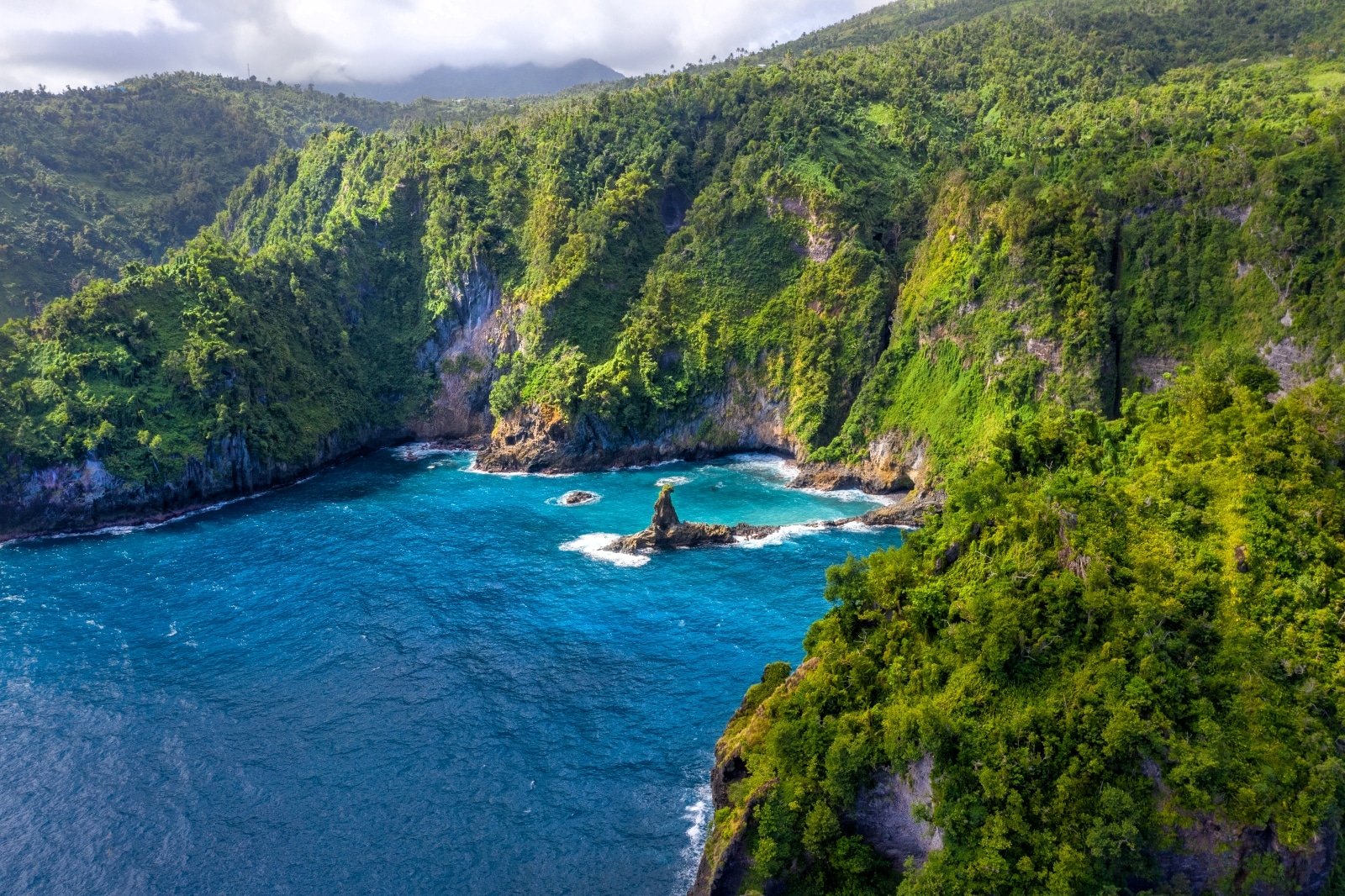
4. Dominica, Caribbean
Dominica stands out in the Caribbean for its commitment to eco-tourism. Known as the “Nature Island,” it boasts lush rainforests, hot springs, and a rich array of wildlife. The island’s eco-lodges and nature tours focus on conservation and community involvement, offering immersive experiences like whale watching and hiking to the Boiling Lake. Dominica’s rugged terrain and natural hot springs provide a unique backdrop for sustainable adventures, from birdwatching to exploring hidden waterfalls.
Insider’s Tip: Explore the island’s unique waterfalls and natural hot springs for a relaxing experience.
When To Travel: The dry season from December to April is ideal for exploring.
How To Get There: Fly to Douglas-Charles Airport, with connections from major Caribbean hubs.
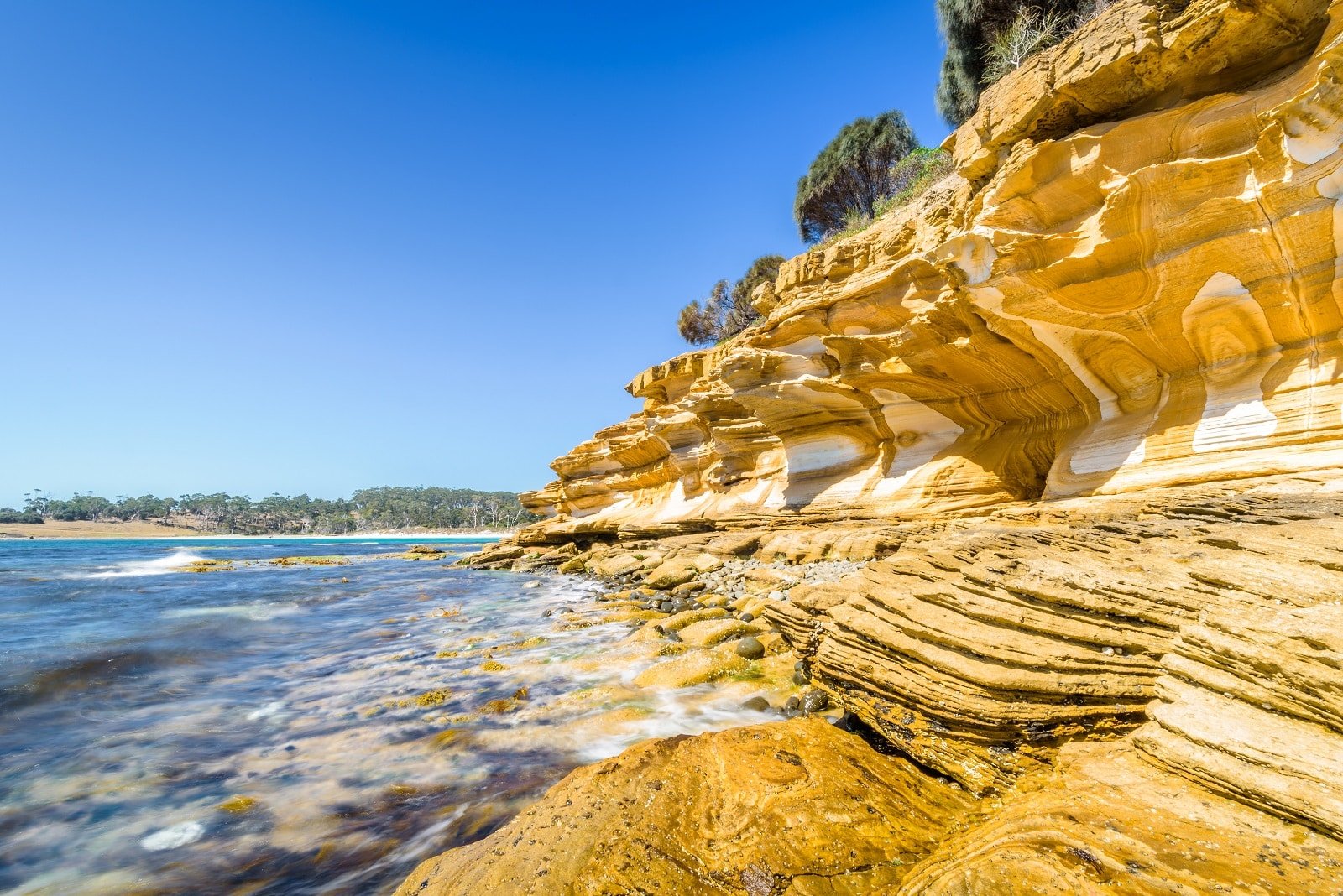
5. Tasmania, Australia
Tasmania, an island state of Australia, is a treasure trove for eco-conscious travelers. Over 40% of its land is protected as national parks and reserves, offering a diverse range of pristine environments. From the rugged wilderness of the Tasmanian Wilderness World Heritage Area to the serene beauty of Wineglass Bay, Tasmania is a haven for nature lovers. The island is committed to sustainable practices, evident in its eco-lodges and conservation projects. Visitors can engage in eco-friendly activities, such as hiking in ancient rainforests, watching wildlife, and exploring the island’s unique geology.
Insider’s Tip: Visit the Tasmanian Devil sanctuaries to learn about conservation efforts for this iconic species.
When To Travel: The summer months of December to February are ideal for outdoor activities.
How To Get There: Fly to Hobart or Launceston from major Australian cities.
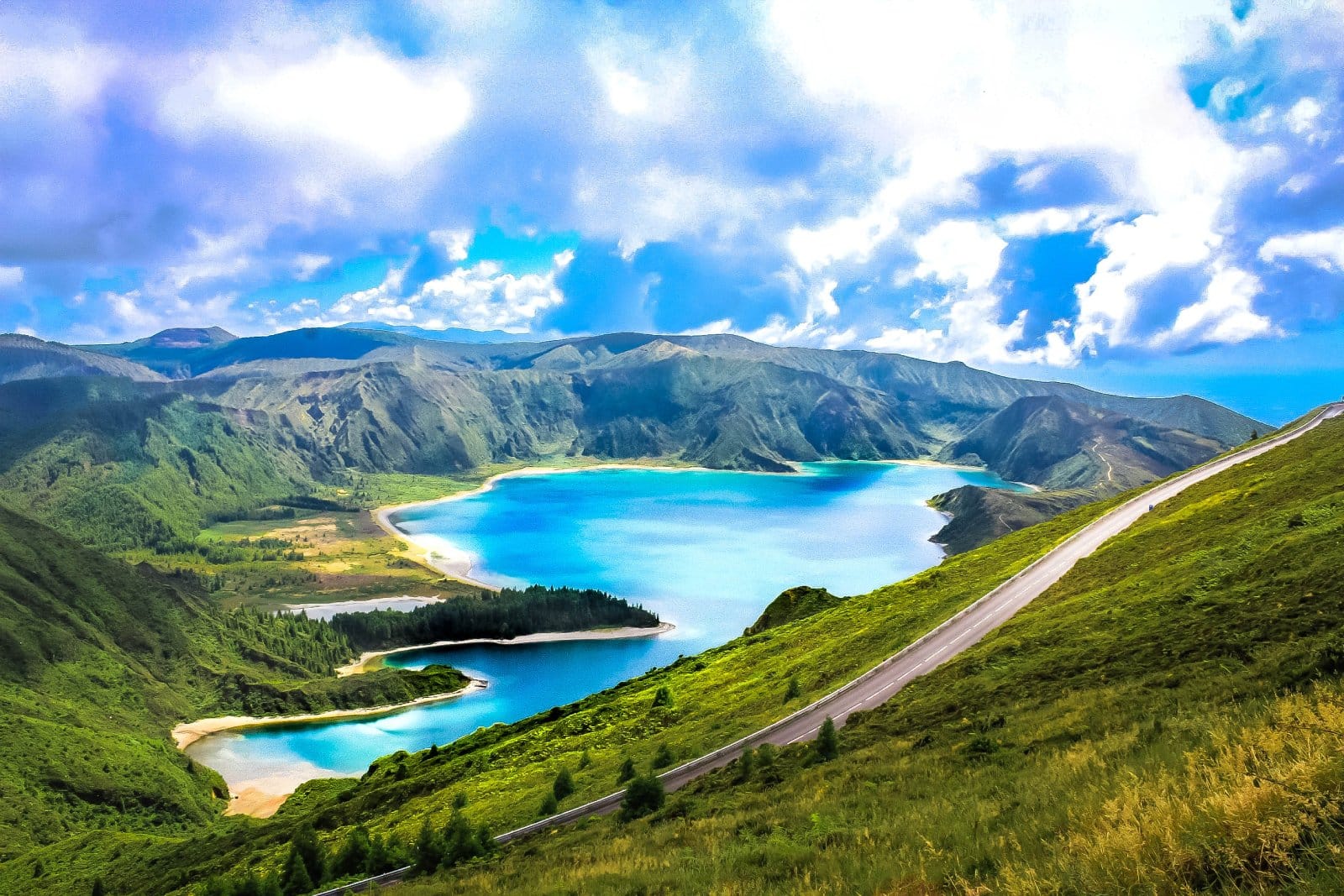
6. Azores, Portugal
The Azores, a group of nine volcanic islands in the North Atlantic, are a model for sustainable tourism. The islands’ stunning landscapes, from green pastures to thermal springs, are complemented by eco-friendly accommodations and activities. Whale watching, hiking, and diving in the Azores not only offer incredible experiences but also support conservation efforts. The islands’ commitment to sustainability includes renewable energy initiatives and the protection of marine life.
Insider’s Tip: Try geothermal cooking, a unique culinary experience on the islands.
When To Travel: Visit from April to October for the best weather and whale-watching opportunities.
How To Get There: Fly to Ponta Delgada on São Miguel Island from Lisbon or other European cities.
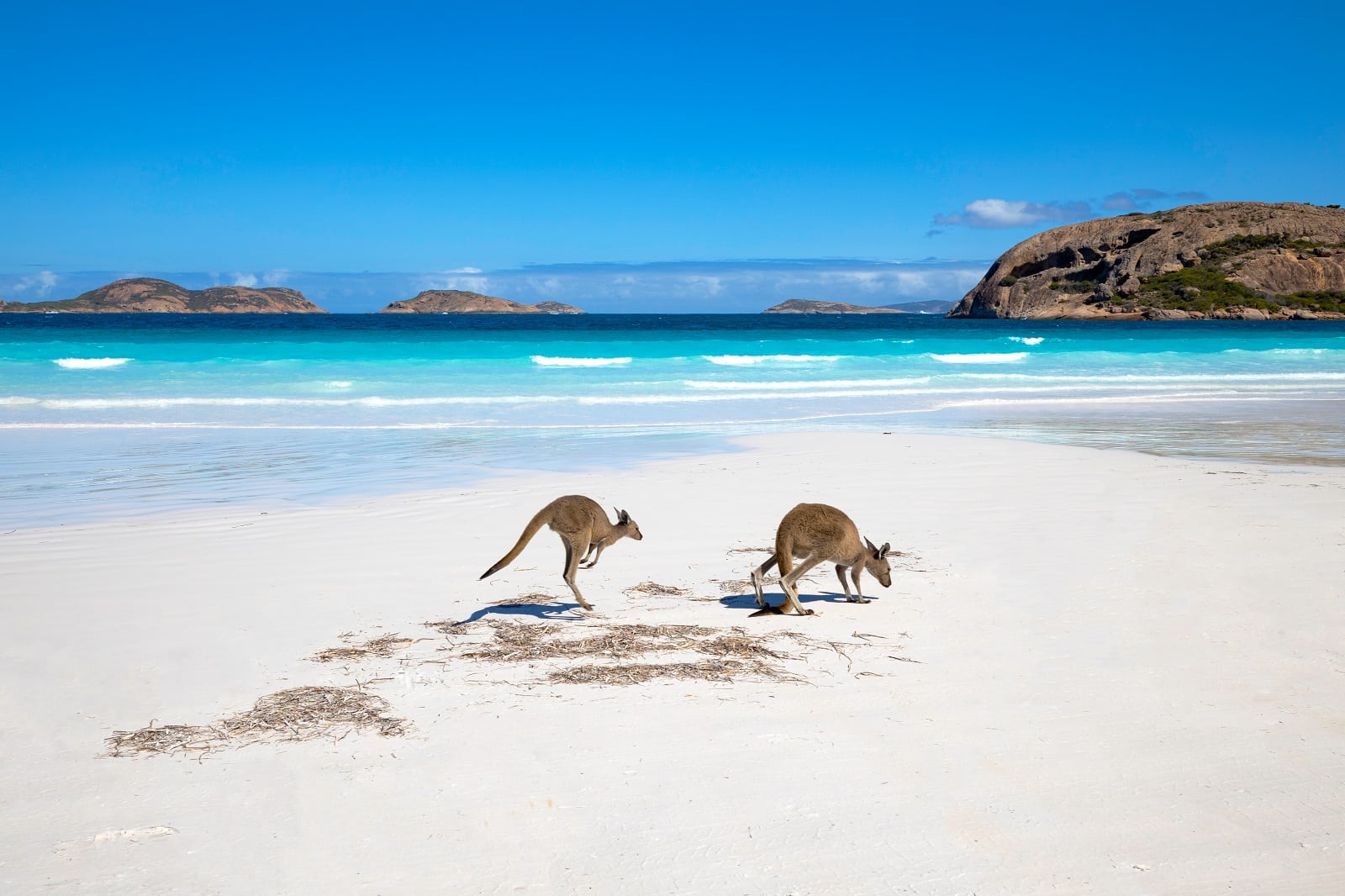
7. Kangaroo Island, Australia
Kangaroo Island, off the coast of South Australia, is a wildlife sanctuary and a leader in sustainable tourism. The island’s diverse habitats are home to many native Australian species, protected through eco-friendly practices. Visitors can enjoy guided wildlife tours, conservation experiences, and stays in eco-lodges. The island offers a unique opportunity to see Australian wildlife in their natural habitat, such as kangaroos, koalas, and echidnas.
Insider’s Tip: Join a nocturnal tour to see the island’s wildlife in their natural habitat, including kangaroos and echidnas.
When To Travel: Visit from September to March for the best wildlife viewing.
How To Get There: Fly to Kingscote Airport on Kangaroo Island or take a ferry from Cape Jervis.
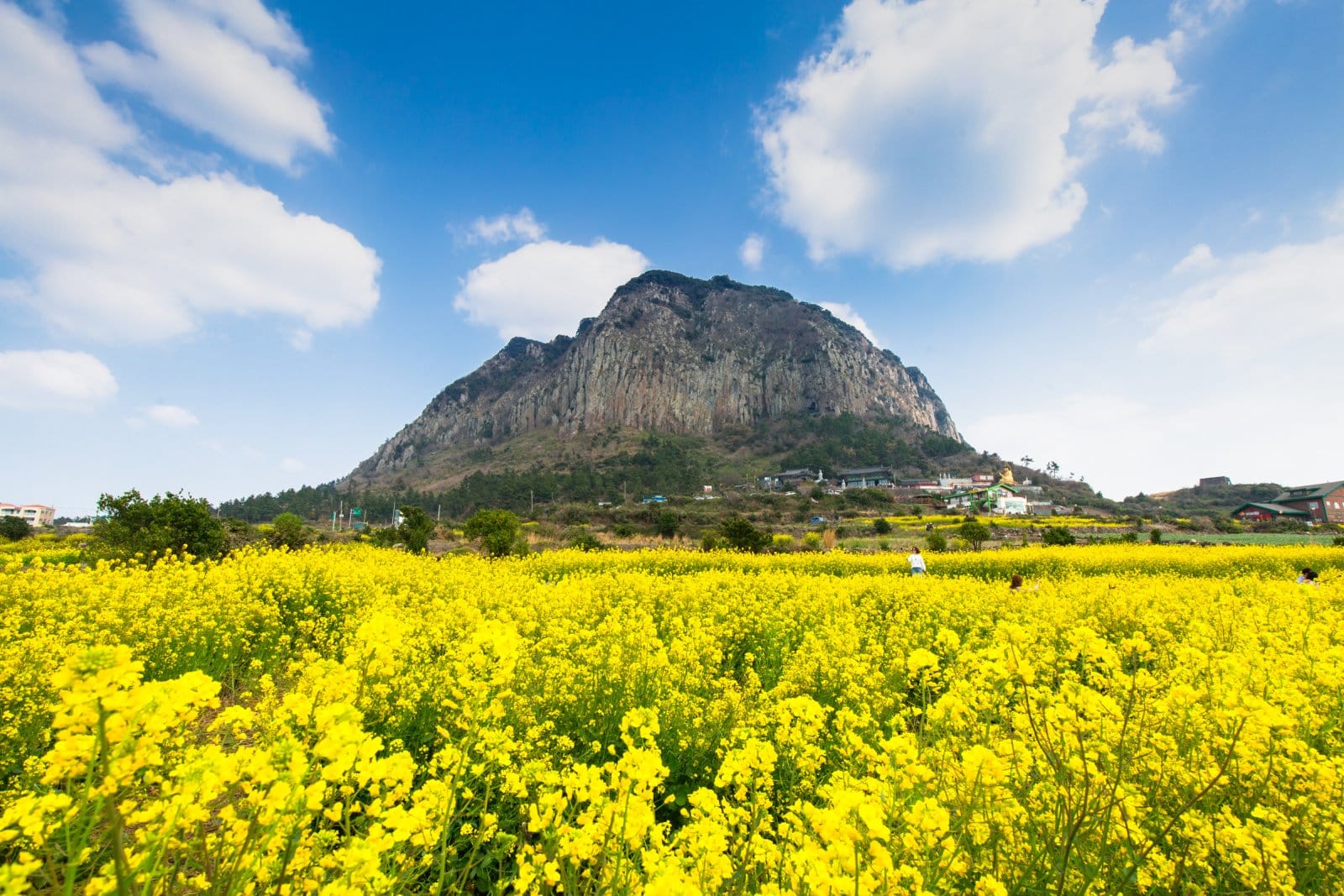
8. Jeju Island, South Korea
Jeju Island, off the southern coast of South Korea, is known for its natural beauty and commitment to sustainability. The island’s UNESCO-listed Geopark showcases unique volcanic landscapes, waterfalls, and beaches. Eco-friendly initiatives across the island promote sustainable agriculture and tourism, making it a great destination for environmentally-conscious travelers. Activities include exploring lava tubes, hiking up Hallasan Mountain, and visiting traditional Korean villages.
Insider’s Tip: Explore the island’s lava tubes and craters for a unique geological experience.
When To Travel: Spring (April to June) is ideal for mild weather and beautiful cherry blossoms.
How To Get There: Fly to Jeju International Airport from various cities in South Korea and Asia.
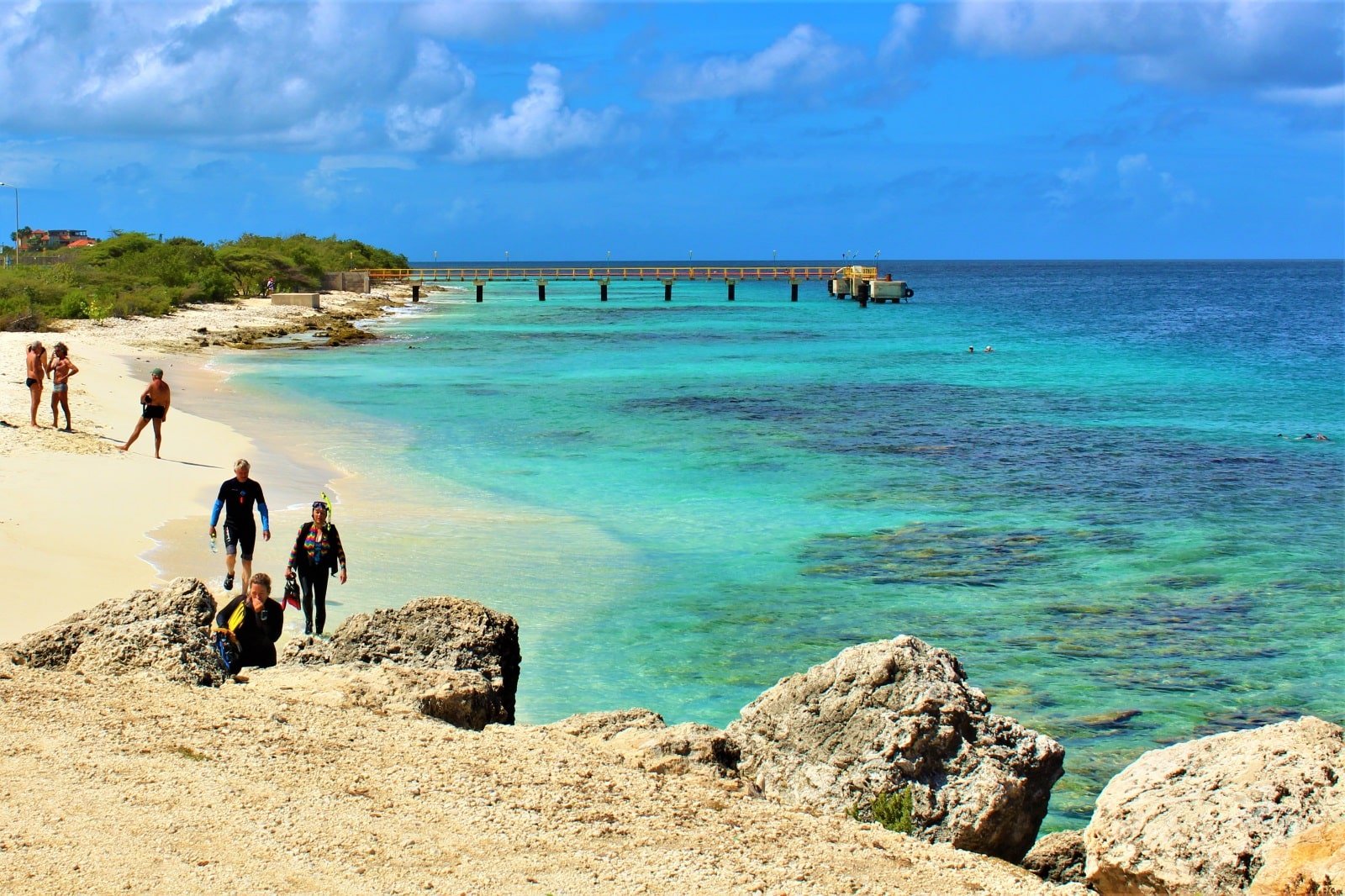
9. Bonaire, Caribbean
Bonaire, part of the Dutch Caribbean, is a pioneer in marine conservation. The island’s surrounding waters are a protected marine park, offering some of the best diving and snorkeling experiences in the Caribbean. Sustainable practices on land and sea make Bonaire a top choice for eco-friendly island travel. Visitors can enjoy activities like windsurfing, kitesurfing, and exploring the island’s unique flora and fauna.
Insider’s Tip: Try windsurfing or kitesurfing in Lac Bay, known for its ideal conditions.
When To Travel: Visit year-round, with the best diving conditions from April to October.
How To Get There: Fly to Flamingo International Airport on Bonaire from the United States, Europe, or other Caribbean islands.
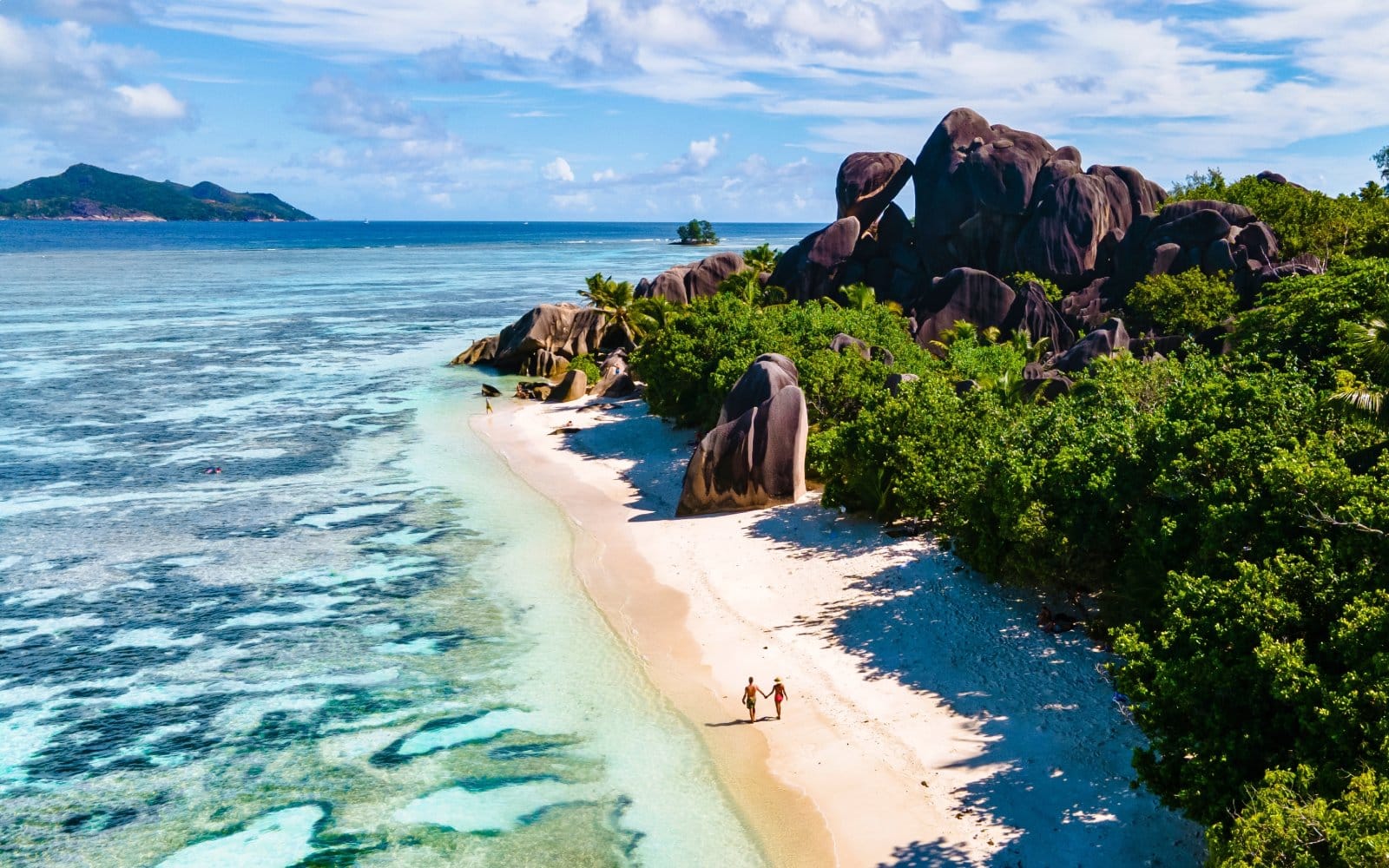
10. Seychelles
The Seychelles, an archipelago in the Indian Ocean, is a leader in environmental conservation. The islands offer stunning beaches, coral reefs, and nature reserves. Sustainable tourism practices here include eco-lodges, marine conservation projects, and guided nature tours. The Seychelles’ commitment to preserving its natural and cultural heritage makes it an ideal destination for responsible travelers.
Insider’s Tip: Visit Vallee de Mai on Praslin Island, a UNESCO World Heritage Site, to see the rare Coco de Mer palm.
When To Travel: April to May and October to November offer calm seas and pleasant weather.
How To Get There: Fly to Seychelles International Airport on Mahé Island from major international hubs.
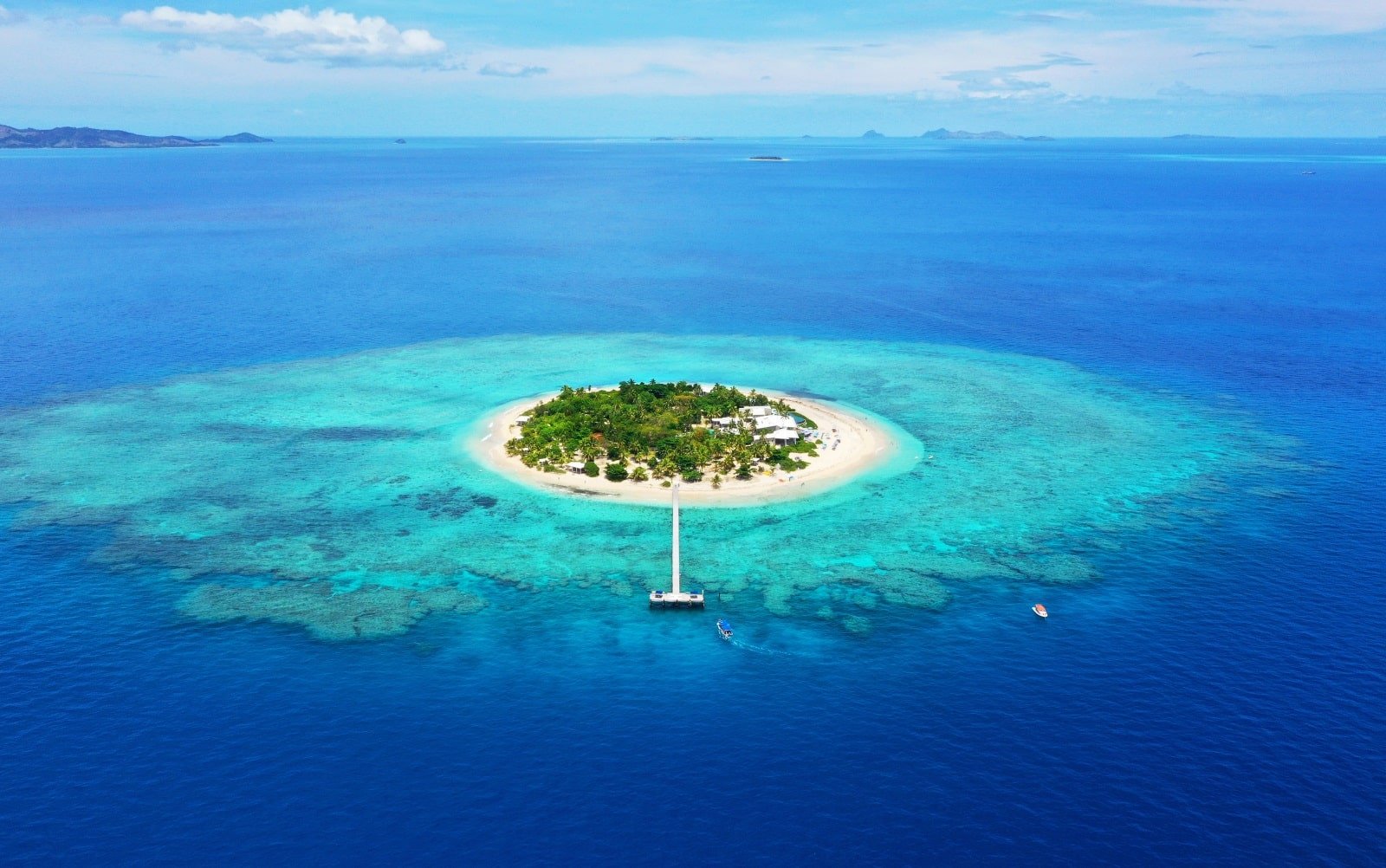
Fiji, an archipelago in the South Pacific, is renowned not just for its breathtaking coral reefs and warm hospitality but also for its dedication to sustainable tourism. The islands are a paradise for eco-conscious travelers, offering a variety of eco-friendly resorts and activities that range from diving in vibrant coral reefs to engaging in cultural tours and participating in conservation initiatives.
Fiji’s commitment to sustainable practices ensures that your visit contributes positively to the local communities and the preservation of the environment. The islands’ lush landscapes and clear waters provide the perfect setting for various activities, including kayaking, snorkeling, and exploring traditional Fijian villages. Engaging with the local community and participating in environmental conservation projects offer a deeper understanding and appreciation of Fiji’s natural beauty and cultural richness.
Insider’s Tip: Participate in a reef conservation project for a hands-on experience in marine preservation.
When To Travel: The best time to visit is during the dry season, from May to October.
How To Get There: Fly to Nadi International Airport on Fiji’s main island, Viti Levu.

12. Isle of Skye, Scotland
The Isle of Skye, located off the west coast of Scotland, is a destination that captivates with its dramatic landscapes and rich cultural heritage. Known for its rugged coastlines, mystical mountain ranges like the Cuillins, and historical sites such as medieval castles, Skye is a haven for outdoor enthusiasts and history buffs alike. The island’s commitment to eco-friendly tourism is evident in its sustainable accommodations and practices that aim to preserve the natural environment.
Visitors can immerse themselves in the island’s beauty through activities like hiking, wildlife watching, and exploring the local folklore and traditions. The Isle of Skye’s enchanting scenery, from the famous Fairy Pools to the Old Man of Storr, offers endless opportunities for sustainable exploration and adventure.
Insider’s Tip: Visit the Fairy Pools, a series of clear, cold pools and waterfalls in the Cuillins.
When To Travel: May to September offers the best weather for outdoor activities.
How To Get There: Drive or take a bus from mainland Scotland to the Isle of Skye.
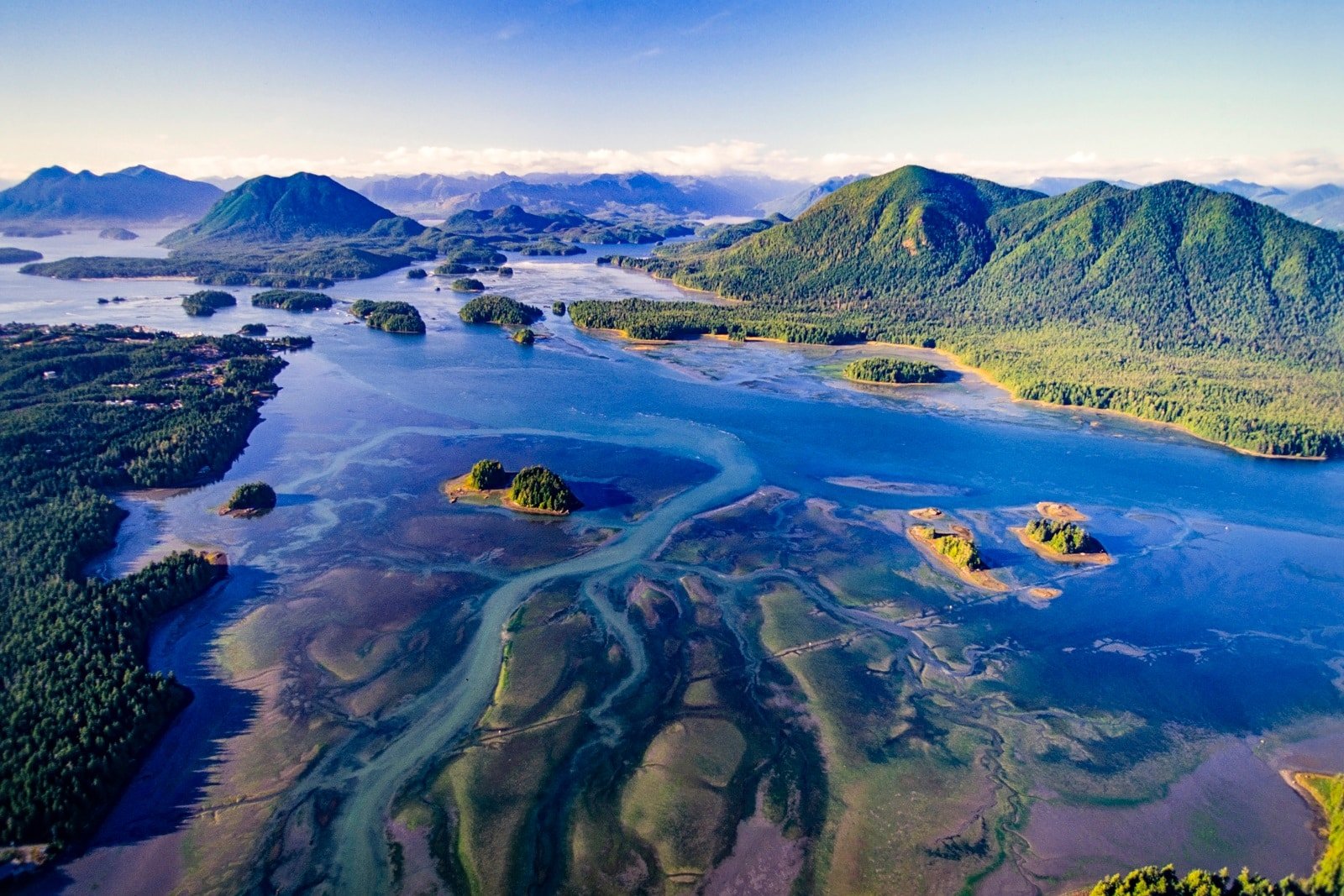
13. Vancouver Island, Canada
Vancouver Island, off Canada’s Pacific Coast, is a diverse ecosystem ranging from temperate rainforests to rugged beaches and mountainous terrain. The island is a model for sustainable tourism, offering a range of eco-friendly activities and experiences. Visitors can explore ancient forests, such as those in Cathedral Grove, go whale watching in the Pacific waters, or learn about the rich indigenous cultures of the island.
Vancouver Island’s commitment to environmental stewardship is evident in its conservation efforts and promotion of sustainable practices among local businesses and communities. The island provides a perfect blend of adventure and relaxation, with opportunities for hiking, kayaking, and enjoying the local culinary scene while focusing on ecological responsibility.
Insider’s Tip: Explore the island’s west coast for incredible wildlife viewing, including bears and whales.
When To Travel: Visit from June to September for the best weather and wildlife viewing.
How To Get There: Fly to Victoria International Airport or take a ferry from Vancouver.
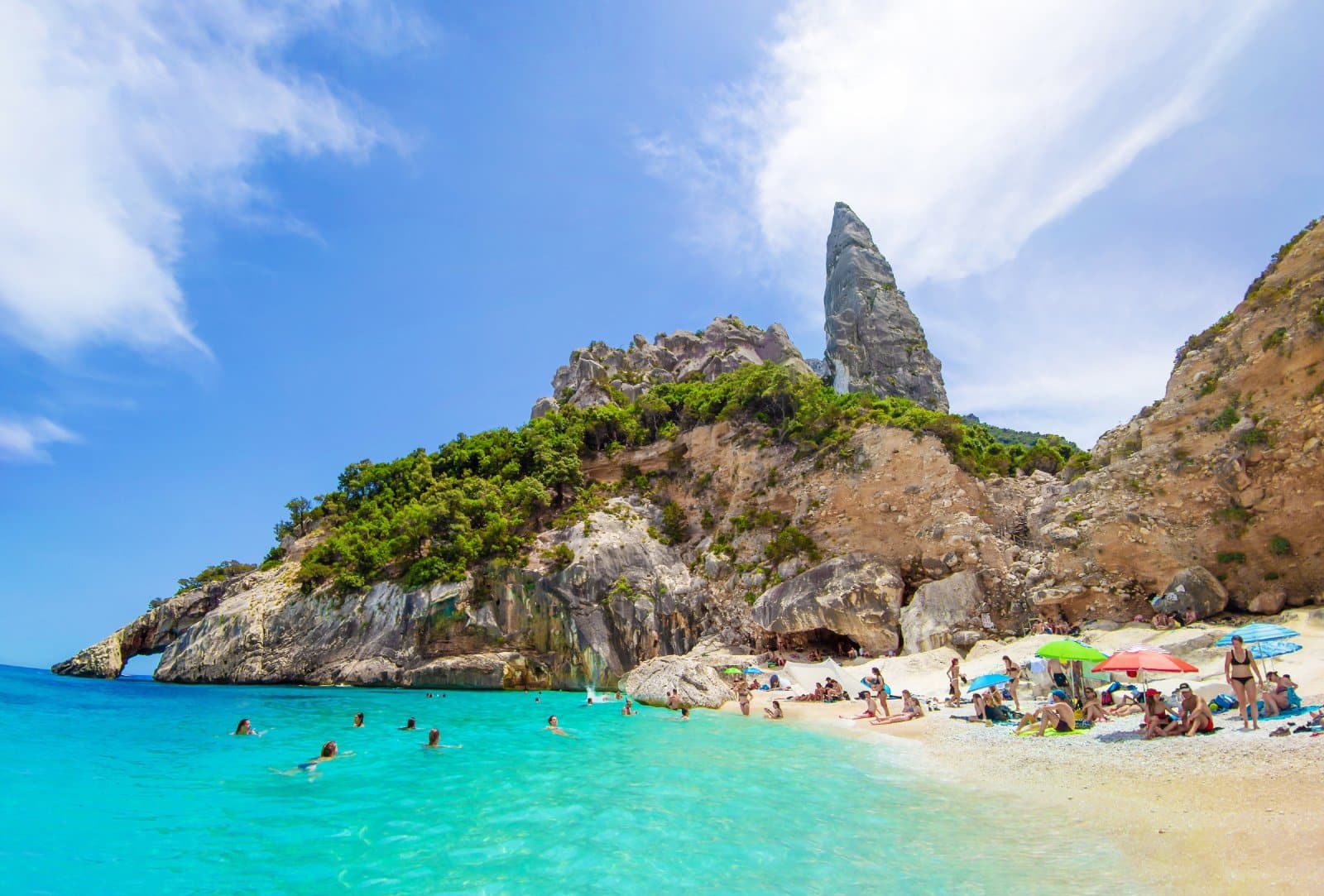
14. Sardinia, Italy
Sardinia, nestled in the Mediterranean Sea, is an island that offers more than just stunning beaches and crystal-clear waters. It is where the preservation of natural landscapes and cultural heritage is paramount. Visitors to Sardinia can enjoy sustainable agritourism, explore archaeological sites like the Nuraghe, and hike in the island’s rugged interior.
The island’s approach to tourism balances enjoyment with conservation, ensuring its beauty is maintained for future generations. Sardinia’s diverse landscape, from the Costa Smeralda to the mountainous Barbagia region, provides a range of activities for travelers, including horseback riding, wine tasting, and discovering the unique traditions and crafts of the local communities.
Insider’s Tip: Visit the Nuraghe, ancient megalithic edifices, to glimpse Sardinia’s past.
When To Travel: April to June and September to October offer pleasant weather and fewer crowds.
How To Get There: Fly to Cagliari, Olbia, or Alghero airports from major European cities.
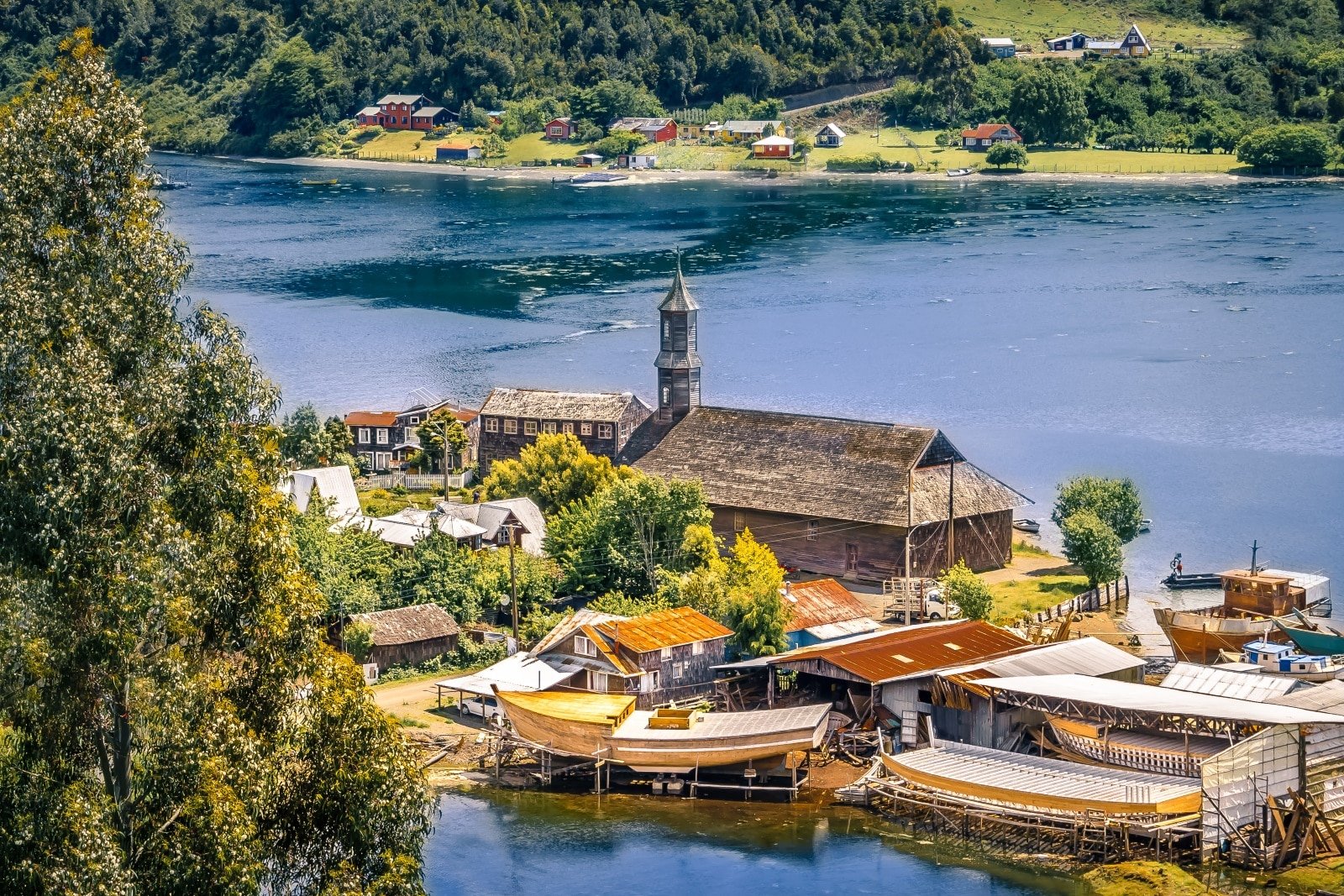
15. Chiloé Island, Chile
Chiloé Island, located in the southern region of Chile, is where myth and tradition blend seamlessly with the natural environment. Known for its distinctive wooden churches and rich folklore, Chiloé is committed to sustainable tourism practices. The island’s cultural heritage is deeply connected to its natural surroundings, offering visitors a chance to experience both.
Eco-friendly accommodations and activities such as bird watching, hiking, and exploring the island’s national parks are popular among travelers. The island’s cuisine, particularly its seafood and unique dishes like curanto, reflects its sustainable relationship with the sea and land. Chiloé’s rolling hills, dense forests, and coastal landscapes provide a tranquil setting for a sustainable and culturally enriching getaway.
Insider’s Tip: Try curanto, a traditional Chilote dish, to taste local cuisine.
When To Travel: The best time to visit is during the summer months of December to March.
How To Get There: Fly to Puerto Montt and then take a ferry to Chiloé Island.

The Bottom Line
Embarking on a sustainable island getaway allows you to responsibly enjoy some of the world’s most beautiful destinations. These eco-friendly islands offer breathtaking natural beauty and a commitment to preserving their environment and culture. Whether you’re snorkeling in Fiji’s coral reefs, exploring the ancient landscapes of Sardinia, or immersing yourself in the unique culture of Chiloé, your journey will contribute to the sustainability of these incredible places. As you plan your next island adventure, remember that your choices can help preserve these paradises for future generations.
More Articles Like This…
Barcelona: Discover the Top 10 Beach Clubs
2024 Global City Travel Guide – Your Passport to the World’s Top Destination Cities
Exploring Khao Yai 2024 – A Hidden Gem of Thailand
The post 15 Eco-Islands 2024 – Sustainable Island Retreats republished on Passing Thru with permission from The Green Voyage .
Featured Image Credit: Shutterstock / Grekov’s.
For transparency, this content was partly developed with AI assistance and carefully curated by an experienced editor to be informative and ensure accuracy.
More for You
Russia's 'Mobile Fire Groups' Hint at Deeper Problem: ISW
‘I have no time for foolishness’: Maryland Gov. on some in GOP blaming bridge collapse on diversity policies
Are eggs bad for cholesterol? New study reveals how many you can eat
What Is Kölsch Beer And What Makes It Unique?
I’ve Worked on Cruise Ships for 10 Years—These Are 18 Mistakes Every Traveler Should Avoid
6 Cars That Seem Expensive but Rarely Need Repairs
Major storm to sweep United States with severe weather, snow, flooding
7 Designer Bags That Will Never Go Out of Style
What Happens to Your Body When You Eat Blueberries Every Day
Lizzo’s music is a joyous tonic – her decision to quit the industry is our loss
Don’t pack these 9 TSA-prohibited items in your checked baggage
35 Cheapest Beach Towns You Can Afford To Live In
A Federal Judge Made a Rare TV Appearance to Condemn Trump's Comments About Judge Juan Merchan
The 9 Most Comfortable Flats to Wear Instead of Sneakers
Toby Keith: 12 Essential Songs
Cherokee Nation wants federal law fix on Black tribal citizens
Is It Safe to Eat Raw Oats? Here's What Dietitians Say
You Shouldn’t Be Able to Pay With Cash OR a Card at a National Park. They Should Be Free.
Why So Many Young Men Are Abandoning College Degrees
Laminate Countertops Are Making a Comeback—Formica's New Line Proves It

IMAGES
COMMENTS
World's best unique & underrated travel destinations. # Bosnia & Herzegovina # Colombia # Greece # Mauritius # Morocco # Oman # Spain # Taiwan # Timor. Discover the best cultural trips our world has to offer. From India to the Arctic, here are the 30 best countries and regions for cultural tourism.
Cultural tourism is a rapidly growing segment within the global travel industry, catering to individuals seeking to immerse themselves in local populations' customs, traditions, and lifestyles. It combines the elements of leisure with an authentic experience of a destination's unique historical, architectural, artistic, and culinary aspects.
The Meenakshi Temple in Madurai is the epitome of beauty and architecture and a must-visit for cultural buffs. Khajuraho, a UNESCO World Heritage Site in Madhya Pradesh beautifully mirrors the art and creativity of ancient India. One of a kind in the world! Kerala is a melting pot of different cultures and traditions.
Heritage tourism. Cultural heritage tourism is a form of non-business travel whereby tourists engage with the heritage, tangible and intangible, moveable and immovable, of a region through activities, experiences, and purchases which facilitate a connection to the people, objects, and places of the past associated with the locations being ...
The relationship between World Heritage and tourism is two-way: a. World Heritage offers tourists/visitors and the tourism sector destinations. b. Tourism offers World Heritage the ability to meet the requirement in the Convention to 'present' World Heritage properties, and also a means to realise community and economic benefits through ...
To some extent, cultural tourism research has already spawned a number of extremely fruitful sub-sectors, such as cultural heritage tourism, film-induced tourism and literary tourism. ... Cultural planning and creative tourism in an emerging tourist destination. International Journal of Management Cases, 13 (3) (2011), pp. 629-636.
The World Tourism Organisation (WTO) (1985) broadly define cultural tourism as the movements of persons who satisfy the human need for diversity, tending to raise the cultural level of the individual and giving rise to new knowledge, experience and encounters. Cultural tourism is commonly associated with education in this way, some describing ...
Cultural tourism in Egypt in the 19th century. Tourists at Hearst Castle, California. Tourists taking pictures at the khmer Pre Rup temple ruins, an example of cultural tourism.. Cultural tourism is a type of tourism activity in which the visitor's essential motivation is to learn, discover, experience and consume the tangible and intangible cultural attractions/products in a tourism destination.
This webpage provides UN Tourism resources aimed at strengthening the dialogue between tourism and culture and an informed decision-making in the sphere of cultural tourism. It also promotes the exchange of good practices showcasing inclusive management systems and innovative cultural tourism experiences.. About Cultural Tourism. According to the definition adopted by the UN Tourism General ...
Each year, millions of travelers visit America's historic places. The National Trust for Historic Preservation defines heritage tourism as "traveling to experience the places, artifacts, and activities that authentically represent the stories and people of the past and present." A high percentage of domestic and international travelers participate in cultural and/or heritage activities ...
Cultural tourism is: "A type of tourism activity in which the visitor's essential motivation is to learn, discover, experience and consume the tangible and intangible cultural attractions/products in a tourism destination. These attractions/products relate to a set of distinctive material, intellectual, spiritual and emotional features of a ...
Cultural and heritage tourism offers a deeper perspective, allowing travelers to not just visit a place, but to truly immerse in its essence. This form of tourism revolves around the stories, customs, and monuments that have shaped nations for centuries. The Tapestry of Traditions. Every corner of the world has a story to tell, a history to share.
The link between culture and tourism, founding cultural tourism, enhances the cultural content of the space, the tourist experience, and identity differentiation, in an increasingly fragmented and competitive environment. A historical-conceptual approach identified with the dynamics of cultural heritage and cultural tourism is proposed ...
Cultural and heritage tourism: an introduction by Dallen J. Timothy, Bristol, UK, Channel View Publications, 2020, 576 pp., $149.95 (hardback), ISBN: 978184541771 Deepak Chhabra School of Community Resources and Development, Arizona State University, 411 North Central Avenue, Phoenix, AZ85004, USA Correspondence [email protected]
By 2018, 40 tourism destinations in China had been included in the World Cultural Heritage List, and world cultural heritage has increasingly become one of the most popular tourist attractions. As the crystallization of the development of human society, world cultural heritage sites are a combination of local characteristics, customs, arts ...
significant impacts of tourism upon various aspects of a destination's culture. Concerns over. respect, asset preservation, damage to assets (du Cros & Mckercher, 2015), loss of native. language ...
The nature of the partnership between tourism and cultural heritage management is discussed in this chapter. Ideally, sustainable cultural tourism should involve a partnership that satisfies both tourism and cultural heritage management stakeholders. ... as well as destination level. UNESCO's use of a travel pledge to engage tourism and ...
Destination Culture takes the reader on an eye-opening journey from ethnological artifacts to kitsch. Posing the question, What does it mean to show? Barbara Kirshenblatt-Gimblett explores the agency of display in a variety of settings: museums, festivals, world's fairs, historical re-creations, memorials, and tourist attractions. She talks about how objects--and people--are made to perform ...
There are four latent factors included in the model: Tourist Destination, Cultural Offer, City Services and Tourist Motivations. </abstract> ... McKercher B, Ho P, du Cros H (2005) Relationship between tourism and cultural heritage management: Evidence from Hong Kong. Tourism Manage 26: 539-548. doi: 10.1016/j.tourman.2004.02.018
This study researches the loyalty of travelers to destinations which include material cultural heritage. It analyzes the loyalty of visitors to a destination with cultural heritage sites in order to provide results which can be used to improve the management of the destination. This research used Warp-PLS 7.0 software with a structural equations model to evaluate the 8 proposed and validated ...
Through in-depth face-to-face interviews with 29 tourists in the cultural sites of Paris, a theoretical model of memorable cultural tourism experiences (MCTEs) was developed and six key factors affecting cultural tourist experiences in a destination have emerged using a grounded theory approach: prior perceived significance of the experience ...
The primary focus of this tool to attract. visitors is "cultural and heritage tourism.". Community Vitality: There is broad agreement that cultural resources generate. economic v itality by ...
In addition, the Tourism Act of 2009 sets aside 5% of total travel tax collection for the development of historic, cultural, religious and heritage sites and prime tourist destinations. In summary, tourism has been a powerful force in heritage-making, and the state has not been a passive actor in the process.
The 31st edition of SATTE (South Asia Trade Travel Exhibition) in Greater Noida wrapped up recently. The exhibition focused on the theme of "Inclusive and Sustainable Tourism,'' and attracted representatives from tourism and trade sectors worldwide. During the three-day event, Outlook Traveller had a conversation with Arvind Bundhun, Director of the Mauritius Tourism Promotion Authority, to ...
(VOVWORLD) - The Ha Giang International Culture, Tourism and Cuisine Festival opened in Ha Giang city on Friday to promote cultural, tourism and culinary values and introduce local tourist destinations. The unique dishes of Ha Giang ethnic people introducing at the International Culture, Tourism and ...
Known for its distinctive wooden churches and rich folklore, Chiloé is committed to sustainable tourism practices. The island's cultural heritage is deeply connected to its natural surroundings ...